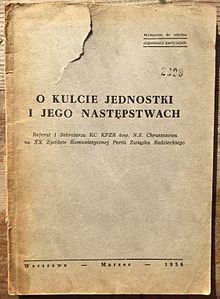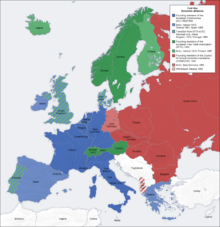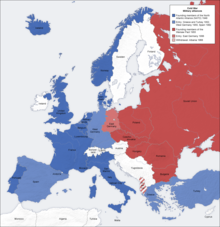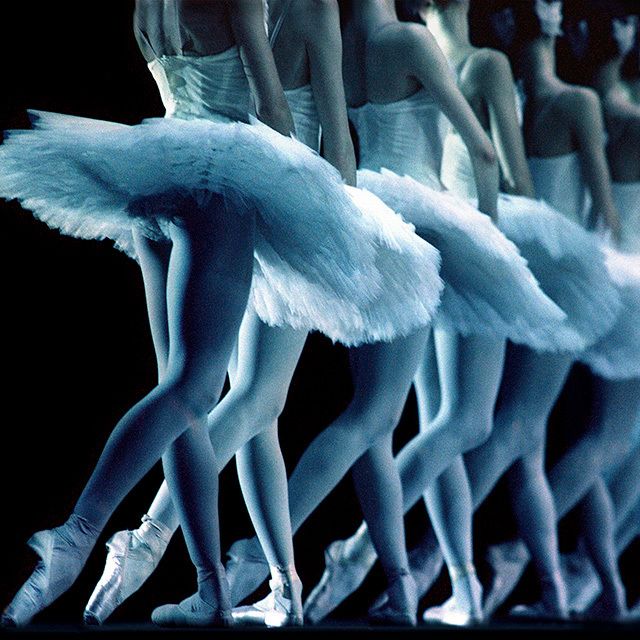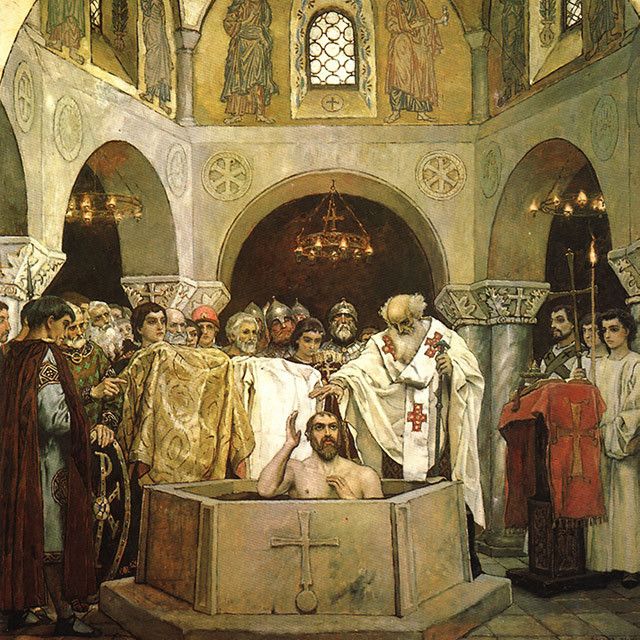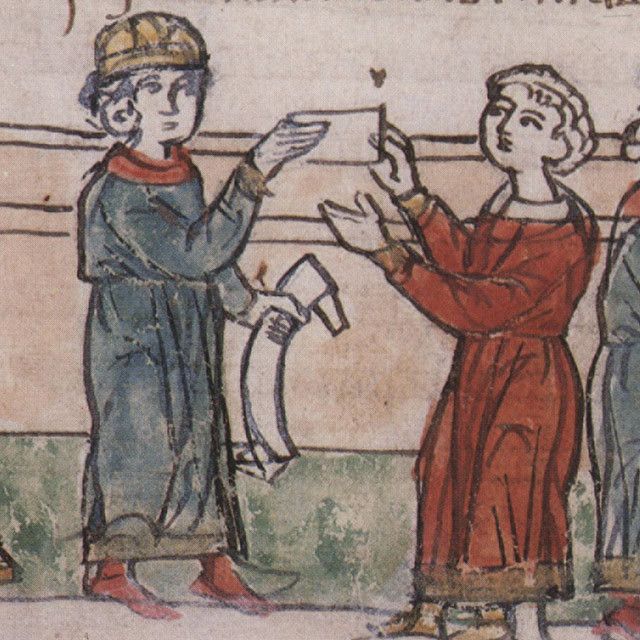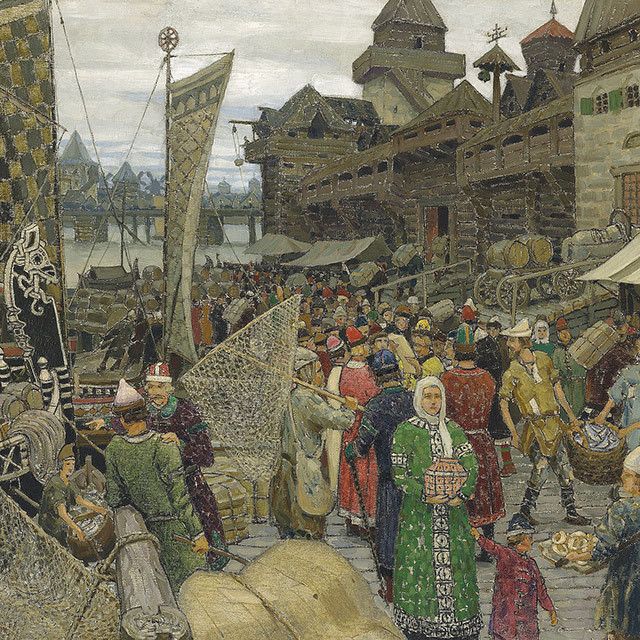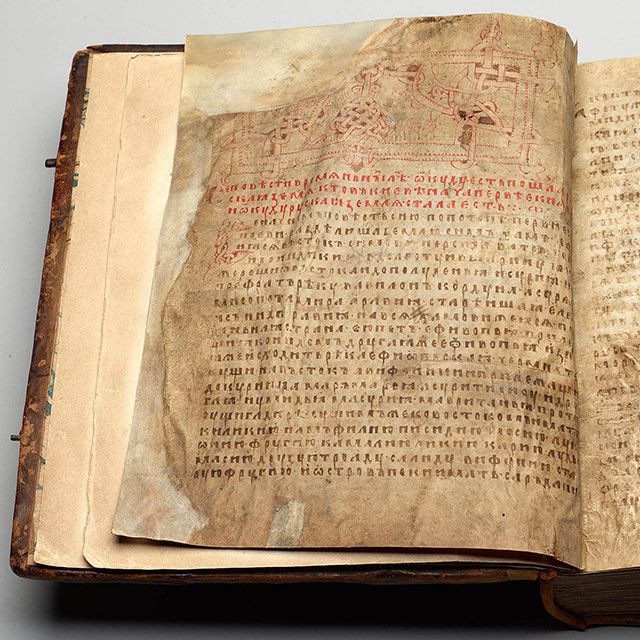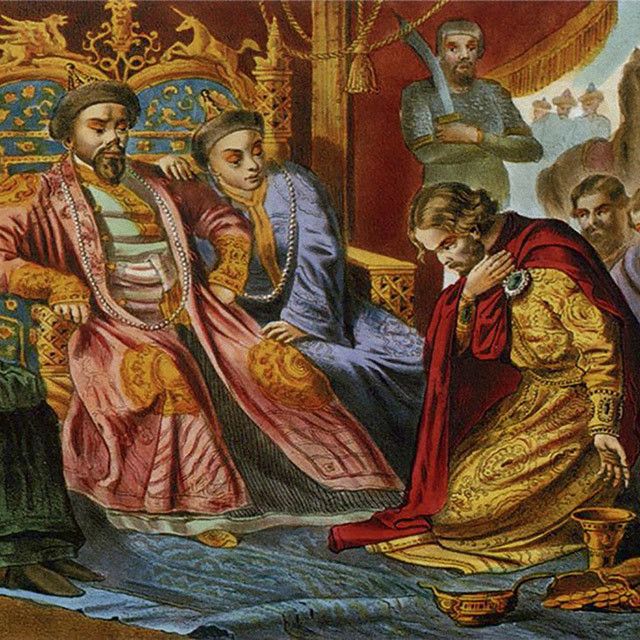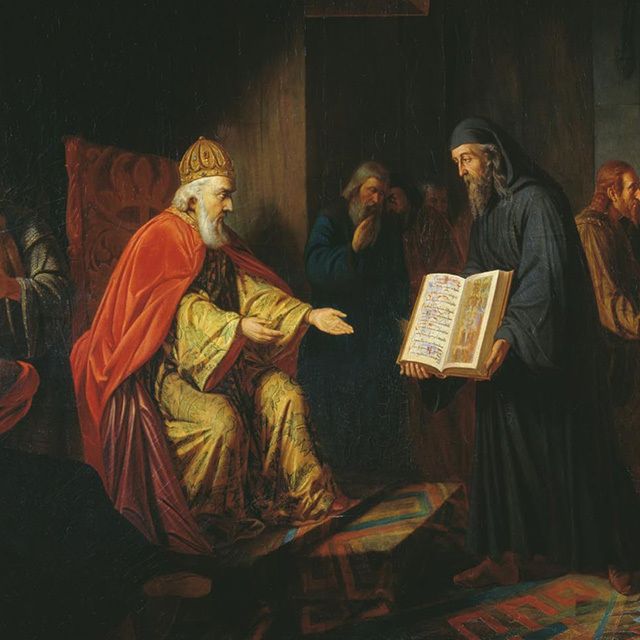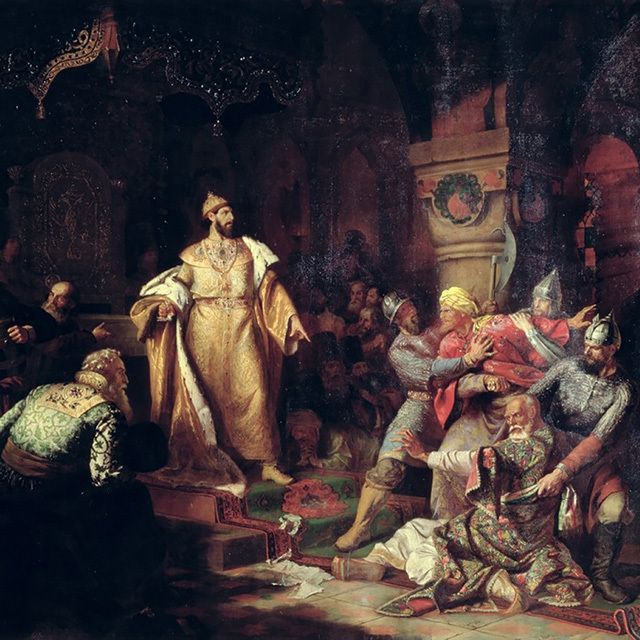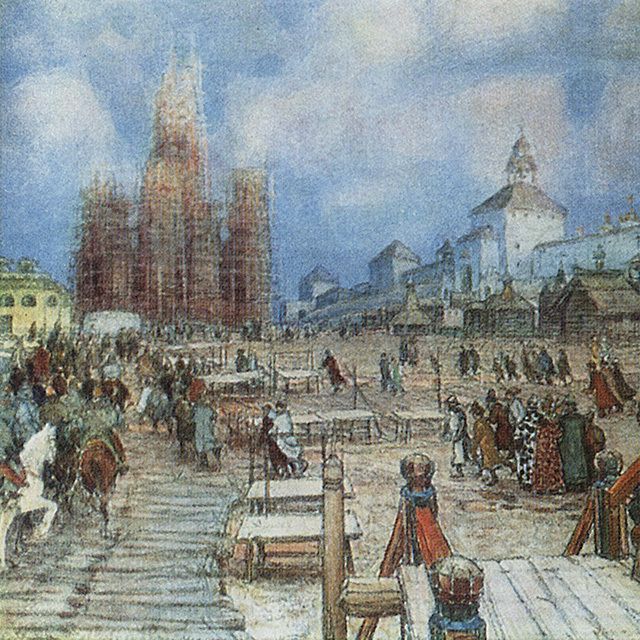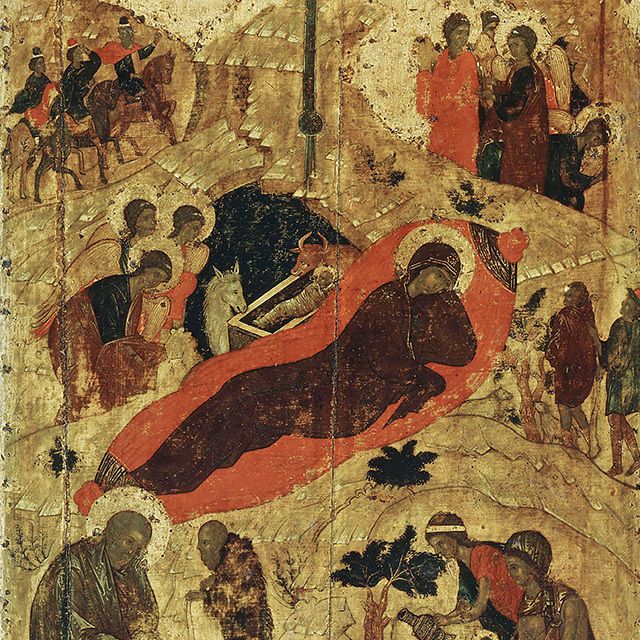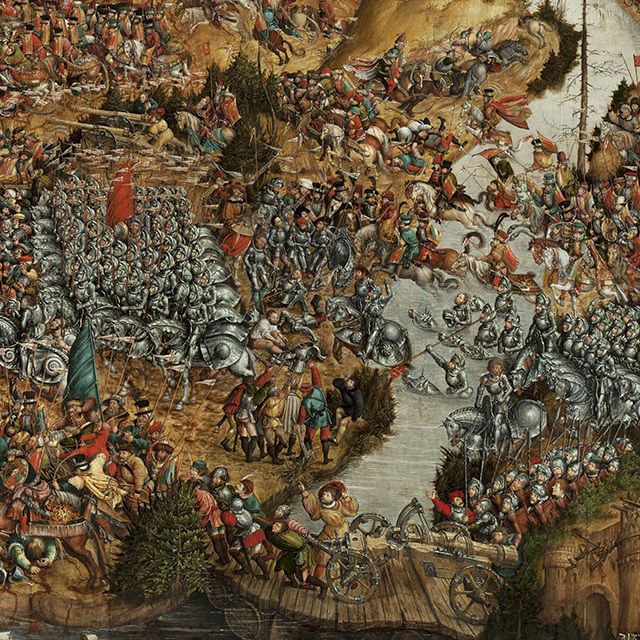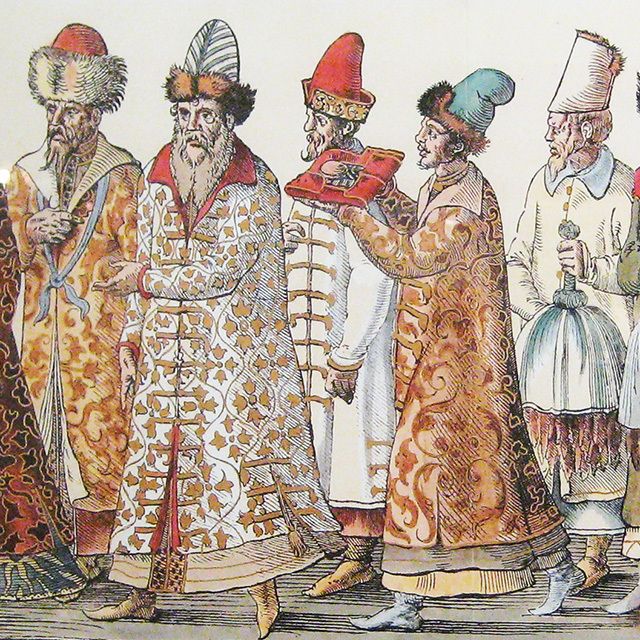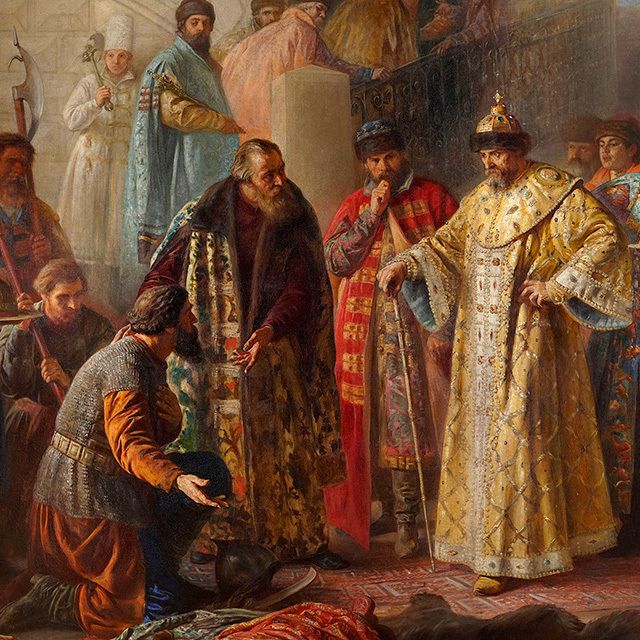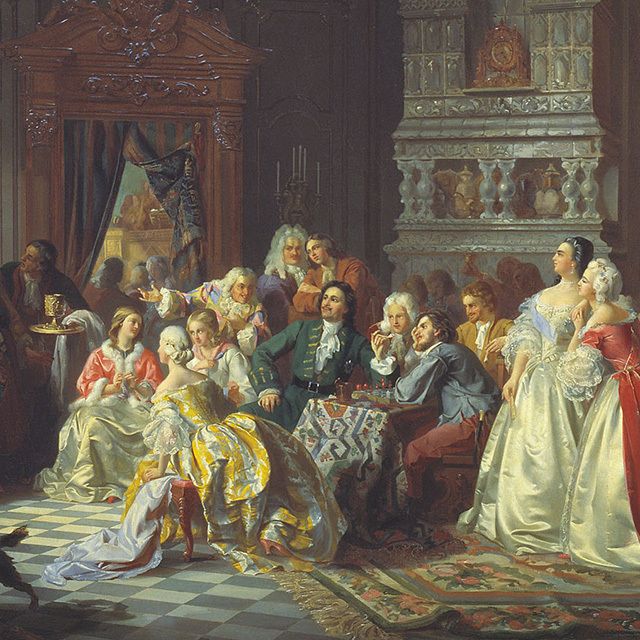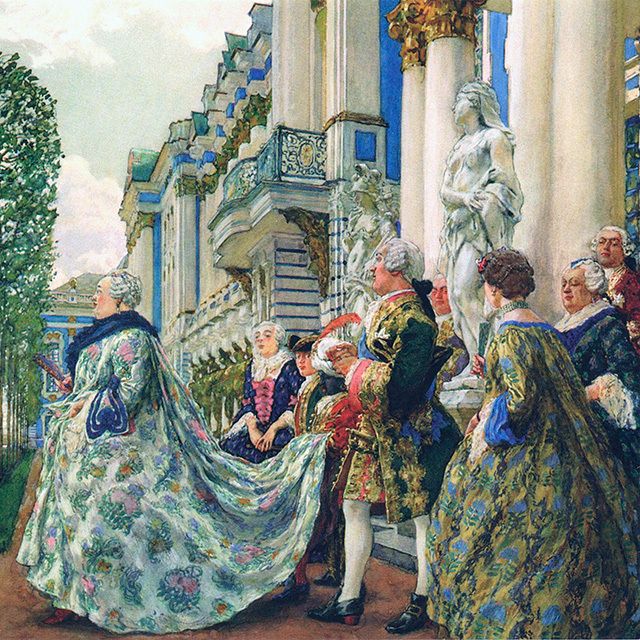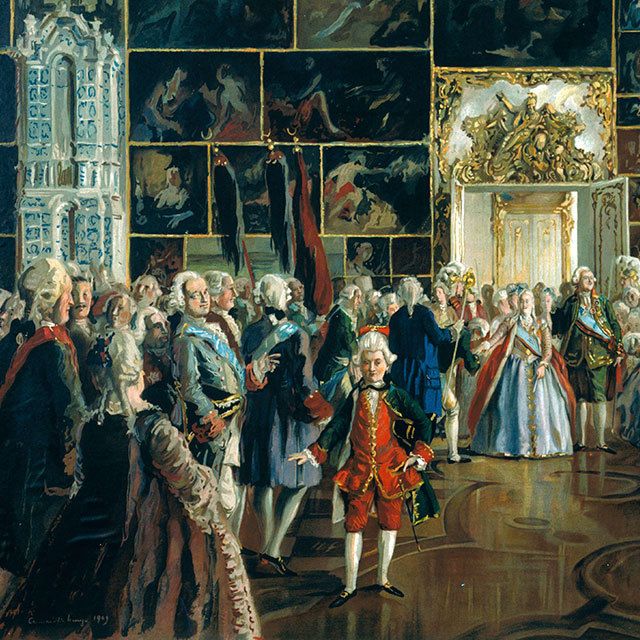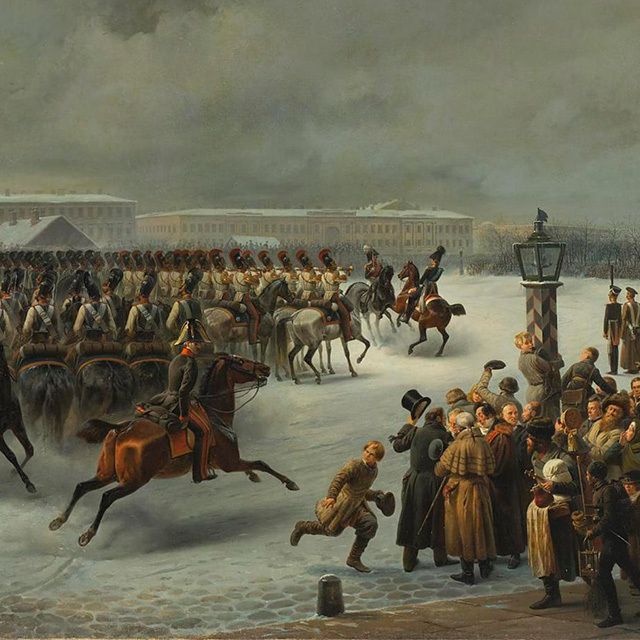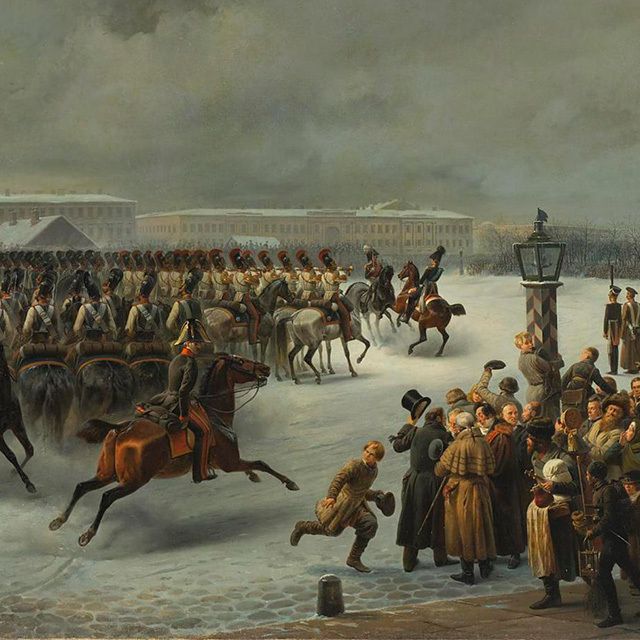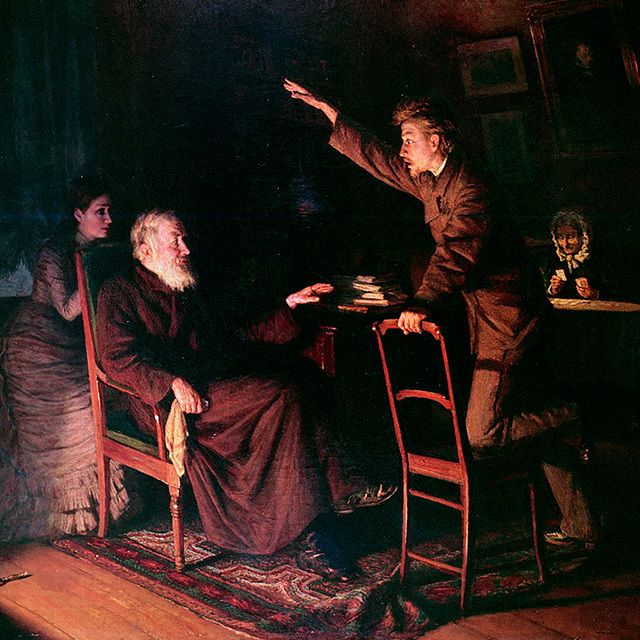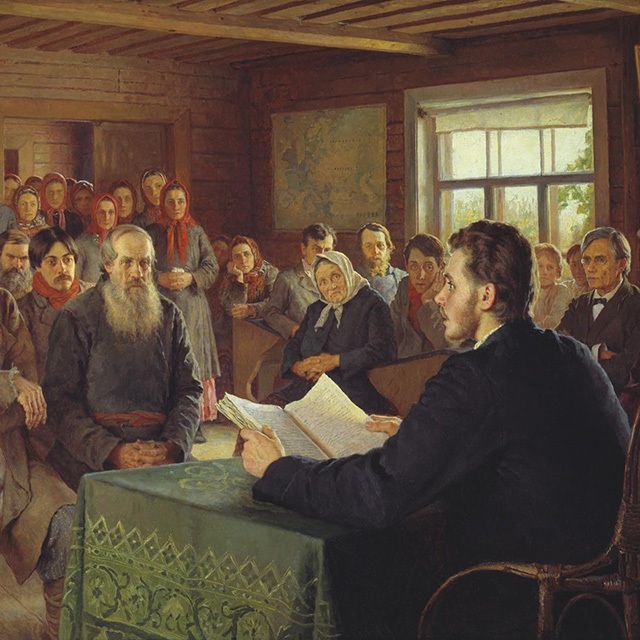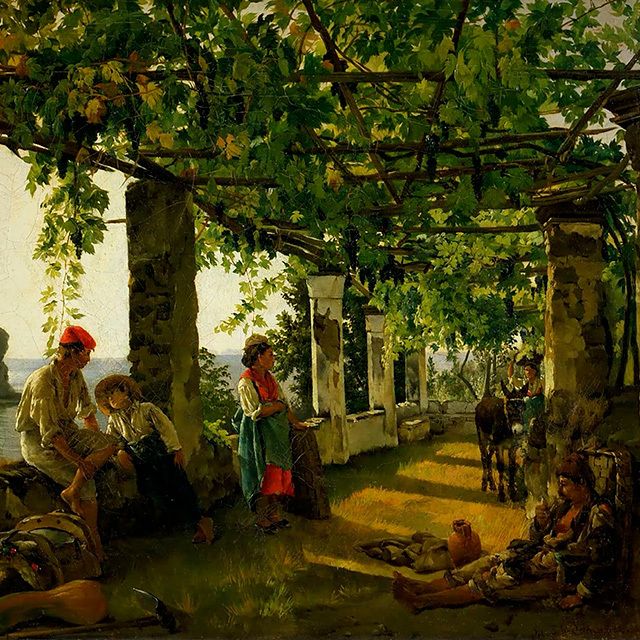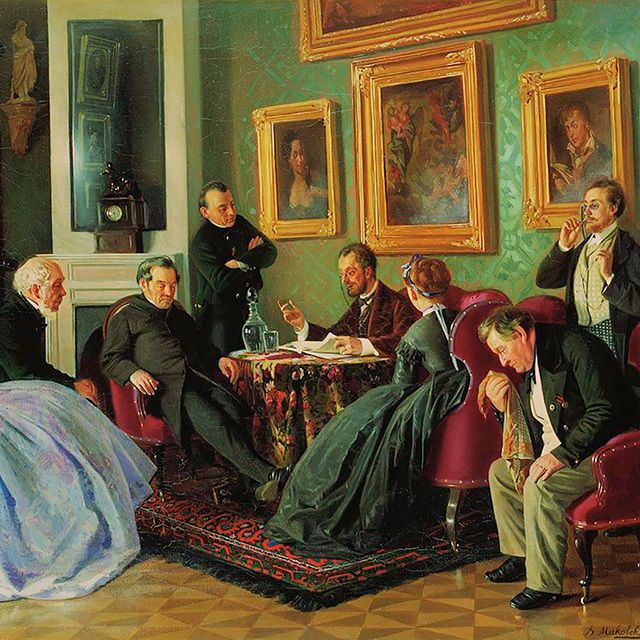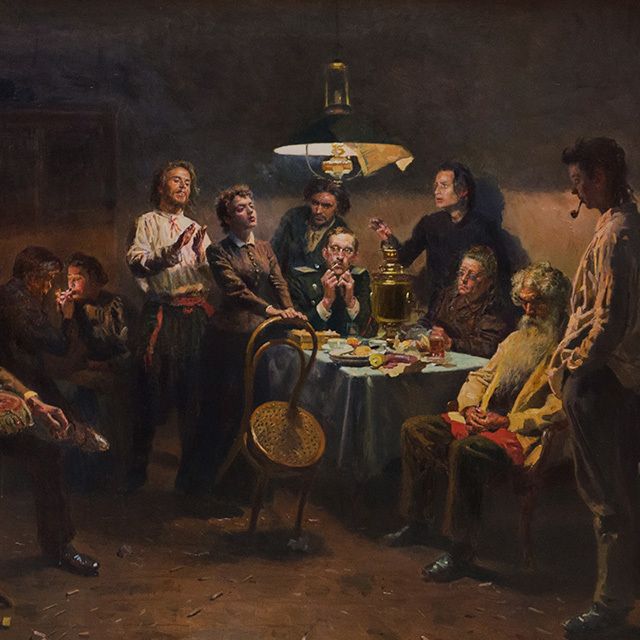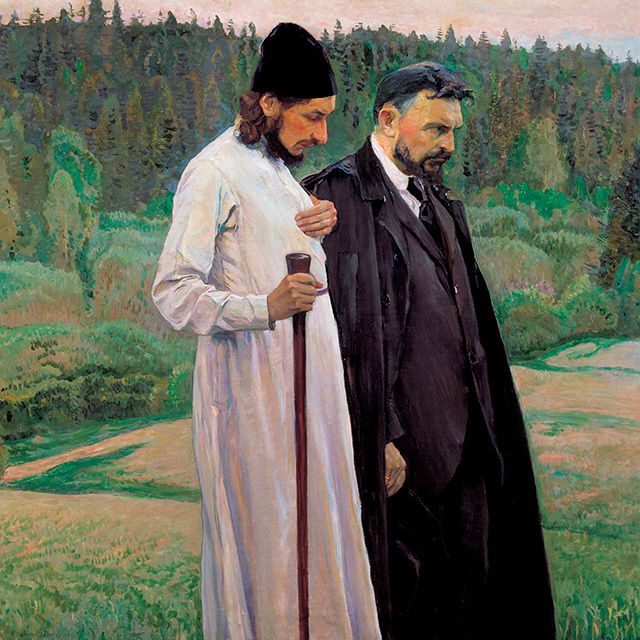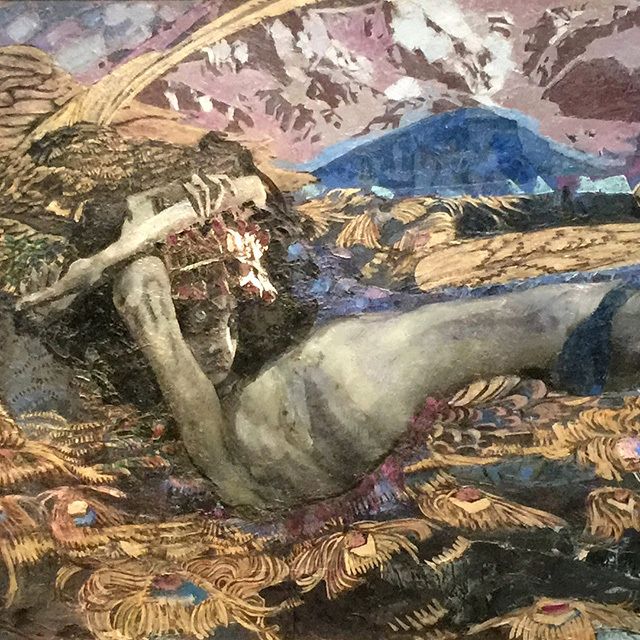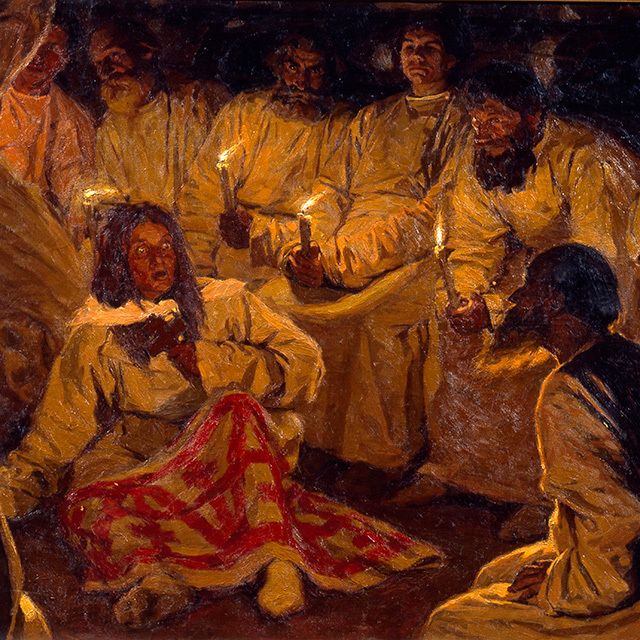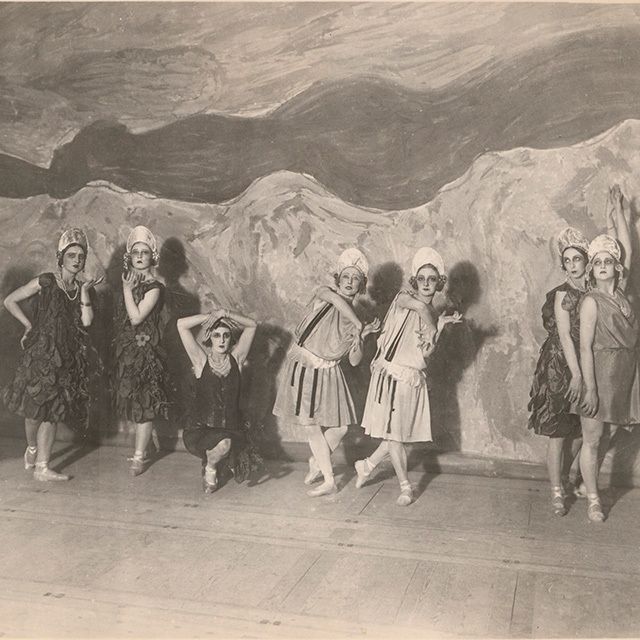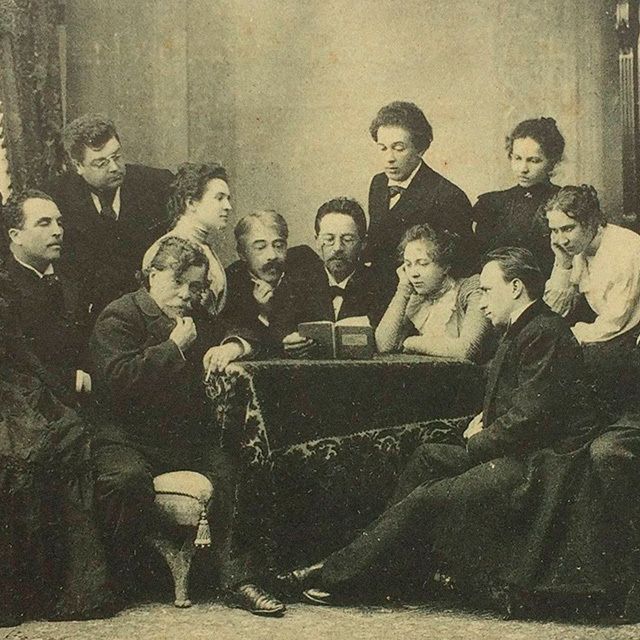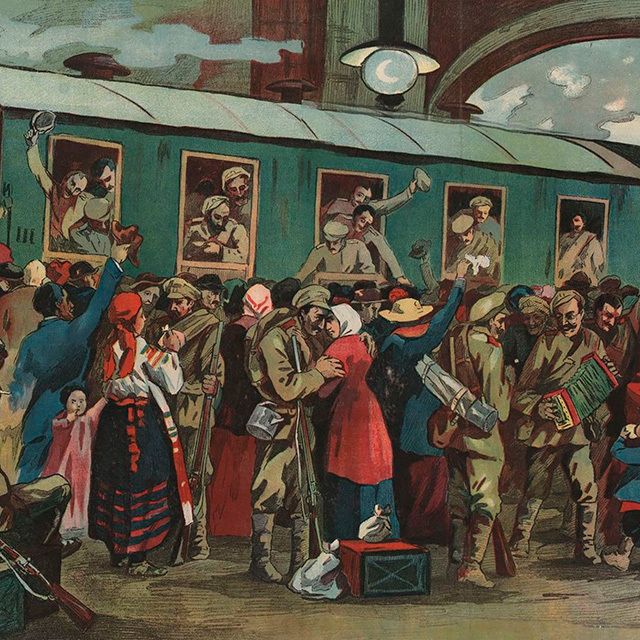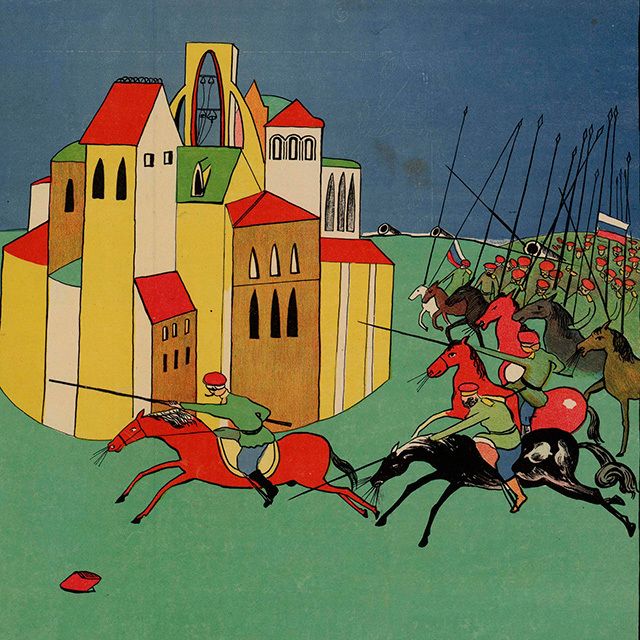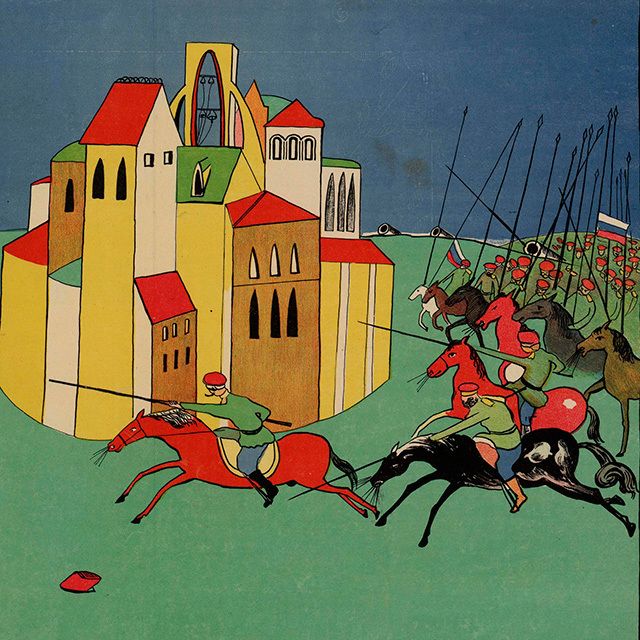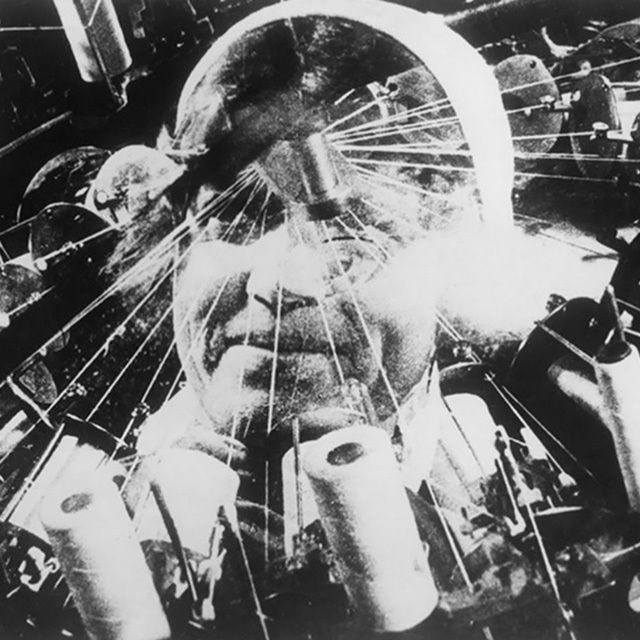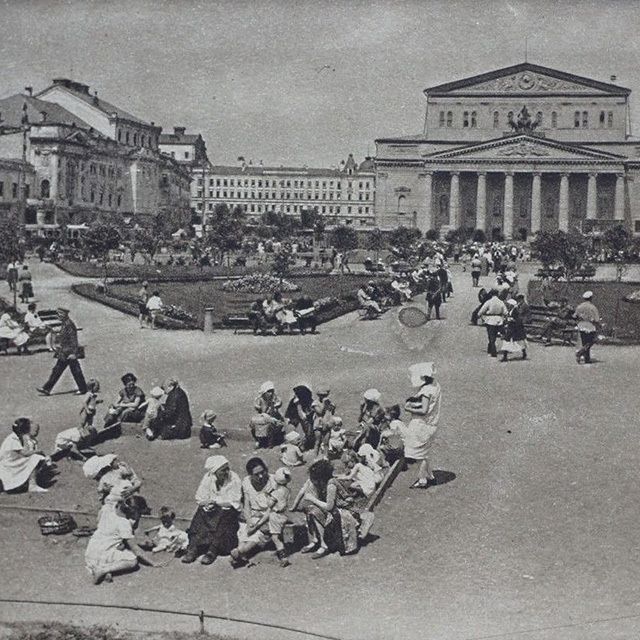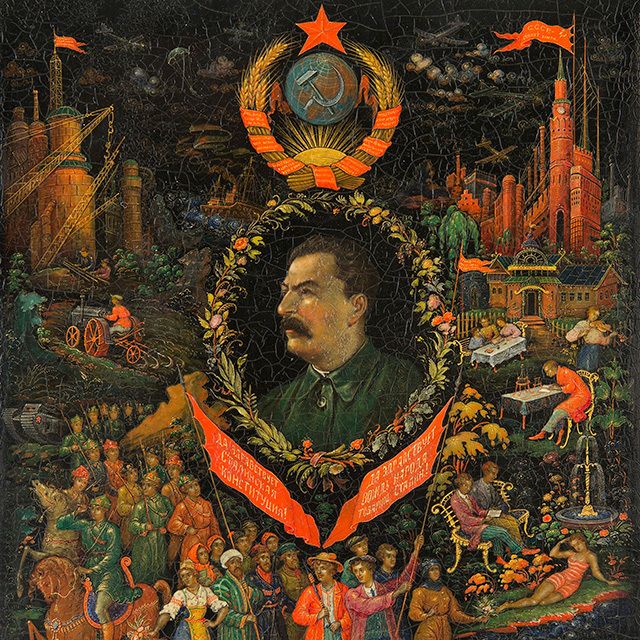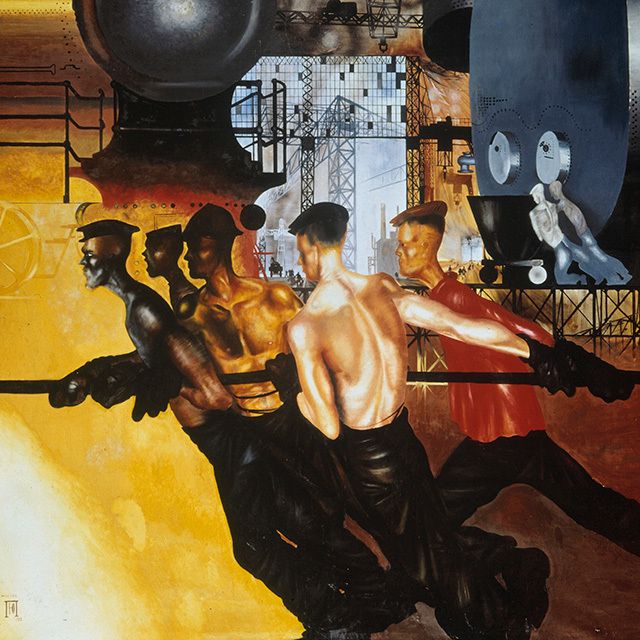Всего найдено: 9
Здравствуйте! Нужна ли запятая на отрезке: «Я думала (?) это весна, а это оттепель…»?
Ответ справочной службы русского языка
Запятая ставится.
Возможно ли уже писать словосочетание «культурная революция» без кавычек, как железный занавес, холодная война, перестройка, оттепель и т. п.?
Ответ справочной службы русского языка
Возможно, но рекомендации справочников прежние (использовать кавычки).
Здравствуйте! Есть ли у существительного «оттепель» форма множественного числа? Школьные учебники полагают, что это существительное употребляется только в форме единственного числа. Будет ли неправильной фраза: «Наступила пора весенних оттепелей»? Спасибо.
Ответ справочной службы русского языка
У слова оттепель есть формы множественного числа. Многочисленные примеры из художественной литературы подтверждают это: Зима, как неприступная, холодная красавица, выдерживает свой характер вплоть до узаконенной поры тепла; не дразнит неожиданными оттепелями и не гнет в три дуги неслыханными морозами… И. Гончаров, Обломов. Зима в этом году упала симпатичная: пушистая, с милым характером, без гнилых оттепелей, без изуверских морозов… А. Макаренко, Педагогическая поэма. А еще помню я много серых и жестких зимних дней, много темных и грязных оттепелей, когда становится особенно тягостна русская уездная жизнь, когда лица у всех делались скучны, недоброжелательны, ― первобытно подвержен русский человек природным влияниям! К. Паустовский, Золотая роза.
Не понимаю: «железный занавес» (в кавычках), но холодная война, перестройка, оттепель (без кавычек). Все эти слова употребляются не в прямом значении, поэтому должны быть в кавычках. Если же это устойчивые выражения, то все должны быть без кавычек.
Ответ справочной службы русского языка
В принципе, железный занавес уже тоже можно писать без кавычек, это употребление давно перестало быть новым, необычным. Например, в «Большом толковом словаре русского языка» под ред. С. А. Кузнецова сочетание железный занавес зафиксировано без кавычек.
Почему названия исторических событий: холокост, оттепель, перестройка, — пишутся со строчной, а, например, Жакерия — с прописной?
Ответ справочной службы русского языка
Многое в написании названий исторических событий определяется традицией и временной удаленностью этих событий. Да и речь здесь даже не об исторических событиях: оттепель и перестройка – это просто обозначения разных периодов истории СССР. У слова оттепель, например, словари фиксируют общее значение ‘о смягчении режима политического давления’ и приводят пример горбачевская оттепель.
Что касается слова холокост, то мы уже неоднократно отвечали на Ваши вопросы об употреблении и написании этого слова (в том числе и о возможности его написания с прописной).
Хрущевская оттепель — надо ли закавычивать? Или только «оттепель«?
Ответ справочной службы русского языка
Кавычки не требуются: хрущевская оттепель.
как образовать от слова тепло,слово с удвоенной согласной на стыке приставки и корня
Ответ справочной службы русского языка
Такое слово — оТТепель.
Как правильно: Оттепель или «оттепель» (имеется в виду временной период)?
Ответ справочной службы русского языка
См. ответ № 207534.
Как правильно писать: Х(х)рущёвская оттепель, О(о)ттепель (исторический период)? Спасибо.
Ответ справочной службы русского языка
Корректно: _хрущевская оттепель, «оттепель»._
Русский[править]
Тип и синтаксические свойства сочетания[править]
хрущёвская о́ттепель
Устойчивое сочетание (термин). Используется в качестве именной группы.
Произношение[править]
- МФА: [xrʊˈɕːɵfskəɪ̯ə ˈotʲːɪpʲɪlʲ]
Семантические свойства[править]
Значение[править]
- истор. период в истории СССР, охватывающий время с 1953 года (смерть И. В. Сталина) до 1964 года (отставка Н. С. Хрущёва); характеризовался осуждением культа личности Сталина и репрессий, освобождением политических заключённых, ликвидацией ГУЛАГа, ослаблением цензуры, повышением уровня свободы слова, относительной либерализацией политической и общественной жизни, большей свободой творческой деятельности ◆ Сейчас разного рода международными соревнованиями никого не удивишь, а в те годы это было очень большой редкостью: «железный занавес» только-только стал подниматься, знаменитая «хрущёвская оттепель» едва начиналась, и советских людей, которые могли выезжать за границу, было ещё немного. И. К. Архипова, «Музыка жизни», 1996 г. [НКРЯ] ◆ В советском прокате фильм Клода Лелуша [«Мужчина и женщина»] был продемонстрирован в 1967 году на излёте хрущёвской оттепели, которая реально завершилась не со снятием Н. С. Хрущёва, а скорее в 1968 году, после введения в Прагу советских войск. Н. Б. Лебина, «Мужчина и женщина», Тело, мода, культура. СССР — оттепель, 2014 г. [НКРЯ]
Синонимы[править]
Антонимы[править]
Гиперонимы[править]
Гипонимы[править]
Этимология[править]
Перевод[править]
| Список переводов | |
Библиография[править]
The Khrushchev Thaw (Russian: хрущёвская о́ттепель, tr. khrushchovskaya ottepel, IPA: [xrʊˈɕːɵfskəjə ˈotʲ:ɪpʲɪlʲ] or simply ottepel)[1] is the period from the mid-1950s to the mid-1960s when repression and censorship in the Soviet Union were relaxed due to Nikita Khrushchev’s policies of de-Stalinization[2] and peaceful coexistence with other nations. The term was coined after Ilya Ehrenburg’s 1954 novel The Thaw («Оттепель»),[3] sensational for its time.
The Thaw became possible after the death of Joseph Stalin in 1953. First Secretary Khrushchev denounced former General Secretary Stalin[4] in the «Secret Speech» at the 20th Congress of the Communist Party,[5][6] then ousted the Stalinists during his power struggle in the Kremlin. The Thaw was highlighted by Khrushchev’s 1954 visit to Beijing, People’s Republic of China, his 1955 visit to Belgrade, Yugoslavia (with whom relations had soured since the Tito–Stalin Split in 1948), and his subsequent meeting with Dwight Eisenhower later that year, culminating in Khrushchev’s 1959 visit to the United States.
The Thaw allowed some freedom of information in the media, arts, and culture; international festivals; foreign films; uncensored books; and new forms of entertainment on the emerging national TV, ranging from massive parades and celebrations to popular music and variety shows, satire and comedies, and all-star shows[7] like Goluboy Ogonyok. Such political and cultural updates altogether had a significant influence on the public consciousness of several generations of people in the Soviet Union.[8][9]
Leonid Brezhnev, who succeeded Khrushchev, put an end to the Thaw. The 1965 economic reform of Alexei Kosygin was de facto discontinued by the end of the 1960s, while the trial of the writers Yuli Daniel and Andrei Sinyavsky in 1966—the first such public trial since Stalin’s reign—and the invasion of Czechoslovakia in 1968 identified reversal of the liberalization of the country.
Khrushchev and Stalin[edit]
Khrushchev and Stalin, 1936, Kremlin
Khrushchev’s Thaw had its genesis in the concealed power struggle among Stalin’s lieutenants.[1] Several major leaders among the Red Army commanders, such as Marshal Georgy Zhukov and his loyal officers, had some serious tensions with Stalin’s secret service.[1][10] On the surface, the Red Army and the Soviet leadership seemed united after their victory in World War II. However, the hidden ambitions of the top people around Stalin, as well as Stalin’s own suspicions, had prompted Khrushchev that he could rely only on those few; they would stay with him through the entire political power struggle.[10][11] That power struggle was surreptitiously prepared by Khrushchev while Stalin was alive,[1][10] and came to surface after Stalin’s death in March 1953.[10] By that time, Khrushchev’s people were planted everywhere in the Soviet hierarchy, which allowed Khrushchev to execute, or remove his main opponents, and then introduce some changes in the rigid Soviet ideology and hierarchy.[1]
Stalin’s leadership had reached new extremes in ruling people at all levels,[12] such as the deportations of nationalities, the Leningrad Affair, the Doctors’ plot, and official criticisms of writers and other intellectuals. At the same time, millions of soldiers and officers had seen Europe after World War II, and had become aware of different ways of life which existed outside the Soviet Union. Upon Stalin’s orders many were arrested and punished again,[12] including the attacks on the popular Marshal Georgy Zhukov and other top generals, who had exceeded the limits on taking trophies when they looted the defeated nation of Germany. The loot was confiscated by Stalin’s security apparatus, and Marshal Zhukov was demoted, humiliated and exiled; he became a staunch anti-Stalinist.[13] Zhukov waited until the death of Stalin, which allowed Khrushchev to bring Zhukov back for a new political battle.[1][14]
The temporary union between Nikita Khrushchev and Marshal Georgy Zhukov was founded on their similar backgrounds, interests and weaknesses:[1] both were peasants, both were ambitious, both were abused by Stalin, both feared the Stalinists, and both wanted to change these things. Khrushchev and Zhukov needed one another to eliminate their mutual enemies in the Soviet political elite.[14][15]
In 1953, Zhukov helped Khrushchev to eliminate Lavrenty Beria,[1] then a First Vice-Premier, who was promptly executed in Moscow, as well as several other figures of Stalin’s circle. Soon Khrushchev ordered the release of millions of political prisoners from the Gulag camps. Under Khrushchev’s rule the number of prisoners in the Soviet Union was decreased, according to some writers, from 13 million to 5 million people.[12]
Khrushchev also promoted and groomed Leonid Brezhnev,[14] whom he brought to the Kremlin and introduced to Stalin in 1952.[1] Then Khrushchev promoted Brezhnev to Presidium (Politburo) and made him the Head of Political Directorate of the Red Army and Navy, and moved him up to several other powerful positions. Brezhnev in return helped Khrushchev by tipping the balance of power during several critical confrontations with the conservative hard-liners, including the ouster of pro-Stalinists headed by Molotov and Malenkov.[14][16]
Khrushchev’s 1956 speech denouncing Stalin[edit]
O kulcie jednostki i jego następstwach, Warsaw, March 1956, first edition of the Secret Speech, published for the inner use in the PUWP.
Khrushchev denounced Stalin in his speech On the Cult of Personality and Its Consequences, delivered at the closed session of the 20th Party Congress, behind closed doors, after midnight on 25 February 1956.[17] In this speech, Khrushchev described the damage done by Joseph Stalin’s cult of personality, and the repressions, known as the Great Purge that killed millions and traumatized many people in the Soviet Union.[18] After the delivery of the speech, it was officially disseminated in a shorter form among members of the Soviet Communist Party across the USSR starting 5 March 1956.[1]
Together with his ally Anastas Mikoyan and a small but prominent group of Gulag returnees, Khrushchev also initiated a wave of rehabilitations.[19] This action officially restored the reputations of many millions of innocent victims, who were killed or imprisoned in the Great Purge under Stalin.[17] Further, tentative moves were made through official and unofficial channels to relax restrictions on freedom of speech that had been held over from the rule of Stalin.[1]
Khrushchev’s 1956 speech was the strongest effort ever in the USSR to bring political change,[1] at that time, after several decades of fear of Stalin’s rule, that took countless innocent lives.[20] Khrushchev’s speech was published internationally within a few months,[1] and his initiatives to open and liberalize the USSR had surprised the world. Khrushchev’s speech had angered many of his powerful enemies, thus igniting another round of ruthless power struggle within the Soviet Communist Party.
Issues and tensions[edit]
Georgian revolt[edit]
Khrushchev’s denouncement of Stalin came as a shock to the Soviet people. Many in Georgia, Stalin’s homeland, especially the young generation, bred on the panegyrics and permanent praise of the «genius» of Stalin, perceived it as a national insult. In March 1956, a series of spontaneous rallies to mark the third anniversary of Stalin’s death quickly evolved into an uncontrollable mass demonstration and political demands such as the change of the central government in Moscow and calls for the independence of Georgia from the Soviet Union appeared,[21] leading to the Soviet army intervention and bloodshed in the streets of Tbilisi.[22]
Polish and Hungarian Revolutions of 1956[edit]
The first big international failure of Khrushchev’s politics came in October–November 1956.
The Hungarian Revolution of 1956 was suppressed by a massive invasion of Soviet tanks and Red Army troops in Budapest. The street fighting against the invading Red Army caused thousands of casualties among Hungarian civilians and militia, as well as hundreds of the Soviet military personnel killed. The attack by the Soviet Red Army also caused massive emigration from Hungary, as hundreds of thousands of Hungarians had fled as refugees.[23]
At the same time, the Polish October emerged as the political and social climax in Poland. Such democratic changes in the internal life of Poland were also perceived with fear and anger in Moscow, where the rulers did not want to lose control, fearing the political threat to Soviet security and power in Eastern Europe.[24]
1957 plot against Khrushchev[edit]
A faction of the Soviet communist party was enraged by Khrushchev’s speech in 1956, and rejected Khrushchev’s de-Stalinization and liberalization of Soviet society. One year after Khrushchev’s secret speech, the Stalinists attempted to oust Khrushchev from the leadership position in the Soviet Communist Party.[1]
Khrushchev’s enemies considered him hypocritical as well as ideologically wrong, given Khrushchev’s involvement in Stalin’s Great Purges, and other similar events as one of Stalin’s favorites. They believed that Khrushchev’s policy of peaceful coexistence would leave the Soviet Union open to attack. Vyacheslav Molotov, Lazar Kaganovich, Georgy Malenkov, and Dmitri Shepilov,[17] who joined at the last minute after Kaganovich convinced him the group had a majority, attempted to depose Khrushchev as First Secretary of the Party in May 1957.[1]
However, Khrushchev had used Marshal Georgy Zhukov again. Khrushchev was saved by several strong appearances in his support – especially powerful was support from both Zhukov and Mikoyan.[25] At the extraordinary session of the Central Committee held in late June 1957, Khrushchev labeled his opponents the Anti-Party Group[17] and won a vote which reaffirmed his position as First Secretary.[1] He then expelled Molotov, Kaganovich, and Malenkov from the Secretariat and ultimately from the Communist Party itself.
Economy and political tensions[edit]
Khrushchev’s attempts in reforming the Soviet industrial infrastructure led to his clashes with professionals in most branches of the Soviet economy. His reform of administrative organization caused him more problems. In a politically motivated move to weaken the central state bureaucracy in 1957, Khrushchev replaced the industrial ministries in Moscow with regional Councils of People’s Economy, sovnarkhozes, making himself many new enemies among the ranks in Soviet government.[25]
Khrushchev’s power, although indisputable, had never been comparable to that of Stalin’s, and eventually began to fade. Many of the new officials who came into the Soviet hierarchy, such as Mikhail Gorbachev, were younger, better educated, and more independent thinkers.[26]
In 1956, Khrushchev introduced the concept of a minimum wage. The idea was met with much criticism with communist hardliners, they claimed that the minimum wage was so small, that most people were still underpaid in reality. The next step was a contemplated financial reform. However, Khrushchev stopped short of real monetary reform, and made a simple redenomination of the rouble at 10:1 in 1961.
In 1961, Khrushchev finalized his battle against Stalin: the body of the dictator was removed from Lenin’s Mausoleum on the Red Square and then buried outside the walls of the Kremlin.[1][10][14][25][27] The removal of Stalin’s body out of Lenin’s Mausoleum was arguably among the most provocative moves made by Khrushchev during the Thaw. The removal of Stalin’s body consolidated pro-Stalinists against Khrushchev,[1][14] and alienated even his loyal apprentices, such as Leonid Brezhnev.[citation needed]
Openness and cultural liberalization[edit]
After the early 1950s, Soviet society enjoyed a series of cultural and sports events and entertainment of unprecedented scale, such as the first Spartakiad, as well as several innovative film comedies, such as Carnival Night, and several popular music festivals. Some classical musicians, filmmakers and ballet stars were allowed to make appearances outside the Soviet Union in order to better represent its culture and society to the world.[17]
The first Soviet academics to visit the United States in an official capacity following World War II were biochemist Andrey Kursanov and historian Boris Rybakov, who attended the Columbia University Bicentennial in New York City as representatives of the Academy of Sciences of the Soviet Union.[28] Earlier attempts by American institutions, such as Princeton in 1946, to invite Soviet scholars to the United States had been frustrated.[29] The decision to allow Kursanov and Rybakov to attend marked the beginning of a new period of academic exchange between the Soviet Union and the United States: Columbia University repaid the visit in 1955, when it sent its own representatives to the bicentennial of Moscow State University,[30] and by 1958 the universities had established an exchange program for students and faculty.[31]
In 1956, an agreement was achieved between the Soviet and US Governments to resume the publication and distribution in the Soviet Union of the US-produced magazine Amerika, and to launch its counterpart, the USSR magazine in the US.[32]
In the summer of 1956, just a few months after Khrushchev’s secret speech, Moscow became the center of the first Spartakiad of the Peoples of the USSR. The event was made pompous in the Soviet style: Moscow hosted large sports teams and groups of fans in national costumes who came from all Union republics. Khrushchev used the event to accentuate his new political and social goals, and to show himself as a new leader who was completely different from Stalin.[1][14]
In July 1957, the 6th World Festival of Youth and Students was held in Moscow. It was the first World Festival of Youth and Students held in the Soviet Union, which was opening its doors for the first time to the world. The festival attracted 34,000 people from 130 countries.[33]
In 1958, the first International Tchaikovsky Competition was held in Moscow. The winner was American pianist Van Cliburn, who gave sensational performances of Russian music. Khrushchev personally approved giving the top award to the American musician.[1]
Khrushchev’s Thaw opened the Soviet society to a degree that allowed some foreign movies, books, art and music. Some previously banned writers and composers, such as Anna Akhmatova and Mikhail Zoshchenko, among others, were brought back to public life, as the official Soviet censorship policies had changed. Books by some internationally recognized authors, such as Ernest Hemingway, were published in millions of copies to satisfy the interest of readers in the USSR.
In 1962, Khrushchev personally approved the publication of Aleksandr Solzhenitsyn’s story One Day in the Life of Ivan Denisovich, which became a sensation, and made history as the first uncensored publication about Gulag labor camps.[1]
There was still a lot of agitation against religion that had temporarily halted during the war effort and the years after toward the end of Stalin’s rule.[citation needed]
The era of the Cultural Thaw ended in December 1962 after the Manege Affair.
Music[edit]
Censorship of the arts relaxed throughout the Soviet Union. During this time of liberalization, Russian composers, performers, and listeners of music experienced a newfound openness in musical expression which led to the foundation of an unofficial music scene from the mid 1950s to the 1970s.[34]
Despite these liberalizing reforms in music, many argue that Khrushchev’s legislation of the arts was based, not enough on freedom of expression of the Soviet people per se, and too much on his own personal tastes. Following the emergence of some unconventional, avant-garde music as a result of his reforms, on 8 March 1963, Khrushchev delivered a speech which began to reverse some of his de-Stalinization reforms, in which he stated: «We flatly reject this cacophonous music. Our people can’t use this garbage as a tool for their ideology.» and «Society has a right to condemn works which are contrary to the interests of the people.»[35] Although the Thaw was considered a time of openness and liberalization, Khrushchev continued to place restrictions on these newfound freedoms.
Nonetheless, despite Khrushchev’s inconsistent liberalization of musical expression, his speeches were not so much «restrictions» as «exhortations».[35] Artists, and especially musicians, were provided access to resources that had previously been censored or altogether inaccessible prior to Khrushchev’s reforms. The composers of this time, for example, were able to access scores by composers such as Arnold Schoenberg and Pierre Boulez, gaining inspiration from and imitating previously concealed musical scores.[36]
As Soviet composers gained access to new scores and were given a taste of freedom of expression during the late 1950s, two separate groups began to emerge. One group wrote predominantly «official» music which was «sanctioned, nourished, and supported by the Composers’ Union». The second group wrote «unofficial», «left», «avant-garde», or «underground» music, marked by a general state of opposition against the Soviet Union. Although both groups are widely considered to be interdependent, many regard the unofficial music scene as more independent and politically influential than the former in the context of the Thaw.[37]
The unofficial music that emerged during the Thaw was marked by the attempt, whether successful or unsuccessful, to reinterpret and reinvigorate the «battle of form and content» of the classical music of the period.[34] Although the term «unofficial» implies a level of illegality involved in the production of this music, composers, performers, and listeners of «unofficial» music actually used «official» means of production. Rather, the music was considered unofficial within a context that counteracted, contradicted, and redefined the socialist realist requirements from within their official means and spaces.[34]
Unofficial music emerged in two distinct phases. The first phase of unofficial music was marked by performances of «escapist» pieces. From a composer’s perspective, these works were escapist in the sense that their sound and structure withdrew from the demands of socialist realism. Additionally, pieces developed during this phase of unofficial music allowed the listeners the ability to escape the familiar sounds that Soviet officials officially sanctioned.[34] The second phase of unofficial music emerged during the late 1960s, when the plots of the music became more apparent, and composers wrote in a more mimetic style, writing in contrast to their earlier compositions of the first phase.[34]
Throughout the musical Thaw, the generation of «young composers» who had matured their musical tastes with broader access to music that had previously been censored was the prime focus of the unofficial music scene. The Thaw allowed these composers the freedom to access old and new scores, especially those originating in the Western avant-garde.[34] During the late 1950s and early 1960s, young composers such as Andrei Volkonsky and Edison Denisov, among others, developed abstract musical practices that created sounds that were new to the common listener’s ear. Socialist realist music was widely considered «boring», and the unofficial concerts that the young composers presented allowed the listeners «a means of circumventing, reinterpreting, and undercutting the dominant socialist realist aesthetic codes».[36]
Despite the seemingly rebellious nature of the unofficial music of the Thaw, historians debate whether the unofficial music that emerged during this time should truly be considered as resistance to the Soviet system. While a number of participants in unofficial concerts «claimed them to be a liberating activity, connoting resistance, opposition, or protest of some sort»,[34] some critics claim that rather than taking an active role in opposing Soviet power, composers of unofficial music simply «withdrew» from the demands of the socialist realist music and chose to ignore the norms of the system.[34] Although Westerners tend to categorize unofficial composers as «dissidents» against the Soviet system, many of these composers were afraid to take action against the system in fear that it might have a negative impact on their professional advancement.[34] Many composers favored a less direct, yet significant method of opposing the system through their lack of musical compliance.
Regardless of the intentions of the composers, the effect of their music on audiences throughout the Soviet Union and abroad «helped audiences imagine alternative possibilities to those suggested by Soviet authorities, principally through the ubiquitous stylistic tropes of socialist realism».[34] Although the music of the younger generation of unofficial Soviet composers experienced little widespread success in the West, its success within the Soviet Union was apparent throughout the Thaw (Schwarz 423). Even after Khrushchev’s fall from power in October 1964, the freedoms that composers, performers, and listeners felt through unofficial concerts lasted into the 1970s.[34]
However, despite the powerful role that unofficial music played in the Soviet Union during the Thaw, much of the music that was composed during that time continued to be controlled. As a result of this, a great deal of this unofficial music remains undocumented. Consequently, much of what we know now about unofficial music in the Thaw can be sourced only through interviews with those composers, performers, and listeners who witnessed the unofficial music scene during the Thaw.[34]
International relations[edit]
The death of Stalin in 1953 and the twentieth CPSU congress of February 1956 had a huge impact throughout Eastern Europe. Literary thaws actually preceded the congress in Hungary, Poland, Bulgaria, and the GDR and later burgeoned briefly in Czechoslovakia and Chairman Mao’s China. With the exception of the arch Stalinist and anti-Titoist Albania, Romania was the only country where intellectuals avoided an open clash with the regime, influenced partly by the lack of any earlier revolt in post-war Romania that would have forced the regime to make concessions.[38]
In the West, Khrushchev’s Thaw is known as a temporary thaw in the icy tension between the United States and the USSR during the Cold War. The tensions were able to thaw because of Khrushchev’s de-Stalinization of the USSR and peaceful coexistence theory and also because of US President Eisenhower’s cautious attitude and peace attempts. For example, both leaders attempted to achieve peace by attending the 1955 Geneva International Peace Summit and developing the Open Skies Policy and Quest for Arms Agreement. The leaders’ attitudes allowed them to, as Khrushchev put it, «break the ice.»
Khrushchev’s Thaw developed largely as a result of Khrushchev’s theory of peaceful co-existence which believed the two superpowers (USA and USSR) and their ideologies could co-exist together, without war. Khrushchev had created the theory of peaceful existence in an attempt to reduce hostility between the two superpowers. He tried to prove peaceful coexistence by attending international peace conferences, such as the Geneva Summit, and by traveling internationally, such as his trip to USA’s Camp David in 1959.
This spirit of co-operation was severely damaged by the 1960 U-2 incident. The Soviet presentation of downed pilot Francis Gary Powers at the May 1960 Paris Peace Summit and Eisenhower’s refusal to apologize ended much of the progress of this era. Then Khrushchev approved the construction of the Berlin Wall in 1961.
Further deterioration of the Thaw and decay of Khrushchev’s international political standing happened during the Cuban Missile Crisis in 1962. At that time, the Soviet and international media were making two completely opposite pictures of reality, while the world was at the brink of a nuclear war. Although direct communication between Khrushchev and the US president John F. Kennedy[39] helped to end the crisis, Khrushchev’s political image in the West was damaged.
Social, cultural and economic reforms[edit]
Khrushchev’s Thaw caused unprecedented social, cultural and economic transformations in the Soviet Union. The 60s generation actually started in the 1950s, with their uncensored poetry, songs and books publications.
The 6th World Festival of Youth and Students had opened many eyes and ears in the Soviet Union. Many new social trends stemmed from that festival. Many Russian women became involved in love affairs with men visiting from all over the world, what resulted in the so-called «inter-baby boom» in Moscow and Leningrad. The festival also brought new styles and fashions that caused further spread of youth subculture called «stilyagi». The festival also «revolutionized» the underground currency trade and boosted the black market.
Emergence of such popular stars as Bulat Okudzhava, Edita Piekha, Yevgeny Yevtushenko, Bella Akhmadulina, and the superstar Vladimir Vysotsky had changed the popular culture forever in the USSR. Their poetry and songs broadened the public consciousness of the Soviet people and pushed guitars and tape recorders to masses, so the Soviet people became exposed to independent channels of information and public mentality was eventually updated in many ways.
Khrushchev finally liberated millions of peasants; by his order the Soviet government gave them identifications, passports, and thus allowed them to move out of poor villages to big cities. Massive housing construction, known as khrushchevkas, were undertaken during the 1950s and 1960s. Millions of cheap and basic residential blocks of low-end flats were built all over the Soviet Union to accommodate the largest migration ever in the Soviet history, when masses of landless peasants moved to Soviet cities. The move caused a dramatic change of the demographic picture in the USSR, and eventually finalized the decay of peasantry in Russia.
Economic reforms were contemplated by Alexei Kosygin, who was chairman of the USSR State Planning Committee in 1959 and then a full member of the Presidium (also known as Politburo after 1966) in 1960.[17]
Consumerism[edit]
In 1959, the American National Exhibition came to Moscow with the goals of displaying United States’ productivity and prosperity. The latent goal of the Americans was to get the Soviet Union to reduce production of heavy industry. If the Soviet Union started putting their resources towards producing consumer goods, it would also mean a reduction of war materials. An estimated number of over twenty million Soviet citizens viewed the twenty-three U.S. exhibitions during a thirty-year period.[40] These exhibitions were part of the Cultural Agreement formed by the United States and the Soviet Union in order to acknowledge the long-term exchange of science, technology, agriculture, medicine, public health, radio, television, motion pictures, publications, government, youth, athletics, scholarly research, culture, and tourism.[41] In addition to the influences of European and Western culture, the spoils of the Cold War exposed the Soviet people to a new way of life.[42] Through motion pictures from the United States, viewers learned of another way of life.[40]
The Kitchen Debate[edit]
The Kitchen Debate at the 1959 Exhibition in Moscow fueled Khrushchev to catch up to Western consumerism. The «Khrushchev regime had promised abundance to secure its legitimacy.»[43] The ideology of strict functionality concerning material goods evolved into a more relaxed view of consumerism. American sociologist David Riesman coined the term «Operation Abundance» also known as the «Nylon War» which predicted «Russian people would not long tolerate masters who gave them tanks and spies instead of vacuum cleaners and beauty parlors.»[44] The Soviets would have to produce more consumer goods to quell mass discontent. Riesman’s theory came true to some extent as the Soviet culture changed to include consumer goods such as vacuum cleaners, washing machines, and sewing machines. These items were specifically targeted at women in the Soviet Union with the idea that they relieved women of their domestic burden. Additionally an interest in changing the western image of a dowdy Russian woman led to the cultural acceptance of beauty products. The modern Russian woman wanted the clothing, cosmetics, and hairstyles available to Western women. Under the Thaw, beauty shops selling cosmetics and perfume, which had previously only been available to the wealthy, became available for common women.[45]
Khrushchev’s Response[edit]
Khrushchev responded to consumerism more diplomatically than to cultural consumption. In response to American jazz Khrushchev stated: «I don’t like jazz. When I hear jazz, it’s as if I had gas on the stomach. I used to think it was static when I heard it on the radio.»[46] Concerning commissioning artists during the Thaw, Khrushchev declared: «As long as I am president of the Council of Ministers, we are going to support a genuine art. We aren’t going to give a kopeck for pictures painted by jackasses.»[46] In comparison, the consumption of material goods acted as a measure of economic success. Khrushchev stated: «We are producing an ever-growing quantity of all kinds of consumer goods; all the same, we must not force the pace unreasonably as regards the lowering of prices. We don’t want to lower prices to such an extent that there will be queues and a black market.»[47] Previously, excessive consumerism under Communism was seen as detrimental to the common good. Now, it was not enough for the consumer goods to be made more available; quality of consumer goods needed to be raised as well.[48] A misconception surrounding the quality of consumer goods existed because of advertising’s role in the market. Advertising controlled sale quotas by increasing the desirability of surplus sub-standard goods.[49]
Origins and outcome[edit]
The roots of consumerism started as early as the 1930s when in 1935 each Soviet Republic capital city established a model department store.[50] The department stores acted as representatives of Soviet economic success. Under Khrushchev the retail sectors gained prevalence as Soviet department stores GUM (department store) and TsUM (Central Department Store), both located in Moscow, began to focus on trade and social interaction.[51]
An increase of private housing[edit]
On 31 July 1957 the Communist party decreed to increase housing construction and Khrushchev launched plans for building private apartments that differed from the old, communal apartments that had come before. Khrushchev stated that it was important «not only to provide people with good homes, but also to teach them…to live correctly.» He saw a high living standard as a precondition leading the path on the transition to full communism and believed that private apartments could achieve this.[52] Although the Thaw marked a time of openness and liberalization primarily located in the public sphere, the emergence of private housing allowed for a new formulation of a private sphere in Soviet life.[53] This resulted in a changing ideology that needed to make room for women, who were traditionally associated with the home, and consumption of goods in order to create a well-ordered «Soviet» home.
A shift away from collective housing[edit]
Khrushchev’s policies showed an interest in rebuilding the home and the family after the devastation of World War II. Soviet rhetoric exemplified a shift in emphasis from heavy industry to the importance of consumer goods and housing.[54] The Seven-Year Plan was launched in 1958 and promised to build 12 million city apartments and 7 million rural houses.[55] Alongside the increased number of private apartments was the emergence of changing attitudes toward the family. The prior Soviet ideology disdained conceptions of the traditional family, especially under Stalin, who created the vision of a large, collective family under his paternal leadership. The new emphasis on private housing created hope that the Thaw-era private realm would provide an escape from the intensities of public life and the eye of the government.[56] Indeed, Khrushchev introduced the ideology that private life was valued and was ultimately a goal of social development.[57] The new political rhetoric regarding the family reintroduced the concept of the nuclear family, and, in doing so, cemented the idea that the women were responsible for the domestic realm and running the home.
Recognizing the necessity of rebuilding the family in the postwar years, Khrushchev enacted policies that attempted to reestablish a more conventional domestic realm, moving away from the policies of his predecessors, and most of these were aimed at women.[58] Despite being an active part of the workforce, women’s conditions were considered by the western, capitalist world to exemplify the «backwardness» of the Soviet Union. This concept goes back to traditional Marxism, which found the roots of woman’s inherent backwardness in fact that she was confined to the home; Lenin spoke of woman as a «domestic slave» who would remain in confinement as long as housework remained an activity for individuals inside the home. The prior abolition of private homes and the individual kitchen attempted to move away from the domestic regime that imprisoned women. Instead, the government tried to implement public dining, socialized housework, and collective childcare. These programs that fulfilled the original tenets of Marxism were widely resisted by traditionally-minded women.[59]
The individual kitchen[edit]
In March 1958, Khrushchev admitted to the Supreme Soviet his embarrassment about the public perception of Soviet women as unhappily relegated to the ranks of a manual laborer.[60] The new private housing provided individual kitchens for many families for the first time. The new technologies of the kitchen came to be associated with the projects of modernization in the era of the Cold War’s «peaceful competition.» In this time, the primary competition between the U.S. and the Soviet Union was the battle of providing the better quality of life.[61] In 1959, at the American National Exhibition in Moscow, U.S. Vice-President Richard Nixon declared the superiority of the capitalist system while standing in front of an example of a modern American kitchen. Known as the «Kitchen Debate,» the exchange between Nixon and Khrushchev foreshadowed Khrushchev’s increased attention to the needs of women, especially by creating modern kitchens. While affirming his dedication to increasing the living standard, Khrushchev associated the transition to communism with abundance and prosperity.[62]
The Third Party Programme of 1961, the defining document of Khrushchev’s policies, related social progress with technological progress, especially technological progress inside the home. Khrushchev spoke of a commitment to increasing production of consumer goods, specifically household goods and appliances that would decrease the intensity of housework. The kitchen was defined as a «workshop» that relied on the «correct organization of labour» to be most efficient. Creating what were perceived to be the best conditions for the woman’s work in the kitchen was an attempt on the part of the government to ensure that the Soviet woman would be able to continue her labor inside and outside of the home. Despite the increasing demands of housework, women were expected to maintain jobs outside the home in order to sustain the national economy as well as fulfill the ideals of a Soviet well-rounded individual.[63]
During this time, women were flooded with pamphlets and magazines teeming with advice on how best to run a household. This literature emphasized the virtues of simplicity and efficiency.[64] Additionally, furniture was designed to suit the average height of Moscow women, emphasizing a modern, simple style that allowed for efficient mass production. However, in the newly built apartments of the Khrushchev era, the individual kitchens were rarely up to the standards invoked by the government’s rhetoric. Providing fully fitted kitchens were too expensive and time-consuming to be realized in the mass housing project.[65]
Design of the home[edit]
The streamlined, simple design and aesthetic of the kitchen was promoted throughout the rest of the home.[66] Previous styles were labeled as petit-bourgeois once Khrushchev came to power.[67] Khrushchev denounced the ornate style of high Stalinism for its wastefulness.[68] The arrangement of the home during the Thaw emphasized that which was simple and functional, for those items could be easily mass-produced. Khrushchev promoted a culture of increased consumption and publicly announced that the per capita consumption of the Soviet Union would exceed that of the United States. However, consumption consisted of modern goods that lacked decorative qualities and were often poor quality, which spoke to the society’s emphasis on production rather than consumption.[69]
Khrushchev’s dismissal and the end of reforms[edit]
Both the cultural and the political thaws were effectively ended with the removal of Khrushchev as Soviet leader in October 1964, and the installment of Leonid Brezhnev as General Secretary of the Communist Party of the Soviet Union in 1964. When Khrushchev was dismissed, Alexei Kosygin took over Khrushchev’s position as Soviet Premier,[17] but Kosygin’s economic reform was not successful and hardline communists led by Brezhnev blocked any motions for reforms after Kosygin’s failed attempt.
Brezhnev’s career as General Secretary began with the Sinyavsky–Daniel trial in 1965,[17] which showed that an authoritarian ideology was being established. He approved the invasion of Czechoslovakia in 1968, Vietnam War 1964-75, and the Soviet–Afghan War which continued after his death. He installed an authoritarian regime that lasted throughout his premiership and that of his two successors, Yuri Andropov and Konstantin Chernenko.[17]
Timeline[edit]
European economic alliances
European military alliances
- 1953: Stalin died. Beria eliminated by Zhukov. Khrushchev and Malenkov became leaders of the Soviet Communist Party.
- 1954: Khrushchev visited Beijing, China, met Chairman Mao Zedong. Started rehabilitation and release of Soviet political prisoners. Allowed uncensored public performances of poets and songwriters in the Soviet Union.
- 1955: Khrushchev met with US President Eisenhower. West Germany’s entry into NATO causes the Soviet Union to respond with the establishment of the Warsaw Pact. Khrushchev reconciled with Tito. Zhukov appointed Minister of Defence. Brezhnev appointed to run Virgin Lands Campaign.
- 1956: Khrushchev denounced Stalin in his Secret Speech. Hungarian Revolution crushed by the Soviet Army. Ended Polish uprising earlier that year by granting some concessions, i.e. removal of some troops.
- 1957: Coup against Khrushchev. Old Guard ousted from Kremlin. World Festival of Youth and Students in Moscow. Tape recorders spread popular music all over the Soviet State. Sputnik orbited the Earth. Introduced sovnarkhozes.
- 1958: Khrushchev named premier of the Soviet Union, ousted Zhukov from Minister of Defence, cut military spending, (Councils of People’s Economy). 1st International Tchaikovsky Competition in Moscow.
- 1959: Khrushchev visited the US. Unsuccessful introduction of maize during agricultural crisis in the Soviet Union caused serious food crisis. Sino-Soviet split started.
- 1960: Kennedy elected President of the USA. Vietnam War escalated. American U–2 spy plane shot down over the Soviet Union. Pilot Powers pleaded guilty. Khrushchev cancelled the summit with Eisenhower.
- 1961: Stalin’s body removed from Lenin’s mausoleum. Yuri Gagarin became the first man in space. Khrushchev approved the Berlin Wall. The Soviet rouble redenominated 10:1, food crisis continued.
- 1962: Khrushchev and Kennedy struggled through the Cuban Missile Crisis. Food crisis caused the Novocherkassk massacre. First publication about the «Gulag» camps by Solzhenitsyn.
- 1963: Valentina Tereshkova became the first woman in space. Ostankino TV tower construction started. Treaty banning Nuclear Weapon Tests signed. Kennedy assassinated. Khrushchev hosted Fidel Castro in Moscow.
- 1964: Beatlemania came to the Soviet Union, music bands formed at many Russian schools. 40 bugs found in the US Embassy in Moscow. Brezhnev ousted Khrushchev, and placed him under house arrest.
History repeated[edit]
Many historians compare Khrushchev’s Thaw and his massive efforts to change the Soviet society and move away from its past, with Gorbachev’s perestroika[17] and glasnost during the 1980s. Although they led the Soviet Union in different eras, both Khrushchev and Gorbachev had initiated dramatic reforms. Both efforts lasted only a few years and were supported by the people, while being opposed by the hard-liners. Both leaders were dismissed, albeit with completely different results for their country.
Mikhail Gorbachev has called Khrushchev’s achievements remarkable; he praised Khrushchev’s 1956 speech, but stated that Khrushchev did not succeed in his reforms.[26]
See also[edit]
- Cuban Thaw
- Economic reforms in 1957 (Russian Wikipedia)
- Era of Stagnation
- Goulash Communism
- Polish October (Gomułka Thaw)
References[edit]
- ^ a b c d e f g h i j k l m n o p q r s t u William Taubman, Khrushchev: The Man and His Era, London: Free Press, 2004
- ^ Joseph Stalin killer file Archived August 3, 2013, at the Wayback Machine
- ^ Ilya Ehrenburg (1954). «Оттепель» [The Thaw (text in original Russian)]. lib.ru (in Russian). Retrieved 10 October 2004.
- ^ Tompson, William J. Khrushchev: A Political Life. New York: St. Martin’s Press, 1995
- ^ Khrushchev, Sergei N., translated by William Taubman, Khrushchev on Khrushchev, Boston: Little, Brown and Company, 1990.
- ^ Rettie, John. «How Khrushchev Leaked his Secret Speech to the World», Hist Workshop J. 2006; 62: 187–193.
- ^ Stites, Richard (1992). Russian Popular Culture: Entertainment and Society Since 1900. Cambridge University Press. pp. 123–53. ISBN 052136986X. Retrieved 27 June 2015.
- ^ Khrushchev, Sergei N., Nikita Khrushchev and the Creation of a Superpower, Penn State Press, 2000.
- ^ Schecter, Jerrold L, ed. and trans., Khrushchev Remembers: The Glasnost Tapes, Boston: Little, Brown and Company, 1990
- ^ a b c d e Dmitri Volkogonov. Stalin: Triumph and Tragedy, 1996, ISBN 0-7615-0718-3
- ^ The most secretive people (in Russian): Зенькович Н. Самые закрытые люди. Энциклопедия биографий. М., изд. ОЛМА-ПРЕСС Звездный мир, 2003 г. ISBN 5-94850-342-9
- ^ a b c Aleksandr Solzhenitsyn (1974). The Gulag Archipelago. Harper & Row. ISBN 978-0060007768.
- ^ Georgy Zhukov’s Memoirs: Marshal G.K. Zhukov, Memoirs, Moscow, Olma-Press, 2002
- ^ a b c d e f g Strobe Talbott, ed., Khrushchev Remembers (2 vol., tr. 1970–74)
- ^ Vladimir Karpov. (Russian source: Маршал Жуков: Опала, 1994) Moscow, Veche publication.
- ^ World Affairs. Leonid Brezhnev.
- ^ a b c d e f g h i j Russian source: Factbook on the history of the Communist Party and the Soviet Union. Справочник по истории Коммунистической партии и Советского Союза 1898 — 1991 Archived 2010-08-14 at the Wayback Machine.
- ^ Nikita Sergeyevich Khrushchev, First Secretary, Communist Party of the Soviet Union (February 24–25, 1956). «On the Personality Cult and its Consequences». Special report at the 20th Congress of the Communist Party of the Soviet Union. Archived from the original on 2007-02-04. Retrieved 2006-08-27.
{{cite news}}: CS1 maint: multiple names: authors list (link) - ^ Cohen, Stephen F. (2011). The Victims Return: Survivors of the Gulag After Stalin. London: I. B. Tauris & Company. pp. 89–91. ISBN 9781848858480.
- ^ Stalin’s Terror: High Politics and Mass Repression in the Soviet Union by Barry McLoughlin and Kevin McDermott (eds). Palgrave Macmillan, 2002, p. 6
- ^ Nahaylo, Bohdan; Swoboda, Victor (1990), Soviet disunion: a history of the nationalities problem in the USSR, p. 120. Free Press, ISBN 0-02-922401-2
- ^ Suny, Ronald Grigor (1994), The Making of the Georgian Nation, pp. 303-305. Indiana University Press, ISBN 0-253-20915-3
- ^ Gati, Charles (2006). Failed Illusions: Moscow, Washington, Budapest and the 1956 Hungarian Revolt. Stanford University Press. ISBN 0-8047-5606-6.
- ^ Stalinism in Poland, 1944-1956, ed. and tr. by A. Kemp-Welch, St. Martin’s Press, New York, 1999, ISBN 0-312-22644-6.
- ^ a b c Volkogonov, Dmitri Antonovich (Author); Shukman, Harold (Editor, Translator). Autopsy for an Empire: the Seven Leaders Who Built the Soviet Regime. Free Press, 1998 (Hardcover, ISBN 0-684-83420-0); (Paperback, ISBN 0-684-87112-2)
- ^ a b Mikhail Gorbachev. The first steps towards a new era. Guardian.
- ^ Pipes, Richard. Communism: A History. Modern Library Chronicles, 2001 (hardcover, ISBN 0-679-64050-9); (2003 paperback reprint, ISBN 0-8129-6864-6)
- ^ Grutzner, Charles (October 29, 1954). «Two Soviet Scientists on Way Here For Last of Columbia Bicentennial: Soviet Will Join in Columbia Fete». The New York Times. Retrieved July 10, 2022.
- ^ Cultural Relations Between the United States and the Soviet Union: Efforts to Establish Cultural-scientific Exchange Blocked by U.S.S.R. Washington: United States Government Printing Office. 1949. p. 7.
{{cite book}}: CS1 maint: date and year (link) - ^ «Columbia Hails Moscow». The New York Times. May 10, 1955. Retrieved July 18, 2022.
- ^ Zhuk, Sergei (2018). Soviet Americana: The Cultural History of Russian and Ukrainian Americanists. New York: Bloomsbury Publishing. p. 19. ISBN 978-1-78673-303-0.
- ^ Walter L. Hixson: Parting the Curtain: Propaganda, Culture, and the Cold War, 1945-1961 (MacMillan 1997), p.117
- ^ Moscow marks 50 years since youth festival.
- ^ a b c d e f g h i j k l Schmelz, Peter (2009). Such freedom, if only musical: Unofficial Soviet Music during the Thaw. New York, NY: Oxford University Press. pp. 3–25.
- ^ a b Schwarz, Boris (1972). Music and Musical Life in Soviet Russia 1917-1970. New York, NY: N.W. Norton. pp. 416–439.
- ^ a b Schmelz, Peter (2009). From Scriabin to Pink Floyd The ANS Synthesizer and the Politics of Soviet Music between Thaw and Stagnation. Oxford: Oxford University Press. pp. 254–272.
- ^ McBurney, Gerald (123–124). Soviet Music after the Death of Stalin: The Legacy of Shostakovich. Oxford: Oxford University Press Inc. pp. 123–124.
- ^ Johanna Granville, «Dej-a-Vu: Early Roots of Romania’s Independence,» Archived 2013-10-14 at the Wayback Machine East European Quarterly, vol. XLII, no. 4 (Winter 2008), pp. 365-404.
- ^ Kennedy, Robert F. Thirteen Days: A Memoir of the Cuban Missile Crisis; ISBN 0-393-31834-6.
- ^ a b Richmond, Yale, «The 1959 Kitchen Debate (or, how cultural exchanges changed the Soviet Union),» Russian Life 52, no. 4 (2009), 47.
- ^ Richmond, Yale, «The 1959 Kitchen Debate (or, how cultural exchanges changed the Soviet Union),» Russian Life 52, no. 4 (2009), 45.
- ^ Brusilovskaia, Lidiia, «The Culture of Everyday Life During the Thaw,» Russian Studies in History 48, no. 1 (2009) 19.
- ^ Reid, Susan, «Cold War in the Kitchen: Gender and the De-Stalinization of Consumer Taste in the Soviet Union under Khrushchev,» Slavic Review 61, no. 2 (2002), 242.
- ^ David Riesman as quoted in Reid, Susan, «Cold War in the Kitchen: Gender and the De-Stalinization of Consumer Taste in the Soviet Union under Khrushchev,» Slavic Review 61, no. 2 (2002), 222.
- ^ Reid, Susan, «Cold War in the Kitchen: Gender and the De-Stalinization of Consumer Taste in the Soviet Union under Khrushchev,» Slavic Review 61, no. 2 (2002), 233.
- ^ a b Johnson, Priscilla, Khrushchev and the Arts (Cambridge: The M.I.T. Press, 1965), 102.
- ^ Reid, Susan, «Cold War in the Kitchen: Gender and the De-Stalinization of Consumer Taste in the Soviet Union under Khrushchev,» Slavic Review 61, no. 2 (2002), 237.
- ^ Reid, Susan, «Cold War in the Kitchen: Gender and the De-Stalinization of Consumer Taste in the Soviet Union under Khrushchev,» Slavic Review 61, no. 2 (2002), 228.
- ^ McKenzie, Brent, «The 1960s, the Central Department Store and Successful Soviet Consumerism: the Case of Tallinna Kaubamaja—Tallinn’s «Department Store», «International Journal of Interdisciplinary Social Sciences 5, no.9 (2011), 45.
- ^ McKenzie, Brent, «The 1960s, the Central Department Store and Successful Soviet Consumerism: the Case of Tallinna Kaubamaja—Tallinn’s «Department Store», «International Journal of Interdisciplinary Social Sciences 5, no.9 (2011), 41.
- ^ McKenzie, Brent, «The 1960s, the Central Department Store and Successful Soviet Consumerism: the Case of Tallinna Kaubamaja—Tallinn’s «Department Store», «International Journal of Interdisciplinary Social Sciences 5, no.9 (2011), 42.
- ^ Susan E. Reid, «The Khrushchev Kitchen: Domesticating the Scientific-Technological Revolution,» Journal of Contemporary History 40 (2005), 295.
- ^ Susan E. Reid, «Cold War in the Kitchen: Gender and the De-Stalinization of Consumer Taste in the Soviet Union under Khrushchev,» Slavic Review 61 (2002), 244.
- ^ Cold War in the Kitchen: Gender and the De-Stalinization of Consumer Taste in the Soviet Union under Khrushchev,» Slavic Review 61.2 (2002): 115-16.
- ^ Lynne Attwood, «Housing in the Khrushchev Era» in Women in the Khrushchev Era, Melanie Ilic, Susan E. Reid, and Lynne Attwood, eds., (Houndmills: Palgrave Macmillan, 2004), 177.
- ^ Susan E. Reid, «The Khrushchev Kitchen: Domesticating the Scientific-Technological Revolution,» Journal of Contemporary History 40 (2005), 289.
- ^ Iurii Gerchuk, «The Aesthetics of Everyday Life in the Khrushchev Thaw in the USSR (1954-64)» in Style and Socialism: Modernity and Material Culture in Post-War Eastern Europe, Susan E. Reid and David Crowley, eds., (Oxford: Berg, 2000), 88.
- ^ Natasha Kolchevska, «Angels in the Home and at Work: Russian Women in the Khrushchev Years,» Women’s Studies Quarterly 33 (2005), 115-17.
- ^ Susan E. Reid, «The Khrushchev Kitchen: Domesticating the Scientific-Technological Revolution,» Journal of Contemporary History 40 (2005), 291-94.
- ^ Susan E. Reid, «Cold War in the Kitchen: Gender and the De-Stalinization of Consumer Taste in the Soviet Union under Khrushchev,» Slavic Review 61 (2002), 224.
- ^ Susan E. Reid, «The Khrushchev Kitchen: Domesticating the Scientific-Technological Revolution,» Journal of Contemporary History 40 (2005), 289-95.
- ^ Susan E. Reid, «Cold War in the Kitchen: Gender and the De-Stalinization of Consumer Taste in the Soviet Union under Khrushchev,» Slavic Review 61 (2002), 223-24.
- ^ Susan E. Reid, «The Khrushchev Kitchen: Domesticating the Scientific-Technological Revolution,» Journal of Contemporary History 40 (2005), 290-303.
- ^ Susan E. Reid, «Cold War in the Kitchen: Gender and the De-Stalinization of Consumer Taste in the Soviet Union under Khrushchev,» Slavic Review 61 (2002), 244-49.
- ^ Susan E. Reid, «The Khrushchev Kitchen: Domesticating the Scientific-Technological Revolution,» Journal of Contemporary History 40 (2005), 315.
- ^ Susan E. Reid, «The Khrushchev Kitchen: Domesticating the Scientific-Technological Revolution,» Journal of Contemporary History 40 (2005), 308-309.
- ^ Susan E. Reid, «Women in the Home» in Women in the Khrushchev Era, Melanie Ilic, Susan E. Reid, and Lynne Attwood, eds., (Houndmills: Palgrave Macmillan, 2004), 153.
- ^ Susan E. Reid, «Destalinization and Taste, 1953-1963,» Journal of Design History, 10 (1997), 177-78.
- ^ Susan E. Reid, «Cold War in the Kitchen: Gender and the De-Stalinization of Consumer Taste in the Soviet Union under Khrushchev,» Slavic Review 61 (2002), 216-243.
External links[edit]
- SovLit — Free summaries of Soviet era books, many from the Thaw Era
The Khrushchev Thaw (Russian: хрущёвская о́ттепель, tr. khrushchovskaya ottepel, IPA: [xrʊˈɕːɵfskəjə ˈotʲ:ɪpʲɪlʲ] or simply ottepel)[1] is the period from the mid-1950s to the mid-1960s when repression and censorship in the Soviet Union were relaxed due to Nikita Khrushchev’s policies of de-Stalinization[2] and peaceful coexistence with other nations. The term was coined after Ilya Ehrenburg’s 1954 novel The Thaw («Оттепель»),[3] sensational for its time.
The Thaw became possible after the death of Joseph Stalin in 1953. First Secretary Khrushchev denounced former General Secretary Stalin[4] in the «Secret Speech» at the 20th Congress of the Communist Party,[5][6] then ousted the Stalinists during his power struggle in the Kremlin. The Thaw was highlighted by Khrushchev’s 1954 visit to Beijing, People’s Republic of China, his 1955 visit to Belgrade, Yugoslavia (with whom relations had soured since the Tito–Stalin Split in 1948), and his subsequent meeting with Dwight Eisenhower later that year, culminating in Khrushchev’s 1959 visit to the United States.
The Thaw allowed some freedom of information in the media, arts, and culture; international festivals; foreign films; uncensored books; and new forms of entertainment on the emerging national TV, ranging from massive parades and celebrations to popular music and variety shows, satire and comedies, and all-star shows[7] like Goluboy Ogonyok. Such political and cultural updates altogether had a significant influence on the public consciousness of several generations of people in the Soviet Union.[8][9]
Leonid Brezhnev, who succeeded Khrushchev, put an end to the Thaw. The 1965 economic reform of Alexei Kosygin was de facto discontinued by the end of the 1960s, while the trial of the writers Yuli Daniel and Andrei Sinyavsky in 1966—the first such public trial since Stalin’s reign—and the invasion of Czechoslovakia in 1968 identified reversal of the liberalization of the country.
Khrushchev and Stalin[edit]
Khrushchev and Stalin, 1936, Kremlin
Khrushchev’s Thaw had its genesis in the concealed power struggle among Stalin’s lieutenants.[1] Several major leaders among the Red Army commanders, such as Marshal Georgy Zhukov and his loyal officers, had some serious tensions with Stalin’s secret service.[1][10] On the surface, the Red Army and the Soviet leadership seemed united after their victory in World War II. However, the hidden ambitions of the top people around Stalin, as well as Stalin’s own suspicions, had prompted Khrushchev that he could rely only on those few; they would stay with him through the entire political power struggle.[10][11] That power struggle was surreptitiously prepared by Khrushchev while Stalin was alive,[1][10] and came to surface after Stalin’s death in March 1953.[10] By that time, Khrushchev’s people were planted everywhere in the Soviet hierarchy, which allowed Khrushchev to execute, or remove his main opponents, and then introduce some changes in the rigid Soviet ideology and hierarchy.[1]
Stalin’s leadership had reached new extremes in ruling people at all levels,[12] such as the deportations of nationalities, the Leningrad Affair, the Doctors’ plot, and official criticisms of writers and other intellectuals. At the same time, millions of soldiers and officers had seen Europe after World War II, and had become aware of different ways of life which existed outside the Soviet Union. Upon Stalin’s orders many were arrested and punished again,[12] including the attacks on the popular Marshal Georgy Zhukov and other top generals, who had exceeded the limits on taking trophies when they looted the defeated nation of Germany. The loot was confiscated by Stalin’s security apparatus, and Marshal Zhukov was demoted, humiliated and exiled; he became a staunch anti-Stalinist.[13] Zhukov waited until the death of Stalin, which allowed Khrushchev to bring Zhukov back for a new political battle.[1][14]
The temporary union between Nikita Khrushchev and Marshal Georgy Zhukov was founded on their similar backgrounds, interests and weaknesses:[1] both were peasants, both were ambitious, both were abused by Stalin, both feared the Stalinists, and both wanted to change these things. Khrushchev and Zhukov needed one another to eliminate their mutual enemies in the Soviet political elite.[14][15]
In 1953, Zhukov helped Khrushchev to eliminate Lavrenty Beria,[1] then a First Vice-Premier, who was promptly executed in Moscow, as well as several other figures of Stalin’s circle. Soon Khrushchev ordered the release of millions of political prisoners from the Gulag camps. Under Khrushchev’s rule the number of prisoners in the Soviet Union was decreased, according to some writers, from 13 million to 5 million people.[12]
Khrushchev also promoted and groomed Leonid Brezhnev,[14] whom he brought to the Kremlin and introduced to Stalin in 1952.[1] Then Khrushchev promoted Brezhnev to Presidium (Politburo) and made him the Head of Political Directorate of the Red Army and Navy, and moved him up to several other powerful positions. Brezhnev in return helped Khrushchev by tipping the balance of power during several critical confrontations with the conservative hard-liners, including the ouster of pro-Stalinists headed by Molotov and Malenkov.[14][16]
Khrushchev’s 1956 speech denouncing Stalin[edit]
O kulcie jednostki i jego następstwach, Warsaw, March 1956, first edition of the Secret Speech, published for the inner use in the PUWP.
Khrushchev denounced Stalin in his speech On the Cult of Personality and Its Consequences, delivered at the closed session of the 20th Party Congress, behind closed doors, after midnight on 25 February 1956.[17] In this speech, Khrushchev described the damage done by Joseph Stalin’s cult of personality, and the repressions, known as the Great Purge that killed millions and traumatized many people in the Soviet Union.[18] After the delivery of the speech, it was officially disseminated in a shorter form among members of the Soviet Communist Party across the USSR starting 5 March 1956.[1]
Together with his ally Anastas Mikoyan and a small but prominent group of Gulag returnees, Khrushchev also initiated a wave of rehabilitations.[19] This action officially restored the reputations of many millions of innocent victims, who were killed or imprisoned in the Great Purge under Stalin.[17] Further, tentative moves were made through official and unofficial channels to relax restrictions on freedom of speech that had been held over from the rule of Stalin.[1]
Khrushchev’s 1956 speech was the strongest effort ever in the USSR to bring political change,[1] at that time, after several decades of fear of Stalin’s rule, that took countless innocent lives.[20] Khrushchev’s speech was published internationally within a few months,[1] and his initiatives to open and liberalize the USSR had surprised the world. Khrushchev’s speech had angered many of his powerful enemies, thus igniting another round of ruthless power struggle within the Soviet Communist Party.
Issues and tensions[edit]
Georgian revolt[edit]
Khrushchev’s denouncement of Stalin came as a shock to the Soviet people. Many in Georgia, Stalin’s homeland, especially the young generation, bred on the panegyrics and permanent praise of the «genius» of Stalin, perceived it as a national insult. In March 1956, a series of spontaneous rallies to mark the third anniversary of Stalin’s death quickly evolved into an uncontrollable mass demonstration and political demands such as the change of the central government in Moscow and calls for the independence of Georgia from the Soviet Union appeared,[21] leading to the Soviet army intervention and bloodshed in the streets of Tbilisi.[22]
Polish and Hungarian Revolutions of 1956[edit]
The first big international failure of Khrushchev’s politics came in October–November 1956.
The Hungarian Revolution of 1956 was suppressed by a massive invasion of Soviet tanks and Red Army troops in Budapest. The street fighting against the invading Red Army caused thousands of casualties among Hungarian civilians and militia, as well as hundreds of the Soviet military personnel killed. The attack by the Soviet Red Army also caused massive emigration from Hungary, as hundreds of thousands of Hungarians had fled as refugees.[23]
At the same time, the Polish October emerged as the political and social climax in Poland. Such democratic changes in the internal life of Poland were also perceived with fear and anger in Moscow, where the rulers did not want to lose control, fearing the political threat to Soviet security and power in Eastern Europe.[24]
1957 plot against Khrushchev[edit]
A faction of the Soviet communist party was enraged by Khrushchev’s speech in 1956, and rejected Khrushchev’s de-Stalinization and liberalization of Soviet society. One year after Khrushchev’s secret speech, the Stalinists attempted to oust Khrushchev from the leadership position in the Soviet Communist Party.[1]
Khrushchev’s enemies considered him hypocritical as well as ideologically wrong, given Khrushchev’s involvement in Stalin’s Great Purges, and other similar events as one of Stalin’s favorites. They believed that Khrushchev’s policy of peaceful coexistence would leave the Soviet Union open to attack. Vyacheslav Molotov, Lazar Kaganovich, Georgy Malenkov, and Dmitri Shepilov,[17] who joined at the last minute after Kaganovich convinced him the group had a majority, attempted to depose Khrushchev as First Secretary of the Party in May 1957.[1]
However, Khrushchev had used Marshal Georgy Zhukov again. Khrushchev was saved by several strong appearances in his support – especially powerful was support from both Zhukov and Mikoyan.[25] At the extraordinary session of the Central Committee held in late June 1957, Khrushchev labeled his opponents the Anti-Party Group[17] and won a vote which reaffirmed his position as First Secretary.[1] He then expelled Molotov, Kaganovich, and Malenkov from the Secretariat and ultimately from the Communist Party itself.
Economy and political tensions[edit]
Khrushchev’s attempts in reforming the Soviet industrial infrastructure led to his clashes with professionals in most branches of the Soviet economy. His reform of administrative organization caused him more problems. In a politically motivated move to weaken the central state bureaucracy in 1957, Khrushchev replaced the industrial ministries in Moscow with regional Councils of People’s Economy, sovnarkhozes, making himself many new enemies among the ranks in Soviet government.[25]
Khrushchev’s power, although indisputable, had never been comparable to that of Stalin’s, and eventually began to fade. Many of the new officials who came into the Soviet hierarchy, such as Mikhail Gorbachev, were younger, better educated, and more independent thinkers.[26]
In 1956, Khrushchev introduced the concept of a minimum wage. The idea was met with much criticism with communist hardliners, they claimed that the minimum wage was so small, that most people were still underpaid in reality. The next step was a contemplated financial reform. However, Khrushchev stopped short of real monetary reform, and made a simple redenomination of the rouble at 10:1 in 1961.
In 1961, Khrushchev finalized his battle against Stalin: the body of the dictator was removed from Lenin’s Mausoleum on the Red Square and then buried outside the walls of the Kremlin.[1][10][14][25][27] The removal of Stalin’s body out of Lenin’s Mausoleum was arguably among the most provocative moves made by Khrushchev during the Thaw. The removal of Stalin’s body consolidated pro-Stalinists against Khrushchev,[1][14] and alienated even his loyal apprentices, such as Leonid Brezhnev.[citation needed]
Openness and cultural liberalization[edit]
After the early 1950s, Soviet society enjoyed a series of cultural and sports events and entertainment of unprecedented scale, such as the first Spartakiad, as well as several innovative film comedies, such as Carnival Night, and several popular music festivals. Some classical musicians, filmmakers and ballet stars were allowed to make appearances outside the Soviet Union in order to better represent its culture and society to the world.[17]
The first Soviet academics to visit the United States in an official capacity following World War II were biochemist Andrey Kursanov and historian Boris Rybakov, who attended the Columbia University Bicentennial in New York City as representatives of the Academy of Sciences of the Soviet Union.[28] Earlier attempts by American institutions, such as Princeton in 1946, to invite Soviet scholars to the United States had been frustrated.[29] The decision to allow Kursanov and Rybakov to attend marked the beginning of a new period of academic exchange between the Soviet Union and the United States: Columbia University repaid the visit in 1955, when it sent its own representatives to the bicentennial of Moscow State University,[30] and by 1958 the universities had established an exchange program for students and faculty.[31]
In 1956, an agreement was achieved between the Soviet and US Governments to resume the publication and distribution in the Soviet Union of the US-produced magazine Amerika, and to launch its counterpart, the USSR magazine in the US.[32]
In the summer of 1956, just a few months after Khrushchev’s secret speech, Moscow became the center of the first Spartakiad of the Peoples of the USSR. The event was made pompous in the Soviet style: Moscow hosted large sports teams and groups of fans in national costumes who came from all Union republics. Khrushchev used the event to accentuate his new political and social goals, and to show himself as a new leader who was completely different from Stalin.[1][14]
In July 1957, the 6th World Festival of Youth and Students was held in Moscow. It was the first World Festival of Youth and Students held in the Soviet Union, which was opening its doors for the first time to the world. The festival attracted 34,000 people from 130 countries.[33]
In 1958, the first International Tchaikovsky Competition was held in Moscow. The winner was American pianist Van Cliburn, who gave sensational performances of Russian music. Khrushchev personally approved giving the top award to the American musician.[1]
Khrushchev’s Thaw opened the Soviet society to a degree that allowed some foreign movies, books, art and music. Some previously banned writers and composers, such as Anna Akhmatova and Mikhail Zoshchenko, among others, were brought back to public life, as the official Soviet censorship policies had changed. Books by some internationally recognized authors, such as Ernest Hemingway, were published in millions of copies to satisfy the interest of readers in the USSR.
In 1962, Khrushchev personally approved the publication of Aleksandr Solzhenitsyn’s story One Day in the Life of Ivan Denisovich, which became a sensation, and made history as the first uncensored publication about Gulag labor camps.[1]
There was still a lot of agitation against religion that had temporarily halted during the war effort and the years after toward the end of Stalin’s rule.[citation needed]
The era of the Cultural Thaw ended in December 1962 after the Manege Affair.
Music[edit]
Censorship of the arts relaxed throughout the Soviet Union. During this time of liberalization, Russian composers, performers, and listeners of music experienced a newfound openness in musical expression which led to the foundation of an unofficial music scene from the mid 1950s to the 1970s.[34]
Despite these liberalizing reforms in music, many argue that Khrushchev’s legislation of the arts was based, not enough on freedom of expression of the Soviet people per se, and too much on his own personal tastes. Following the emergence of some unconventional, avant-garde music as a result of his reforms, on 8 March 1963, Khrushchev delivered a speech which began to reverse some of his de-Stalinization reforms, in which he stated: «We flatly reject this cacophonous music. Our people can’t use this garbage as a tool for their ideology.» and «Society has a right to condemn works which are contrary to the interests of the people.»[35] Although the Thaw was considered a time of openness and liberalization, Khrushchev continued to place restrictions on these newfound freedoms.
Nonetheless, despite Khrushchev’s inconsistent liberalization of musical expression, his speeches were not so much «restrictions» as «exhortations».[35] Artists, and especially musicians, were provided access to resources that had previously been censored or altogether inaccessible prior to Khrushchev’s reforms. The composers of this time, for example, were able to access scores by composers such as Arnold Schoenberg and Pierre Boulez, gaining inspiration from and imitating previously concealed musical scores.[36]
As Soviet composers gained access to new scores and were given a taste of freedom of expression during the late 1950s, two separate groups began to emerge. One group wrote predominantly «official» music which was «sanctioned, nourished, and supported by the Composers’ Union». The second group wrote «unofficial», «left», «avant-garde», or «underground» music, marked by a general state of opposition against the Soviet Union. Although both groups are widely considered to be interdependent, many regard the unofficial music scene as more independent and politically influential than the former in the context of the Thaw.[37]
The unofficial music that emerged during the Thaw was marked by the attempt, whether successful or unsuccessful, to reinterpret and reinvigorate the «battle of form and content» of the classical music of the period.[34] Although the term «unofficial» implies a level of illegality involved in the production of this music, composers, performers, and listeners of «unofficial» music actually used «official» means of production. Rather, the music was considered unofficial within a context that counteracted, contradicted, and redefined the socialist realist requirements from within their official means and spaces.[34]
Unofficial music emerged in two distinct phases. The first phase of unofficial music was marked by performances of «escapist» pieces. From a composer’s perspective, these works were escapist in the sense that their sound and structure withdrew from the demands of socialist realism. Additionally, pieces developed during this phase of unofficial music allowed the listeners the ability to escape the familiar sounds that Soviet officials officially sanctioned.[34] The second phase of unofficial music emerged during the late 1960s, when the plots of the music became more apparent, and composers wrote in a more mimetic style, writing in contrast to their earlier compositions of the first phase.[34]
Throughout the musical Thaw, the generation of «young composers» who had matured their musical tastes with broader access to music that had previously been censored was the prime focus of the unofficial music scene. The Thaw allowed these composers the freedom to access old and new scores, especially those originating in the Western avant-garde.[34] During the late 1950s and early 1960s, young composers such as Andrei Volkonsky and Edison Denisov, among others, developed abstract musical practices that created sounds that were new to the common listener’s ear. Socialist realist music was widely considered «boring», and the unofficial concerts that the young composers presented allowed the listeners «a means of circumventing, reinterpreting, and undercutting the dominant socialist realist aesthetic codes».[36]
Despite the seemingly rebellious nature of the unofficial music of the Thaw, historians debate whether the unofficial music that emerged during this time should truly be considered as resistance to the Soviet system. While a number of participants in unofficial concerts «claimed them to be a liberating activity, connoting resistance, opposition, or protest of some sort»,[34] some critics claim that rather than taking an active role in opposing Soviet power, composers of unofficial music simply «withdrew» from the demands of the socialist realist music and chose to ignore the norms of the system.[34] Although Westerners tend to categorize unofficial composers as «dissidents» against the Soviet system, many of these composers were afraid to take action against the system in fear that it might have a negative impact on their professional advancement.[34] Many composers favored a less direct, yet significant method of opposing the system through their lack of musical compliance.
Regardless of the intentions of the composers, the effect of their music on audiences throughout the Soviet Union and abroad «helped audiences imagine alternative possibilities to those suggested by Soviet authorities, principally through the ubiquitous stylistic tropes of socialist realism».[34] Although the music of the younger generation of unofficial Soviet composers experienced little widespread success in the West, its success within the Soviet Union was apparent throughout the Thaw (Schwarz 423). Even after Khrushchev’s fall from power in October 1964, the freedoms that composers, performers, and listeners felt through unofficial concerts lasted into the 1970s.[34]
However, despite the powerful role that unofficial music played in the Soviet Union during the Thaw, much of the music that was composed during that time continued to be controlled. As a result of this, a great deal of this unofficial music remains undocumented. Consequently, much of what we know now about unofficial music in the Thaw can be sourced only through interviews with those composers, performers, and listeners who witnessed the unofficial music scene during the Thaw.[34]
International relations[edit]
The death of Stalin in 1953 and the twentieth CPSU congress of February 1956 had a huge impact throughout Eastern Europe. Literary thaws actually preceded the congress in Hungary, Poland, Bulgaria, and the GDR and later burgeoned briefly in Czechoslovakia and Chairman Mao’s China. With the exception of the arch Stalinist and anti-Titoist Albania, Romania was the only country where intellectuals avoided an open clash with the regime, influenced partly by the lack of any earlier revolt in post-war Romania that would have forced the regime to make concessions.[38]
In the West, Khrushchev’s Thaw is known as a temporary thaw in the icy tension between the United States and the USSR during the Cold War. The tensions were able to thaw because of Khrushchev’s de-Stalinization of the USSR and peaceful coexistence theory and also because of US President Eisenhower’s cautious attitude and peace attempts. For example, both leaders attempted to achieve peace by attending the 1955 Geneva International Peace Summit and developing the Open Skies Policy and Quest for Arms Agreement. The leaders’ attitudes allowed them to, as Khrushchev put it, «break the ice.»
Khrushchev’s Thaw developed largely as a result of Khrushchev’s theory of peaceful co-existence which believed the two superpowers (USA and USSR) and their ideologies could co-exist together, without war. Khrushchev had created the theory of peaceful existence in an attempt to reduce hostility between the two superpowers. He tried to prove peaceful coexistence by attending international peace conferences, such as the Geneva Summit, and by traveling internationally, such as his trip to USA’s Camp David in 1959.
This spirit of co-operation was severely damaged by the 1960 U-2 incident. The Soviet presentation of downed pilot Francis Gary Powers at the May 1960 Paris Peace Summit and Eisenhower’s refusal to apologize ended much of the progress of this era. Then Khrushchev approved the construction of the Berlin Wall in 1961.
Further deterioration of the Thaw and decay of Khrushchev’s international political standing happened during the Cuban Missile Crisis in 1962. At that time, the Soviet and international media were making two completely opposite pictures of reality, while the world was at the brink of a nuclear war. Although direct communication between Khrushchev and the US president John F. Kennedy[39] helped to end the crisis, Khrushchev’s political image in the West was damaged.
Social, cultural and economic reforms[edit]
Khrushchev’s Thaw caused unprecedented social, cultural and economic transformations in the Soviet Union. The 60s generation actually started in the 1950s, with their uncensored poetry, songs and books publications.
The 6th World Festival of Youth and Students had opened many eyes and ears in the Soviet Union. Many new social trends stemmed from that festival. Many Russian women became involved in love affairs with men visiting from all over the world, what resulted in the so-called «inter-baby boom» in Moscow and Leningrad. The festival also brought new styles and fashions that caused further spread of youth subculture called «stilyagi». The festival also «revolutionized» the underground currency trade and boosted the black market.
Emergence of such popular stars as Bulat Okudzhava, Edita Piekha, Yevgeny Yevtushenko, Bella Akhmadulina, and the superstar Vladimir Vysotsky had changed the popular culture forever in the USSR. Their poetry and songs broadened the public consciousness of the Soviet people and pushed guitars and tape recorders to masses, so the Soviet people became exposed to independent channels of information and public mentality was eventually updated in many ways.
Khrushchev finally liberated millions of peasants; by his order the Soviet government gave them identifications, passports, and thus allowed them to move out of poor villages to big cities. Massive housing construction, known as khrushchevkas, were undertaken during the 1950s and 1960s. Millions of cheap and basic residential blocks of low-end flats were built all over the Soviet Union to accommodate the largest migration ever in the Soviet history, when masses of landless peasants moved to Soviet cities. The move caused a dramatic change of the demographic picture in the USSR, and eventually finalized the decay of peasantry in Russia.
Economic reforms were contemplated by Alexei Kosygin, who was chairman of the USSR State Planning Committee in 1959 and then a full member of the Presidium (also known as Politburo after 1966) in 1960.[17]
Consumerism[edit]
In 1959, the American National Exhibition came to Moscow with the goals of displaying United States’ productivity and prosperity. The latent goal of the Americans was to get the Soviet Union to reduce production of heavy industry. If the Soviet Union started putting their resources towards producing consumer goods, it would also mean a reduction of war materials. An estimated number of over twenty million Soviet citizens viewed the twenty-three U.S. exhibitions during a thirty-year period.[40] These exhibitions were part of the Cultural Agreement formed by the United States and the Soviet Union in order to acknowledge the long-term exchange of science, technology, agriculture, medicine, public health, radio, television, motion pictures, publications, government, youth, athletics, scholarly research, culture, and tourism.[41] In addition to the influences of European and Western culture, the spoils of the Cold War exposed the Soviet people to a new way of life.[42] Through motion pictures from the United States, viewers learned of another way of life.[40]
The Kitchen Debate[edit]
The Kitchen Debate at the 1959 Exhibition in Moscow fueled Khrushchev to catch up to Western consumerism. The «Khrushchev regime had promised abundance to secure its legitimacy.»[43] The ideology of strict functionality concerning material goods evolved into a more relaxed view of consumerism. American sociologist David Riesman coined the term «Operation Abundance» also known as the «Nylon War» which predicted «Russian people would not long tolerate masters who gave them tanks and spies instead of vacuum cleaners and beauty parlors.»[44] The Soviets would have to produce more consumer goods to quell mass discontent. Riesman’s theory came true to some extent as the Soviet culture changed to include consumer goods such as vacuum cleaners, washing machines, and sewing machines. These items were specifically targeted at women in the Soviet Union with the idea that they relieved women of their domestic burden. Additionally an interest in changing the western image of a dowdy Russian woman led to the cultural acceptance of beauty products. The modern Russian woman wanted the clothing, cosmetics, and hairstyles available to Western women. Under the Thaw, beauty shops selling cosmetics and perfume, which had previously only been available to the wealthy, became available for common women.[45]
Khrushchev’s Response[edit]
Khrushchev responded to consumerism more diplomatically than to cultural consumption. In response to American jazz Khrushchev stated: «I don’t like jazz. When I hear jazz, it’s as if I had gas on the stomach. I used to think it was static when I heard it on the radio.»[46] Concerning commissioning artists during the Thaw, Khrushchev declared: «As long as I am president of the Council of Ministers, we are going to support a genuine art. We aren’t going to give a kopeck for pictures painted by jackasses.»[46] In comparison, the consumption of material goods acted as a measure of economic success. Khrushchev stated: «We are producing an ever-growing quantity of all kinds of consumer goods; all the same, we must not force the pace unreasonably as regards the lowering of prices. We don’t want to lower prices to such an extent that there will be queues and a black market.»[47] Previously, excessive consumerism under Communism was seen as detrimental to the common good. Now, it was not enough for the consumer goods to be made more available; quality of consumer goods needed to be raised as well.[48] A misconception surrounding the quality of consumer goods existed because of advertising’s role in the market. Advertising controlled sale quotas by increasing the desirability of surplus sub-standard goods.[49]
Origins and outcome[edit]
The roots of consumerism started as early as the 1930s when in 1935 each Soviet Republic capital city established a model department store.[50] The department stores acted as representatives of Soviet economic success. Under Khrushchev the retail sectors gained prevalence as Soviet department stores GUM (department store) and TsUM (Central Department Store), both located in Moscow, began to focus on trade and social interaction.[51]
An increase of private housing[edit]
On 31 July 1957 the Communist party decreed to increase housing construction and Khrushchev launched plans for building private apartments that differed from the old, communal apartments that had come before. Khrushchev stated that it was important «not only to provide people with good homes, but also to teach them…to live correctly.» He saw a high living standard as a precondition leading the path on the transition to full communism and believed that private apartments could achieve this.[52] Although the Thaw marked a time of openness and liberalization primarily located in the public sphere, the emergence of private housing allowed for a new formulation of a private sphere in Soviet life.[53] This resulted in a changing ideology that needed to make room for women, who were traditionally associated with the home, and consumption of goods in order to create a well-ordered «Soviet» home.
A shift away from collective housing[edit]
Khrushchev’s policies showed an interest in rebuilding the home and the family after the devastation of World War II. Soviet rhetoric exemplified a shift in emphasis from heavy industry to the importance of consumer goods and housing.[54] The Seven-Year Plan was launched in 1958 and promised to build 12 million city apartments and 7 million rural houses.[55] Alongside the increased number of private apartments was the emergence of changing attitudes toward the family. The prior Soviet ideology disdained conceptions of the traditional family, especially under Stalin, who created the vision of a large, collective family under his paternal leadership. The new emphasis on private housing created hope that the Thaw-era private realm would provide an escape from the intensities of public life and the eye of the government.[56] Indeed, Khrushchev introduced the ideology that private life was valued and was ultimately a goal of social development.[57] The new political rhetoric regarding the family reintroduced the concept of the nuclear family, and, in doing so, cemented the idea that the women were responsible for the domestic realm and running the home.
Recognizing the necessity of rebuilding the family in the postwar years, Khrushchev enacted policies that attempted to reestablish a more conventional domestic realm, moving away from the policies of his predecessors, and most of these were aimed at women.[58] Despite being an active part of the workforce, women’s conditions were considered by the western, capitalist world to exemplify the «backwardness» of the Soviet Union. This concept goes back to traditional Marxism, which found the roots of woman’s inherent backwardness in fact that she was confined to the home; Lenin spoke of woman as a «domestic slave» who would remain in confinement as long as housework remained an activity for individuals inside the home. The prior abolition of private homes and the individual kitchen attempted to move away from the domestic regime that imprisoned women. Instead, the government tried to implement public dining, socialized housework, and collective childcare. These programs that fulfilled the original tenets of Marxism were widely resisted by traditionally-minded women.[59]
The individual kitchen[edit]
In March 1958, Khrushchev admitted to the Supreme Soviet his embarrassment about the public perception of Soviet women as unhappily relegated to the ranks of a manual laborer.[60] The new private housing provided individual kitchens for many families for the first time. The new technologies of the kitchen came to be associated with the projects of modernization in the era of the Cold War’s «peaceful competition.» In this time, the primary competition between the U.S. and the Soviet Union was the battle of providing the better quality of life.[61] In 1959, at the American National Exhibition in Moscow, U.S. Vice-President Richard Nixon declared the superiority of the capitalist system while standing in front of an example of a modern American kitchen. Known as the «Kitchen Debate,» the exchange between Nixon and Khrushchev foreshadowed Khrushchev’s increased attention to the needs of women, especially by creating modern kitchens. While affirming his dedication to increasing the living standard, Khrushchev associated the transition to communism with abundance and prosperity.[62]
The Third Party Programme of 1961, the defining document of Khrushchev’s policies, related social progress with technological progress, especially technological progress inside the home. Khrushchev spoke of a commitment to increasing production of consumer goods, specifically household goods and appliances that would decrease the intensity of housework. The kitchen was defined as a «workshop» that relied on the «correct organization of labour» to be most efficient. Creating what were perceived to be the best conditions for the woman’s work in the kitchen was an attempt on the part of the government to ensure that the Soviet woman would be able to continue her labor inside and outside of the home. Despite the increasing demands of housework, women were expected to maintain jobs outside the home in order to sustain the national economy as well as fulfill the ideals of a Soviet well-rounded individual.[63]
During this time, women were flooded with pamphlets and magazines teeming with advice on how best to run a household. This literature emphasized the virtues of simplicity and efficiency.[64] Additionally, furniture was designed to suit the average height of Moscow women, emphasizing a modern, simple style that allowed for efficient mass production. However, in the newly built apartments of the Khrushchev era, the individual kitchens were rarely up to the standards invoked by the government’s rhetoric. Providing fully fitted kitchens were too expensive and time-consuming to be realized in the mass housing project.[65]
Design of the home[edit]
The streamlined, simple design and aesthetic of the kitchen was promoted throughout the rest of the home.[66] Previous styles were labeled as petit-bourgeois once Khrushchev came to power.[67] Khrushchev denounced the ornate style of high Stalinism for its wastefulness.[68] The arrangement of the home during the Thaw emphasized that which was simple and functional, for those items could be easily mass-produced. Khrushchev promoted a culture of increased consumption and publicly announced that the per capita consumption of the Soviet Union would exceed that of the United States. However, consumption consisted of modern goods that lacked decorative qualities and were often poor quality, which spoke to the society’s emphasis on production rather than consumption.[69]
Khrushchev’s dismissal and the end of reforms[edit]
Both the cultural and the political thaws were effectively ended with the removal of Khrushchev as Soviet leader in October 1964, and the installment of Leonid Brezhnev as General Secretary of the Communist Party of the Soviet Union in 1964. When Khrushchev was dismissed, Alexei Kosygin took over Khrushchev’s position as Soviet Premier,[17] but Kosygin’s economic reform was not successful and hardline communists led by Brezhnev blocked any motions for reforms after Kosygin’s failed attempt.
Brezhnev’s career as General Secretary began with the Sinyavsky–Daniel trial in 1965,[17] which showed that an authoritarian ideology was being established. He approved the invasion of Czechoslovakia in 1968, Vietnam War 1964-75, and the Soviet–Afghan War which continued after his death. He installed an authoritarian regime that lasted throughout his premiership and that of his two successors, Yuri Andropov and Konstantin Chernenko.[17]
Timeline[edit]
European economic alliances
European military alliances
- 1953: Stalin died. Beria eliminated by Zhukov. Khrushchev and Malenkov became leaders of the Soviet Communist Party.
- 1954: Khrushchev visited Beijing, China, met Chairman Mao Zedong. Started rehabilitation and release of Soviet political prisoners. Allowed uncensored public performances of poets and songwriters in the Soviet Union.
- 1955: Khrushchev met with US President Eisenhower. West Germany’s entry into NATO causes the Soviet Union to respond with the establishment of the Warsaw Pact. Khrushchev reconciled with Tito. Zhukov appointed Minister of Defence. Brezhnev appointed to run Virgin Lands Campaign.
- 1956: Khrushchev denounced Stalin in his Secret Speech. Hungarian Revolution crushed by the Soviet Army. Ended Polish uprising earlier that year by granting some concessions, i.e. removal of some troops.
- 1957: Coup against Khrushchev. Old Guard ousted from Kremlin. World Festival of Youth and Students in Moscow. Tape recorders spread popular music all over the Soviet State. Sputnik orbited the Earth. Introduced sovnarkhozes.
- 1958: Khrushchev named premier of the Soviet Union, ousted Zhukov from Minister of Defence, cut military spending, (Councils of People’s Economy). 1st International Tchaikovsky Competition in Moscow.
- 1959: Khrushchev visited the US. Unsuccessful introduction of maize during agricultural crisis in the Soviet Union caused serious food crisis. Sino-Soviet split started.
- 1960: Kennedy elected President of the USA. Vietnam War escalated. American U–2 spy plane shot down over the Soviet Union. Pilot Powers pleaded guilty. Khrushchev cancelled the summit with Eisenhower.
- 1961: Stalin’s body removed from Lenin’s mausoleum. Yuri Gagarin became the first man in space. Khrushchev approved the Berlin Wall. The Soviet rouble redenominated 10:1, food crisis continued.
- 1962: Khrushchev and Kennedy struggled through the Cuban Missile Crisis. Food crisis caused the Novocherkassk massacre. First publication about the «Gulag» camps by Solzhenitsyn.
- 1963: Valentina Tereshkova became the first woman in space. Ostankino TV tower construction started. Treaty banning Nuclear Weapon Tests signed. Kennedy assassinated. Khrushchev hosted Fidel Castro in Moscow.
- 1964: Beatlemania came to the Soviet Union, music bands formed at many Russian schools. 40 bugs found in the US Embassy in Moscow. Brezhnev ousted Khrushchev, and placed him under house arrest.
History repeated[edit]
Many historians compare Khrushchev’s Thaw and his massive efforts to change the Soviet society and move away from its past, with Gorbachev’s perestroika[17] and glasnost during the 1980s. Although they led the Soviet Union in different eras, both Khrushchev and Gorbachev had initiated dramatic reforms. Both efforts lasted only a few years and were supported by the people, while being opposed by the hard-liners. Both leaders were dismissed, albeit with completely different results for their country.
Mikhail Gorbachev has called Khrushchev’s achievements remarkable; he praised Khrushchev’s 1956 speech, but stated that Khrushchev did not succeed in his reforms.[26]
See also[edit]
- Cuban Thaw
- Economic reforms in 1957 (Russian Wikipedia)
- Era of Stagnation
- Goulash Communism
- Polish October (Gomułka Thaw)
References[edit]
- ^ a b c d e f g h i j k l m n o p q r s t u William Taubman, Khrushchev: The Man and His Era, London: Free Press, 2004
- ^ Joseph Stalin killer file Archived August 3, 2013, at the Wayback Machine
- ^ Ilya Ehrenburg (1954). «Оттепель» [The Thaw (text in original Russian)]. lib.ru (in Russian). Retrieved 10 October 2004.
- ^ Tompson, William J. Khrushchev: A Political Life. New York: St. Martin’s Press, 1995
- ^ Khrushchev, Sergei N., translated by William Taubman, Khrushchev on Khrushchev, Boston: Little, Brown and Company, 1990.
- ^ Rettie, John. «How Khrushchev Leaked his Secret Speech to the World», Hist Workshop J. 2006; 62: 187–193.
- ^ Stites, Richard (1992). Russian Popular Culture: Entertainment and Society Since 1900. Cambridge University Press. pp. 123–53. ISBN 052136986X. Retrieved 27 June 2015.
- ^ Khrushchev, Sergei N., Nikita Khrushchev and the Creation of a Superpower, Penn State Press, 2000.
- ^ Schecter, Jerrold L, ed. and trans., Khrushchev Remembers: The Glasnost Tapes, Boston: Little, Brown and Company, 1990
- ^ a b c d e Dmitri Volkogonov. Stalin: Triumph and Tragedy, 1996, ISBN 0-7615-0718-3
- ^ The most secretive people (in Russian): Зенькович Н. Самые закрытые люди. Энциклопедия биографий. М., изд. ОЛМА-ПРЕСС Звездный мир, 2003 г. ISBN 5-94850-342-9
- ^ a b c Aleksandr Solzhenitsyn (1974). The Gulag Archipelago. Harper & Row. ISBN 978-0060007768.
- ^ Georgy Zhukov’s Memoirs: Marshal G.K. Zhukov, Memoirs, Moscow, Olma-Press, 2002
- ^ a b c d e f g Strobe Talbott, ed., Khrushchev Remembers (2 vol., tr. 1970–74)
- ^ Vladimir Karpov. (Russian source: Маршал Жуков: Опала, 1994) Moscow, Veche publication.
- ^ World Affairs. Leonid Brezhnev.
- ^ a b c d e f g h i j Russian source: Factbook on the history of the Communist Party and the Soviet Union. Справочник по истории Коммунистической партии и Советского Союза 1898 — 1991 Archived 2010-08-14 at the Wayback Machine.
- ^ Nikita Sergeyevich Khrushchev, First Secretary, Communist Party of the Soviet Union (February 24–25, 1956). «On the Personality Cult and its Consequences». Special report at the 20th Congress of the Communist Party of the Soviet Union. Archived from the original on 2007-02-04. Retrieved 2006-08-27.
{{cite news}}: CS1 maint: multiple names: authors list (link) - ^ Cohen, Stephen F. (2011). The Victims Return: Survivors of the Gulag After Stalin. London: I. B. Tauris & Company. pp. 89–91. ISBN 9781848858480.
- ^ Stalin’s Terror: High Politics and Mass Repression in the Soviet Union by Barry McLoughlin and Kevin McDermott (eds). Palgrave Macmillan, 2002, p. 6
- ^ Nahaylo, Bohdan; Swoboda, Victor (1990), Soviet disunion: a history of the nationalities problem in the USSR, p. 120. Free Press, ISBN 0-02-922401-2
- ^ Suny, Ronald Grigor (1994), The Making of the Georgian Nation, pp. 303-305. Indiana University Press, ISBN 0-253-20915-3
- ^ Gati, Charles (2006). Failed Illusions: Moscow, Washington, Budapest and the 1956 Hungarian Revolt. Stanford University Press. ISBN 0-8047-5606-6.
- ^ Stalinism in Poland, 1944-1956, ed. and tr. by A. Kemp-Welch, St. Martin’s Press, New York, 1999, ISBN 0-312-22644-6.
- ^ a b c Volkogonov, Dmitri Antonovich (Author); Shukman, Harold (Editor, Translator). Autopsy for an Empire: the Seven Leaders Who Built the Soviet Regime. Free Press, 1998 (Hardcover, ISBN 0-684-83420-0); (Paperback, ISBN 0-684-87112-2)
- ^ a b Mikhail Gorbachev. The first steps towards a new era. Guardian.
- ^ Pipes, Richard. Communism: A History. Modern Library Chronicles, 2001 (hardcover, ISBN 0-679-64050-9); (2003 paperback reprint, ISBN 0-8129-6864-6)
- ^ Grutzner, Charles (October 29, 1954). «Two Soviet Scientists on Way Here For Last of Columbia Bicentennial: Soviet Will Join in Columbia Fete». The New York Times. Retrieved July 10, 2022.
- ^ Cultural Relations Between the United States and the Soviet Union: Efforts to Establish Cultural-scientific Exchange Blocked by U.S.S.R. Washington: United States Government Printing Office. 1949. p. 7.
{{cite book}}: CS1 maint: date and year (link) - ^ «Columbia Hails Moscow». The New York Times. May 10, 1955. Retrieved July 18, 2022.
- ^ Zhuk, Sergei (2018). Soviet Americana: The Cultural History of Russian and Ukrainian Americanists. New York: Bloomsbury Publishing. p. 19. ISBN 978-1-78673-303-0.
- ^ Walter L. Hixson: Parting the Curtain: Propaganda, Culture, and the Cold War, 1945-1961 (MacMillan 1997), p.117
- ^ Moscow marks 50 years since youth festival.
- ^ a b c d e f g h i j k l Schmelz, Peter (2009). Such freedom, if only musical: Unofficial Soviet Music during the Thaw. New York, NY: Oxford University Press. pp. 3–25.
- ^ a b Schwarz, Boris (1972). Music and Musical Life in Soviet Russia 1917-1970. New York, NY: N.W. Norton. pp. 416–439.
- ^ a b Schmelz, Peter (2009). From Scriabin to Pink Floyd The ANS Synthesizer and the Politics of Soviet Music between Thaw and Stagnation. Oxford: Oxford University Press. pp. 254–272.
- ^ McBurney, Gerald (123–124). Soviet Music after the Death of Stalin: The Legacy of Shostakovich. Oxford: Oxford University Press Inc. pp. 123–124.
- ^ Johanna Granville, «Dej-a-Vu: Early Roots of Romania’s Independence,» Archived 2013-10-14 at the Wayback Machine East European Quarterly, vol. XLII, no. 4 (Winter 2008), pp. 365-404.
- ^ Kennedy, Robert F. Thirteen Days: A Memoir of the Cuban Missile Crisis; ISBN 0-393-31834-6.
- ^ a b Richmond, Yale, «The 1959 Kitchen Debate (or, how cultural exchanges changed the Soviet Union),» Russian Life 52, no. 4 (2009), 47.
- ^ Richmond, Yale, «The 1959 Kitchen Debate (or, how cultural exchanges changed the Soviet Union),» Russian Life 52, no. 4 (2009), 45.
- ^ Brusilovskaia, Lidiia, «The Culture of Everyday Life During the Thaw,» Russian Studies in History 48, no. 1 (2009) 19.
- ^ Reid, Susan, «Cold War in the Kitchen: Gender and the De-Stalinization of Consumer Taste in the Soviet Union under Khrushchev,» Slavic Review 61, no. 2 (2002), 242.
- ^ David Riesman as quoted in Reid, Susan, «Cold War in the Kitchen: Gender and the De-Stalinization of Consumer Taste in the Soviet Union under Khrushchev,» Slavic Review 61, no. 2 (2002), 222.
- ^ Reid, Susan, «Cold War in the Kitchen: Gender and the De-Stalinization of Consumer Taste in the Soviet Union under Khrushchev,» Slavic Review 61, no. 2 (2002), 233.
- ^ a b Johnson, Priscilla, Khrushchev and the Arts (Cambridge: The M.I.T. Press, 1965), 102.
- ^ Reid, Susan, «Cold War in the Kitchen: Gender and the De-Stalinization of Consumer Taste in the Soviet Union under Khrushchev,» Slavic Review 61, no. 2 (2002), 237.
- ^ Reid, Susan, «Cold War in the Kitchen: Gender and the De-Stalinization of Consumer Taste in the Soviet Union under Khrushchev,» Slavic Review 61, no. 2 (2002), 228.
- ^ McKenzie, Brent, «The 1960s, the Central Department Store and Successful Soviet Consumerism: the Case of Tallinna Kaubamaja—Tallinn’s «Department Store», «International Journal of Interdisciplinary Social Sciences 5, no.9 (2011), 45.
- ^ McKenzie, Brent, «The 1960s, the Central Department Store and Successful Soviet Consumerism: the Case of Tallinna Kaubamaja—Tallinn’s «Department Store», «International Journal of Interdisciplinary Social Sciences 5, no.9 (2011), 41.
- ^ McKenzie, Brent, «The 1960s, the Central Department Store and Successful Soviet Consumerism: the Case of Tallinna Kaubamaja—Tallinn’s «Department Store», «International Journal of Interdisciplinary Social Sciences 5, no.9 (2011), 42.
- ^ Susan E. Reid, «The Khrushchev Kitchen: Domesticating the Scientific-Technological Revolution,» Journal of Contemporary History 40 (2005), 295.
- ^ Susan E. Reid, «Cold War in the Kitchen: Gender and the De-Stalinization of Consumer Taste in the Soviet Union under Khrushchev,» Slavic Review 61 (2002), 244.
- ^ Cold War in the Kitchen: Gender and the De-Stalinization of Consumer Taste in the Soviet Union under Khrushchev,» Slavic Review 61.2 (2002): 115-16.
- ^ Lynne Attwood, «Housing in the Khrushchev Era» in Women in the Khrushchev Era, Melanie Ilic, Susan E. Reid, and Lynne Attwood, eds., (Houndmills: Palgrave Macmillan, 2004), 177.
- ^ Susan E. Reid, «The Khrushchev Kitchen: Domesticating the Scientific-Technological Revolution,» Journal of Contemporary History 40 (2005), 289.
- ^ Iurii Gerchuk, «The Aesthetics of Everyday Life in the Khrushchev Thaw in the USSR (1954-64)» in Style and Socialism: Modernity and Material Culture in Post-War Eastern Europe, Susan E. Reid and David Crowley, eds., (Oxford: Berg, 2000), 88.
- ^ Natasha Kolchevska, «Angels in the Home and at Work: Russian Women in the Khrushchev Years,» Women’s Studies Quarterly 33 (2005), 115-17.
- ^ Susan E. Reid, «The Khrushchev Kitchen: Domesticating the Scientific-Technological Revolution,» Journal of Contemporary History 40 (2005), 291-94.
- ^ Susan E. Reid, «Cold War in the Kitchen: Gender and the De-Stalinization of Consumer Taste in the Soviet Union under Khrushchev,» Slavic Review 61 (2002), 224.
- ^ Susan E. Reid, «The Khrushchev Kitchen: Domesticating the Scientific-Technological Revolution,» Journal of Contemporary History 40 (2005), 289-95.
- ^ Susan E. Reid, «Cold War in the Kitchen: Gender and the De-Stalinization of Consumer Taste in the Soviet Union under Khrushchev,» Slavic Review 61 (2002), 223-24.
- ^ Susan E. Reid, «The Khrushchev Kitchen: Domesticating the Scientific-Technological Revolution,» Journal of Contemporary History 40 (2005), 290-303.
- ^ Susan E. Reid, «Cold War in the Kitchen: Gender and the De-Stalinization of Consumer Taste in the Soviet Union under Khrushchev,» Slavic Review 61 (2002), 244-49.
- ^ Susan E. Reid, «The Khrushchev Kitchen: Domesticating the Scientific-Technological Revolution,» Journal of Contemporary History 40 (2005), 315.
- ^ Susan E. Reid, «The Khrushchev Kitchen: Domesticating the Scientific-Technological Revolution,» Journal of Contemporary History 40 (2005), 308-309.
- ^ Susan E. Reid, «Women in the Home» in Women in the Khrushchev Era, Melanie Ilic, Susan E. Reid, and Lynne Attwood, eds., (Houndmills: Palgrave Macmillan, 2004), 153.
- ^ Susan E. Reid, «Destalinization and Taste, 1953-1963,» Journal of Design History, 10 (1997), 177-78.
- ^ Susan E. Reid, «Cold War in the Kitchen: Gender and the De-Stalinization of Consumer Taste in the Soviet Union under Khrushchev,» Slavic Review 61 (2002), 216-243.
External links[edit]
- SovLit — Free summaries of Soviet era books, many from the Thaw Era
Содержание
- Как правильно пишется
- Какое правило применяется
- Примеры предложений
- Как неправильно писать
Чтобы правильно написать слово «оттепель/отепель», необходимо разобраться в его составе. Давайте вместе разберем, из чего состоит данное существительное и определим его правильное написание.
Как правильно пишется
Слово пишется с удвоенной согласной «т» – оттепель.
Какое правило применяется
«Оттепель» – существительное, употребляемое в значении «потепление, наступление теплой погоды, зимой – таяние снега», в переносном значении – «ослабление политического гнета, расширение прав человека». Состав слова: «-тепель-» – корень, «от-» – приставка. Однокоренные слова: «тепло», «теплый», «теплеть». Удвоение согласной «т» произошло вследствие сложения приставки и корня: «от-» + «-тепл-».
Примеры предложений
- Конец пятидесятых начало шестидесятых годов прошлого столетия в истории СССР называют «оттепелью».
- Среди зимы вдруг наступила оттепель – установилась теплая погода, начал таять снег.
Проверь себя: «Редеть» или «рядеть» как пишется?
Как неправильно писать
Неправильно – писать слово с одной буквой «т» – отепель.
( 1 оценка, среднее 5 из 5 )
Как правильно пишется слово «оттепель»
о́ттепель
о́ттепель, -и
Источник: Орфографический
академический ресурс «Академос» Института русского языка им. В.В. Виноградова РАН (словарная база
2020)
Делаем Карту слов лучше вместе
Привет! Меня зовут Лампобот, я компьютерная программа, которая помогает делать
Карту слов. Я отлично
умею считать, но пока плохо понимаю, как устроен ваш мир. Помоги мне разобраться!
Спасибо! Я стал чуточку лучше понимать мир эмоций.
Вопрос: сипаи — это что-то нейтральное, положительное или отрицательное?
Ассоциации к слову «оттепель»
Синонимы к слову «оттепель»
Предложения со словом «оттепель»
- Некоторые открытые в годы войны храмы закрыли в период так называемой хрущёвской оттепели.
- Во время оттепели следы на снегу подтаивают, поэтому их края расплываются.
- Может неделю стоять зима с лютыми морозами, а потом наступает оттепель и уже через несколько дней – весна.
- (все предложения)
Цитаты из русской классики со словом «оттепель»
- Зимою, около Крещения, в 1839 году в Петербурге была сильная оттепель. Так размокропогодило, что совсем как будто весне быть: снег таял, с крыш падали днем капели, а лед на реках посинел и взялся водой. На Неве перед самым Зимним дворцом стояли глубокие полыньи. Ветер дул теплый, западный, но очень сильный: со взморья нагоняло воду, и стреляли пушки.
- В середине Великого поста, именно на середокрестной неделе, наступила сильная оттепель.
- Жизнь мою можно уподобить петербургскому климату: сегодня оттепель, с крыш капель льет, на улицах почти полая вода, а завтра двадцатиградусный мороз гвоздит…
- (все
цитаты из русской классики)
Какой бывает «оттепель»
Значение слова «оттепель»
-
О́ТТЕПЕЛЬ, -и, ж. Теплая погода (зимой или ранней весной), сопровождающаяся таянием снега, льда. (Малый академический словарь, МАС)
Все значения слова ОТТЕПЕЛЬ
Афоризмы русских писателей со словом «оттепель»
- Оттепель — пробуждение в самом человеке всех сладких тревог его сердца, всех лучших его побуждений; оттепель же — возбуждение всех животных его инстинктов.
- Жизнь можно уподобить петербургскому климату: сегодня оттепель, с крыш капает, льет, на улицах почти полая вода, а завтра двадцатиградусный мороз гвоздит… И, однако ж, живут — ухитряются люди!
- (все афоризмы русских писателей)
Отправить комментарий
Дополнительно
Русский
Морфологические и синтаксические свойства
| падеж | ед. ч. | мн. ч. |
|---|---|---|
| Им. | о́ттепель | о́ттепели |
| Р. | о́ттепели | о́ттепелей |
| Д. | о́ттепели | о́ттепелям |
| В. | о́ттепель | о́ттепели |
| Тв. | о́ттепелью | о́ттепелями |
| Пр. | о́ттепели | о́ттепелях |
о́т—те—пель
Существительное, неодушевлённое, женский род, 3-е склонение (тип склонения 8a по классификации А. А. Зализняка).
Производное: ??.
Приставка: от-; корень: -тепель- [Тихонов, 1996].
Произношение
- МФА: ед. ч. [ˈotʲːɪpʲɪlʲ], мн. ч. [ˈotʲːɪpʲɪlʲɪ]
Семантические свойства
Значение
- метеорол. потепление, тёплая погода (зимой или ранней весной), сопровождающаяся таянием снега, льда ◆ Накануне началась оттепель. По склонам холмов в Нескучном саду из-под растаявшего снега кое-где выглядывали мокрые прелые листья, но в овражках снег был плотным. В. С. Гроссман, «Жизнь и судьба», часть 2, 1960 г. [НКРЯ] ◆ Ёжик звал Слона три дня и две ночи. А на третью ночь ему стало так тепло, что он даже сбросил с себя полушубок и валенки. Это в лес пришла оттепель. Сергей Козлов, «Правда, мы будем всегда?», 1969–1981 гг. [НКРЯ] ◆ Была ещё и теплынь на воле, настоящая оттепель, с уханьем сползал подтаявший снег с крыши, и непрерывно что-то сочилось, капало, тренькало под окном. Ю. В. Трифонов, «Дом на набережной», 1976 г. [НКРЯ]
- перен. ослабление политического гнёта, расширение политических, экономических прав и свобод в авторитарном или тоталитарном государстве ◆ Сейчас разного рода международными соревнованиями никого не удивишь, а в те годы это было очень большой редкостью: «железный занавес» только-только стал подниматься, знаменитая «хрущёвская оттепель» едва начиналась, и советских людей, которые могли выезжать за границу, было ещё немного. И. К. Архипова, «Музыка жизни», 1996 г. [НКРЯ] ◆ В советском прокате фильм Клода Лелуша [«Мужчина и женщина»] был продемонстрирован в 1967 году на излёте хрущёвской оттепели, которая реально завершилась не со снятием Н. С. Хрущёва, а скорее в 1968 году, после введения в Прагу советских войск. Н. Б. Лебина, «Мужчина и женщина», Тело, мода, культура. СССР — оттепель, 2014 г. [НКРЯ] ◆ Был в выступлении президента упомянут ещё ряд мер. Так, окончательно была зафиксирована налоговая и административная оттепель, впервые появившаяся в прошлогоднем послании Федеральному собранию. Налоговые ставки для всего бизнеса не будут меняться ближайшие четыре года ― независимо от нагрузки на федеральный бюджет. Индивидуальные предприниматели получат налоговые каникулы, a greenfield-проекты ― льготы. Дмитрий Яковенко, «Корпус стражей институциональной революции» // «Эксперт», 2015 г. [НКРЯ]
Синонимы
- ?
- ?
Антонимы
- ?
- ?
Гиперонимы
- потепление
- ослабление
Гипонимы
- ?
- ?
Родственные слова
| Ближайшее родство | |
|
Этимология
Происходит от ??
Фразеологизмы и устойчивые сочетания
- хрущёвская оттепель
Перевод
| потепление, тёплая погода (зимой или ранней весной), сопровождающаяся таянием снега, льда | |
|
| ослабление политического гнёта, расширение политических, экономических прав и свобод в авторитарном или тоталитарном государстве | |
Анаграммы
- полететь
Библиография
- Зализняк А. А. оттепель // Грамматический словарь русского языка. — Изд. 5-е, испр. — М. : АСТ Пресс, 2008.
- оттепель // Научно-информационный «Орфографический академический ресурс „Академос“» Института русского языка им. В. В. Виноградова РАН. orfo.ruslang.ru
- оттепель // Толковый словарь русского языка : в 4 т / под ред. Д. Н. Ушакова. — М. : Гос. изд-во иностранных и национальных словарей, 1938. — Т. 2 : Л — Ояловеть. — Стб. 998 — 1040 стб.
- Новые слова и значения. Словарь-справочник по материалам прессы и литературы 80-х годов / Под ред. Е. А. Левашова. — СПб. : Дмитрий Буланин, 1997.
- Ожегов С. И., Шведова Н. Ю. о́ттепель // Толковый словарь русского языка. — М., 1949–1992.
- Ефремова Т. Ф. О́ттепель // Современный толковый словарь русского языка. — М. : Русский язык, 2000.
- оттепель // Большой толковый словарь русского языка / Гл. ред. С. А. Кузнецов. — СПб. : Норинт, 1998 (в авторской ред. от 2014).
- оттепель (эпоха) // Мультимедийный лингвострановедческий словарь «Россия». — М. : Государственный институт русского языка им. А. С. Пушкина, 2014—2017.
|
|
Для улучшения этой статьи желательно:
|
Определение и разбор слова.
Данное слово является существительным, которое имеет значение: «теплая погода, сопровождающаяся с таянием снега и льда».
Варианты написания.
При использовании этого слова в письме может возникнуть вопрос: «Какой вариант написания слова является правильным?»
— «оттепель», где в слове пишется две буквы «т»
— «отепель», где в слове пишется одна буква «т»
Как правильно пишется: «оттепель» или «отепель»?
С точки зрения правил русской орфографии верным является следующее написание слова:
«ОТТЕПЕЛЬ»
Какое правило применяется?
Для того, чтобы разобраться в правописании слова, сделаем его морфемный разбор:
— «от» — приставка
— «тепель» — корень
Ни из корня, ни из приставки мы не можем убрать букв, поэтому пишем слово с двумя буквами «т».
Пример использования слова в речи:
— Я люблю период оттепели.
— Во время оттепели белые кроссовки лучше не надевать, они быстро пачкаются из-за слякоти.
Подводим итоги:
— Верное написание: «оттепель»
— Неверное написание: «отепель»
Перейти к содержанию
«Оттепель» или «отепель» — как правильно?
На чтение 1 мин Просмотров 52 Опубликовано 16.09.2021
Если при написании этого слова возникают ошибки, то нужно обратиться к морфологическому разбору. Попробуем понять, как писать: «оттепель» или «отепель».
Как пишется правильно: «оттепель» или «отепель»?
В орфографическом словаре указан единственный способ написания, принятый за правильный: «оттепель» с удвоенной «т».
Какое применяется правило
Определимся с частью речи слова, которое вызвало у нас интерес. Задаем вопрос: «что?» – «оттепель». Перед нами имя существительное. Понять написание сомнительной согласной поможет его разбор по составу:
оттепель
- «от» – приставка;
- «тепель» – корень.
Это слово образовалось путем слияния приставки «от» и существительного «тепло». Одна согласная «т» приходится на приставку, другая – это часть корня. Его однокоренные слова:
- «теплота»;
- «теплый»;
- «теплеть».
Примеры предложений
Несмотря на то, что по календарю середина февраля, на улице уже настоящая оттепель: тают сосульки и чирикают птицы.
Не стоит настраиваться – это недолгая оттепель, после выходных ожидают холода.
Как писать неправильно
Вариант написания «отепель» с одной согласной «т» считается ошибочным.
Он идет вразрез с принятыми нормами орфографии.
Всего найдено: 9
Здравствуйте! Нужна ли запятая на отрезке: «Я думала (?) это весна, а это оттепель…»?
Ответ справочной службы русского языка
Запятая ставится.
Возможно ли уже писать словосочетание «культурная революция» без кавычек, как железный занавес, холодная война, перестройка, оттепель и т. п.?
Ответ справочной службы русского языка
Возможно, но рекомендации справочников прежние (использовать кавычки).
Здравствуйте! Есть ли у существительного «оттепель» форма множественного числа? Школьные учебники полагают, что это существительное употребляется только в форме единственного числа. Будет ли неправильной фраза: «Наступила пора весенних оттепелей»? Спасибо.
Ответ справочной службы русского языка
У слова оттепель есть формы множественного числа. Многочисленные примеры из художественной литературы подтверждают это: Зима, как неприступная, холодная красавица, выдерживает свой характер вплоть до узаконенной поры тепла; не дразнит неожиданными оттепелями и не гнет в три дуги неслыханными морозами… И. Гончаров, Обломов. Зима в этом году упала симпатичная: пушистая, с милым характером, без гнилых оттепелей, без изуверских морозов… А. Макаренко, Педагогическая поэма. А еще помню я много серых и жестких зимних дней, много темных и грязных оттепелей, когда становится особенно тягостна русская уездная жизнь, когда лица у всех делались скучны, недоброжелательны, ― первобытно подвержен русский человек природным влияниям! К. Паустовский, Золотая роза.
Не понимаю: «железный занавес» (в кавычках), но холодная война, перестройка, оттепель (без кавычек). Все эти слова употребляются не в прямом значении, поэтому должны быть в кавычках. Если же это устойчивые выражения, то все должны быть без кавычек.
Ответ справочной службы русского языка
В принципе, железный занавес уже тоже можно писать без кавычек, это употребление давно перестало быть новым, необычным. Например, в «Большом толковом словаре русского языка» под ред. С. А. Кузнецова сочетание железный занавес зафиксировано без кавычек.
Почему названия исторических событий: холокост, оттепель, перестройка, — пишутся со строчной, а, например, Жакерия — с прописной?
Ответ справочной службы русского языка
Многое в написании названий исторических событий определяется традицией и временной удаленностью этих событий. Да и речь здесь даже не об исторических событиях: оттепель и перестройка – это просто обозначения разных периодов истории СССР. У слова оттепель, например, словари фиксируют общее значение ‘о смягчении режима политического давления’ и приводят пример горбачевская оттепель.
Что касается слова холокост, то мы уже неоднократно отвечали на Ваши вопросы об употреблении и написании этого слова (в том числе и о возможности его написания с прописной).
Хрущевская оттепель — надо ли закавычивать? Или только «оттепель«?
Ответ справочной службы русского языка
Кавычки не требуются: хрущевская оттепель.
как образовать от слова тепло,слово с удвоенной согласной на стыке приставки и корня
Ответ справочной службы русского языка
Такое слово — оТТепель.
Как правильно: Оттепель или «оттепель» (имеется в виду временной период)?
Ответ справочной службы русского языка
См. ответ № 207534.
Как правильно писать: Х(х)рущёвская оттепель, О(о)ттепель (исторический период)? Спасибо.
Ответ справочной службы русского языка
Корректно: _хрущевская оттепель, «оттепель»._
Перейти к содержанию
«Оттепель» или «отепель» — как пишется?
На чтение 2 мин Просмотров 14
Для того чтобы определить правильное правописание слова «оттепель» или «отепель», необходимо прочесть данную статью.
Как правильно пишется: «оттепель» или «отепель»?
Какое правило применяется?
Выбрать нужный вариант написания термина «оттепель» поможет его морфемный разбор.
Если подобрать однокоренные слова к разбираемому имени существительному (например, теплый), станет ясно, что его основой является «тепель». Следовательно, «от» – это префикс.
Таким образом, удвоение «н» происходит за счет приставочного способа образования слова.
Примеры правильного написания
Правильные вариации использования данного существительного на письме представлены ниже.
- Эпоха «Оттепели» в Советском Союзе началась после смерти И.В. Сталина.
- По прогнозам синоптиков, раньше всего оттепель наступит в Восточной части России.
Примеры неправильного написания
- Главным итогом хрущевской отепели стало прекращение череды сталинских репрессий.
- Оттепель характеризуется повышением температурных показателей до положительных значений.
Материалы
Память о войне: пропагандистский миф против «окопной правды»
Как менялся образ войны от Сталина до Горбачеве и что про это думали Пастернак, Слуцкий, Самойлов и Окуджава
Травля писателей, композиторов, режиссеров в послевоенном СССР
Кто придумал «безродный космополитизм» и за что власти нападали на Эйзенштейна, Ахматову и Шостаковича
Хрущевская оттепель — демонтаж сталинской системы
Как проводилась десталинизация и при чем тут Солженицын, Хуциев, иностранные студенты и бассейн «Москва»
Фарцовщики, битломаны, пепси-кола: советская молодежь и Запад
Как советские люди влюбились в западную культуру в атмосфере холодной войны
Хрущевки, дефицит, досуг: быт и потребление времен «развитого социализма»
Как советский человек
1970-х
справлялся с недостатком товаров, пространства и времени
Физик как новый культурный герой: научно-техническая интеллигенция и ее ценности
Стругацкие и Шурик, КВН и КСП, свободомыслие и структурализм, Сахаров и Солженицын как новый культурный мейнстрим
Застой, диссидентство, андеграунд и третья волна эмиграции
Новые репрессии и ответ на них: политическая культура «длинных семидесятых»
Перестройка, рок и
соц-арт
: выход культуры из андеграунда
Как
1980-е
стали временем перемен и при чем тут Пригов с Кабаковым, Цой с Шевчуком и Гумилев с Набоковым
Где узнать больше про Россию от войны до перестройки
Воспоминания диссидентов, монография о магазине «Березка», сайт с музыкой «на костях» — и другие рекомендации
Ключевые образы России от войны до перестройки
От Сталина в гробу и оттепельного кино до инсталляции Кабакова и путча ГКЧП
Рюриковичи: от призванных варягов до правящей династии
Как скандинавский род стал русской династией
Крещение Руси и наследие язычества
Почему Владимир выбрал христианство
Византия и Русь
Что и зачем заимствовала Русь у Константинополя
Древний Новгород: от призвания варягов до республики
Как была устроена Новгородская республика и была ли она демократией
Что такое древнерусская литература
Летописи, религиозные трактаты, жития и «Слово о полку Игореве»
Первые святые и рождение русской иконы
Кого и за что канонизировали в первые века после крещения Руси — и как их изображали
Русь между Западом и кочевниками
Как русские князья породнились с западными королями и степными вождями
Монгольское иго и его последствия
Как Орда изменила Русь
Где узнать больше про Древнюю Русь
Научпоп об иге, учебник по истории иконописи, исследование княжеских имен и другие рекомендации
Ключевые образы Древней Руси
Произведения современников и представления потомков — от летописных миниатюр до открыток Билибина
Московское царство: собирание земель и формирование самодержавия
Как московский князь стал царем всея Руси
Кремль как новый центр государства
Как русские и итальянские зодчие построили символ Московского царства
Расцвет русской иконописи
Феофан Грек, Андрей Рублев и Дионисий
Великое княжество Литовское и русские земли
Судьба восточных славян в Литве и Польше
Церковная реформа XVII века и раскол
Как разные подходы к священным текстам привели к культурному конфликту
Протопоп Аввакум: средневековое сознание и сознание Нового времени
Как автобиография раскольника выразила противоречия эпохи
Татары и русская культура
Как разные народы учились жить в одном государстве
Начало светской культуры: стихи, театр и газеты
Алексей Михайлович и европейское влияние
Где узнать больше про Московскую Русь
Путеводитель по Успенскому собору, справочник по истории татар, свод новгородских фресок и другие рекомендации
Ключевые образы Московской Руси
Произведения современников и представления потомков — от «Троицы» Рублева до акварели Васнецова
Культурные реформы Петра Великого
Отказ от традиций и поворот в сторону Европы
Петербург и Москва: новая столица против старой
Жители, быт и экономика двух российских столиц
Придворная жизнь как спектакль: от Версаля до Царского Села
Как загородные резиденции, театр и маскарады создавали образ российского монарха
Дворяне XVIII века: от слуг престола до оппозиции
Как новая знать стала интеллектуальной элитой
Становление русской живописи: портрет XVIII века
Как Левицкий, Рокотов и Боровиковский создавали новое искусство
Война 1812 года: появление национальной мифологии
Как русское общество осознало себя единой нацией
Французское влияние: Просвещение и вольнодумство
Почему французская культура была примером для русского общества конца XVIII — начала XIX века
Пушкин и феномен национального гения
Почему Пушкин стал главным русским поэтом
Где узнать больше про Россию от Петра до декабристов
Научпоп о придворных, исследование увеселений Петра, сайты о 1812 годе и другие рекомендации
Ключевые образы России от Петра до декабристов
Произведения современников и потомков — от аллегорической гравюры с Петром до Пушкина кисти Репина
Поиск русской идеи и понятие народности
Откуда взялось и что значило главное
историко-философское
понятие XIX века
Западники, славянофилы и другие: споры о пути России
Похожа ли Россия на Европу, и если нет, то хорошо это или плохо
Появление русской интеллигенции
Когда и почему образованные люди противопоставили себя государству
Фольклор и всплеск интереса к культуре простого народа
Киреевский, Даль и Некрасов в поисках древних традиций
Русский писатель на Западе
Как Гоголь влюбился в Европу, Герцен разочаровался в Европе, а Европа влюбилась в Толстого и Достоевского
Чайковский и «Могучая кучка»: спор о русской музыке
Музыка как портрет русского народа или музыка как портрет души человека
Романы, журналы и газеты: литература в погоне за прогрессом
Как писатели и критики стали самыми влиятельными людьми в России и при чем здесь реформы Александра II
Где узнать больше про Россию XIX века
Исследования о железных дорогах, воспоминания Репина, иллюстрированные очерки о жизни России и другие рекомендации
Ключевые образы России XIX века
От посмертного портрета Пушкина до фотографии первой железной дороги
Передвижники и другие: крестьяне в русской живописи
Бурлаки на Волге, колдуны на свадьбе и созерцатели в лесу: простой народ на картинах XIX века
От декаданса до футуризма: русский Серебряный век и европейские влияния
Как русская культура на рубеже веков догнала западную
Соловьев, Бердяев и другие: русская религиозная философия
Как интеллигенция перестала стесняться религии
Символизм в поэзии, музыке и живописи
Как Белый, Блок, Врубель и Скрябин искали мистическую истину
Народное богоискательство: толстовцы, хлысты и другие секты
Как простые люди пытались познать Бога без помощи церкви
Коллекционеры и меценаты — создатели искусства Серебряного века
Как Щукины и Морозовы изменили путь русской живописи
Расцвет русского балета: Дягилев и Русские сезоны
Как Бакст и Нижинский, Стравинский и Павлова, Фокин и Баланчин прославили русский балет на весь мир
Режиссерский театр: Станиславский, Немирович-Данченко, Мейерхольд
Как русские режиссеры стали важнее актеров и драматургов
Первая мировая война и русская культура
Патриоты и пацифисты: как война изменила русских поэтов и художников
Где узнать больше про Серебряный век
Мемуары Витте и Бенуа, исследование русских сект, учебник по истории театра — и другие рекомендации
Ключевые образы Серебряного века
От Врубеля и первых постановок Чехова до Малевича и Февральской революции
Коммунизм как новая религия
Во что верили большевики и почему компромисса между старым и новым миром быть не могло
Авангард — искусство революции
Как Малевич, Эйзенштейн, Мейерхольд и конструктивисты получили возможность изменить мир
Создание нового советского человека
Как большевики превращали человека в машину, чего они хотели от детей и зачем были нужны пионеры
Соцреализм как художественный стиль и как инструмент власти
Почему Прокофьев приветствовал соцреализм и есть ли интересные соцреалистические романы
Сталинская Москва как мечта о социализме
Дворец Советов, город-сад и другие сбывшиеся и несбывшиеся градостроительные идеи
1930-х
Культ Сталина в СССР
Как руководитель СССР стал вождем, мудрецом, пророком и почти художником
Большой террор и советская литература
Как Булгаков, Платонов, Гайдар и Твардовский искали язык для описания репрессий
Первая волна эмиграции: русская культура за рубежом
Бунин, Цветаева и Набоков за рубежом: изгнание, попытка выжить или духовная миссия?
Где узнать больше про Россию между революцией и войной
Воспоминания иностранцев об СССР, энциклопедия русского авангарда, карта репрессий — и другие рекомендации
Ключевые образы России между революцией и войной
От башни Татлина и спектаклей Мейерхольда до портрета Сталина и тюремной фотографии Мандельштама
Хрущевская оттепель — демонтаж сталинской системы
Лекция 3 из 8
Как проводилась десталинизация и при чем тут Солженицын, Твардовский, Хуциев, иностранные студенты и бассейн «Москва»
24 декабря 1953 года известный советский сатирик Александр Борисович Раскин написал эпиграмму. По цензурным соображениям она не могла быть опубликована, но очень быстро разошлась по московским литературным кругам:
Не день сегодня, а феерия!
Ликует публика московская.
Открылся ГУМ, закрылся Берия,
И напечатана Чуковская.
Описанные здесь события одного дня нуждаются в расшифровке. Накануне, 23 декабря, был приговорен к высшей мере наказания и расстрелян бывший всесильный глава НКВД — МГБ — МВД СССР Лаврентий Павлович Берия — информацию об этом советские газеты размещали 24 декабря даже не на первой, а на второй или третьей полосе, да и то внизу, в подвале.
Непосредственно в этот день после реконструкции открылся Главный универсальный магазин, или ГУМ. Построенный еще в 1893 году и воплощавший лучшие достижения российской раннемодернистской архитектуры, в 1920-е ГУМ стал одним из символов нэпа, а в 1930-м был надолго закрыт как торговая точка: в течение более чем 20 лет там располагались помещения различных советских министерств и ведомств. День 24 декабря 1953 года обозначил новый рубеж в истории ГУМа: он снова стал общедоступным и широко посещаемым магазином.
И в этот же день на первой полосе «Литературной газеты», органа Союза писателей СССР, появилась статья критика, редактора и литературоведа Лидии Корнеевны Чуковской «О чувстве жизненной правды». Это была первая публикация Чуковской в этой газете с 1934 года. С конца войны советская печать и издательства вообще не баловали ее вниманием: дочь опального поэта Корнея Чуковского, в 1949-м она и сама попала под каток кампании по борьбе с космополитизмом. Ее обвинили в «незаслуженной и огульной критике» произведений советской детской литературы. Однако важно было не только то, что Чуковскую напечатали, но и то, что статья ее вновь резко полемизировала с господствующими течениями и центральными авторами советской детской литературы 1950-х.
Эпиграмма Александра Раскина отмечает важный хронологический рубеж — начало новой эпохи в политической и культурной истории Советского Союза. Эту эпоху позже назовут «оттепелью» (по заглавию одноименной повести Ильи Эренбурга, опубликованной в 1954 году). Но эта же эпиграмма размечает и основные направления развития советской культуры в первое десятилетие после смерти Сталина. Совпадение, хронологическое совмещение трех замеченных Раскиным событий было, по-видимому, неслучайным. И те руководители Коммунистической партии, которые в этот момент были полномочны принимать решения, и самые чуткие представители культурной элиты, которые наблюдали за развитием страны, очень остро ощущали глубокий политический, социальный и экономический кризис, в котором оказался Советский Союз к концу правления Сталина.
Никто из думающих людей, по-видимому, не поверил в обвинения, которые были предъявлены Лаврентию Берии на следствии и в суде: в лучших традициях процессов 1930-х годов его обвинили в шпионаже в пользу английской разведки. Однако арест и расстрел бывшего руководителя тайной полиции был воспринят совершенно однозначно — как устранение одного из главных источников страха, который на протяжении десятилетий советские люди испытывали перед органами НКВД, и как конец всевластия этих органов.
Следующим шагом в установлении контроля партии над деятельностью КГБ стало распоряжение о пересмотре дел руководителей и рядовых членов партии. Сперва этот пересмотр коснулся процессов конца 1940-х, а затем и репрессий 1937–1938 годов, которые уже много позже получили в западной историографии название «Большой террор». Так готовилась доказательная и идеологическая база для разоблачения культа личности Сталина, которое Никита Хрущев произведет под занавес ХХ съезда партии в феврале 1956 года. Уже начиная с лета 1954-го из лагерей начнут возвращаться первые реабилитированные. Массовая реабилитация жертв репрессий наберет силу по окончании ХХ съезда.
Освобождение сотен тысяч заключенных дало новые надежды самым разным людям. Даже Анна Ахматова тогда говорила: «Я — хрущевка». Однако политический режим, несмотря на заметное смягчение, по-прежнему оставался репрессивным. После смерти Сталина и еще до начала массового освобождения из лагерей по ГУЛАГу прокатилась волна восстаний: люди устали ждать. Эти восстания были утоплены в крови: в Кенгирском лагере, например, против заключенных были выдвинуты танки.
Через восемь месяцев после XX съезда партии, 4 ноября 1956 года, советские войска вторглись в Венгрию, где ранее началось восстание против советского контроля над страной и было сформировано новое, революционное правительство Имре Надя. В ходе военной операции погибло 669 советских солдат и более двух с половиной тысяч граждан Венгрии, больше половины из них — рабочие, участники добровольческих отрядов сопротивления.
С 1954 года в СССР прекратились массовые аресты, но отдельных людей по-прежнему сажали по политическим обвинениям, особенно много — в 1957 году, после венгерских событий. В 1962 году силами внутренних войск были подавлены массовые — но мирные — протесты рабочих в Новочеркасске.
Открытие ГУМа было знаменательно как минимум в двух отношениях: советская экономика и культура повернулись лицом к простому человеку, в гораздо большей степени ориентируясь на его нужды и запросы. Кроме того, новые функции и значения приобрели публичные городские пространства: так, в 1955 году для посещения и экскурсий был открыт Московский Кремль, а на месте снесенного храма Христа Спасителя и так и не достроенного Дворца Советов в 1958 году стали строить не памятник или государственное учреждение, но общедоступный открытый бассейн «Москва». Уже в 1954 году в крупных городах начинают открываться новые кафе и рестораны; в Москве, неподалеку от здания НКВД — МГБ — КГБ на Лубянке, появляется первое кафе-автомат, где любой посетитель, опустив монету, мог, минуя продавца, получить напиток или закуску. Сходным образом преобразовали и так называемые промтоварные магазины, обеспечив прямой контакт покупателя с товаром. В 1955 году Центральный универсальный магазин в Москве открыл для покупателей доступ в торговые залы, где товары были развешаны и размещены в непосредственной досягаемости: их можно было снять с полки или с вешалки, рассмотреть, пощупать.
Одним из новых «пространств публичности» стал Политехнический музей — сотни людей, особенно молодых, собирались там на вечера и специально организованные дискуссии. Открывались новые кафе (их называли «молодежными»), там проходили поэтические чтения и небольшие художественные выставки. Именно в это время в Советском Союзе появились джаз-клубы. В 1958 году в Москве был открыт памятник Владимиру Маяковскому, и возле него по вечерам начались открытые поэтические чтения, а вокруг чтений моментально завязывались дискуссии по политическим и культурным проблемам, которые никогда не обсуждались раньше в СМИ.
Последняя строка эпиграмы Раскина — «И напечатана Чуковская» — нуждается в дополнительном комментарии. Разумеется, Лидия Чуковская была не единственным автором, получившим в 1953–1956 годах возможность печататься в СССР после длительного перерыва. В 1956-м — начале 1957 года в свет вышли два тома альманаха «Литературная Москва», подготовленного московскими писателями; инициатором и мотором издания был прозаик и поэт Эммануил Казакевич. В этом альманахе увидели свет первые после более чем десятилетнего перерыва стихи Анны Ахматовой. Здесь же обрела голос и право на существование в советской культуре Марина Цветаева. Ее подборка появилась в альманахе с предисловием Ильи Эренбурга. В том же 1956 году выходит первая после расправ 1946 и 1954 годов книга Михаила Зощенко. В 1958 году после длительных дискуссий в ЦК на экраны выпустили запрещенную к показу в 1946-м вторую серию фильма Сергея Эйзенштейна «Иван Грозный».
Начинается возвращение в культуру не только тех авторов, которым был запрещен доступ в печать, на сцену, в выставочные залы, но и тех, кто умер в ГУЛАГе или был расстрелян. После юридической реабилитации в 1955 году разрешенной к упоминанию, а затем и все более авторитетной становится фигура Всеволода Мейерхольда. В 1957 году впервые после более чем 20-летнего перерыва в советской печати появляются прозаические произведения Артема Веселого и Исаака Бабеля. Но, пожалуй, самое важное изменение связано не столько с возвращением запрещенных прежде имен, сколько с возможностью обсуждать темы, которые раньше были нежелательны или вовсе табуированы.
Термин «оттепель» появился почти одновременно с тем, как началась сама эпоха, которую стали обозначать этим словом. Он широко использовался современниками и функционирует до сих пор. Этот термин был метафорой наступления весны после долгих политических заморозков, а значит, обещал и скорый приход жаркого лета, то есть свободы. Но сама идея смены времен года указывала на то, что для тех, кто использовал этот термин, новый период — лишь короткая фаза в циклическом движении российской и советской истории и на смену «оттепели» рано или поздно придут «заморозки».
Ограниченность и неудобство термина «оттепель» связаны с тем, что он заведомо провоцирует на поиски других, аналогичных «оттепельных» эпох. Соответственно, он заставляет искать и многочисленные аналогии между различными периодами либерализации — и, наоборот, не дает возможности увидеть сходства между периодами, которые традиционно кажутся полярно противоположными: например, между оттепелью и застоем. Не менее важно и то, что термин «оттепель» не дает возможности говорить о разноплановости, неоднозначности самой этой эпохи, как и последующих «заморозков».
Много позже в западной историографии и политологии был предложен термин «десталинизация» (по-видимому, по аналогии с термином «денацификация», использовавшимся для обозначения политики союзных держав в западных секторах послевоенной Германии, а затем и в ФРГ). С его помощью, как представляется, можно описать некоторые процессы в культуре 1953–1964 годов (от смерти Сталина до отставки Хрущева). Эти процессы плохо или неточно фиксируются с помощью понятий, которые стоят за метафорой «оттепель».
Самое первое и узкое понимание процесса десталинизации описывается с помощью бытовавшего в 1950–60-е годы выражения «борьба с культом личности». Само по себе словосочетание «культ личности» пришло из 1930-х: с его помощью руководители партии и лично Сталин критиковали декадентские и ницшеанские увлечения начала века и апофатически (то есть с помощью отрицаний) описывали демократический, недиктаторский характер советской верховной власти. Однако уже на следующий день после похорон Сталина председатель Совета министров СССР Георгий Маленков говорил о необходимости «прекратить политику культа личности» — он имел в виду отнюдь не капиталистические страны, а сам СССР. К февралю 1956 года, когда на ХХ съезде КПСС Хрущев произнес свой знаменитый доклад «О культе личности и его последствиях», термин получил совершенно отчетливое смысловое наполнение: под «культом личности» стали понимать политику единовластного, жестокого руководства Сталиным партией и страной с середины 1930-х годов и до самой его смерти.
После февраля 1956 года в соответствии с лозунгом «борьба с культом личности» имя Сталина стало вычеркиваться из стихотворений и песен, а его изображения — замазываться на фотографиях и картинах. Так, в знаменитой песне на стихи Павла Шубина «Волховская застольная» строчку «Выпьем за родину, выпьем за Сталина» заменили на «Выпьем за родину нашу привольную», а в песне на слова Виктора Гусева «Марш артиллеристов» еще в 1954 году вместо «Артиллеристы, Сталин дал приказ!» стали петь «Артиллеристы, срочный дан приказ!». В 1955 году один из главных столпов соцреализма в живописи Владимир Серов пишет новый вариант картины «В. И. Ленин провозглашает советскую власть». В новой версии хрестоматийного полотна позади Ленина виднелся не Сталин, а «представители трудового народа».
В конце 1950-х — начале 1960-х были переименованы города и поселки, названные в честь Сталина, его имя было изъято из названий заводов и кораблей, а вместо Сталинской премии, ликвидированной в 1954 году, в 1956-м была учреждена Ленинская премия. Осенью 1961 года набальзамированный труп Сталина был вынесен из Мавзолея на Красной площади и захоронен у кремлевской стены. Все эти меры принимались в той же логике, в какой в 1930–40-е годы уничтожались изображения и упоминания расстрелянных «врагов народа».
По мнению Хрущева, культ личности Сталина проявлялся в том, что он не мог и не умел действовать на своих оппонентов с помощью убеждения, и поэтому ему постоянно требовалось прибегать к репрессиям и насилию. Культ личности, по мнению Хрущева, выражался и в том, что Сталин был неспособен выслушивать и воспринимать любую, даже самую конструктивную критику, поэтому ни члены Политбюро, ни тем более рядовые члены партии не могли оказывать существенного влияния на принимавшиеся политические решения. Наконец, как полагал Хрущев, последнее и самое заметное для постороннего глаза проявление культа личности состояло в том, что Сталин любил и поощрял преувеличенные и неуместные восхваления в свой адрес. Они находили выражение в публичных речах, газетных статьях, песнях, романах и кинофильмах и, наконец, в бытовом поведении людей, для которых любое застолье должно было сопровождаться обязательным тостом в честь вождя. Хрущев обвинил Сталина в уничтожении старых кадров партии и попрании идеалов революции 1917 года, а также в серьезных стратегических ошибках во время планирования операций в период Великой Отечественной войны. За всеми этими обвинениями Хрущева стояла идея предельного антигуманизма Сталина и, соответственно, отождествления попранных им революционных идеалов с идеалами гуманистическими.
Хотя закрытый доклад на XX съезде не был публично обнародован в СССР до конца 1980-х годов, все эти линии критики подспудно размечали проблемные поля, которые могли начать разрабатываться в культуре под эгидой борьбы с культом личности Сталина.
Одной из ключевых тем советского искусства второй половины 1950-х стала критика бюрократических методов руководства, бездушия чиновников по отношению к гражданам, чиновничьего хамства, круговой поруки и формализма при решении проблем обычных людей. Бичевать эти пороки было принято и прежде, но они неизменно должны были описываться как «отдельные недостатки». Теперь искоренение бюрократизма должно было представать как часть демонтажа сталинской системы управления, прямо на глазах читателя или зрителя уходящей в прошлое. Два самых известных произведения 1956 года, сфокусированных именно на таком типе критики, — роман Владимира Дудинцева «Не хлебом единым» (об изобретателе, который в одиночку противостоит сговору директора завода и министерских чиновников) и фильм Эльдара Рязанова «Карнавальная ночь» (где новаторски настроенная молодежь развенчивает и осмеивает самоуверенного директора местного Дома культуры).
Хрущев и его сподвижники постоянно говорили о «возвращении к ленинским нормам». Насколько можно судить, во всех разоблачениях Сталина — и на ХХ, и на ХХII съезде КПСС — Хрущев стремился сохранить представление о Большом терроре как о репрессиях прежде всего против «честных коммунистов» и «старой ленинской гвардии». Но даже и без этих лозунгов многие советские художники были, по-видимому, вполне искренне убеждены в том, что без возрождения революционных идеалов и без романтизации первых пореволюционных лет и Гражданской войны совершенно невозможно будет построить будущее коммунистическое общество.
Возрожденный культ революции вызвал к жизни целую серию произведений о первых годах существования Советского государства: фильм Юлия Райзмана «Коммунист» (1957), художественный триптих Гелия Коржева «Коммунисты» (1957–1960) и другие опусы. Однако многие поняли призывы Хрущева буквально и говорили о революции и Гражданской войне как о событиях, происходящих здесь и сейчас, в которых сами они, люди второй половины 1950-х — начала 1960-х, непосредственно принимают участие. Самый характерный пример такого рода буквальной интерпретации — знаменитая песня Булата Окуджавы «Сентиментальный марш» (1957), где лирический герой, современный молодой человек, видит для себя единственный вариант завершения жизненного пути — гибель «на той единственной Гражданской», в окружении «комиссаров в пыльных шлемах». Речь, конечно, шла не о повторении Гражданской войны в современном ему СССР, но о том, что герой 1960-х может параллельно жить в двух эпохах, причем более давняя была для него и более подлинной и ценной.
Аналогичным образом устроен фильм Марлена Хуциева «Застава Ильича» (1961–1964). Он считается едва ли не главной кинокартиной оттепели. Ее полная режиссерская версия, восстановленная после цензурных вмешательств в конце 1980-х, открывается и закрывается символическими сценами: в начале трое солдат военного патруля, одетых в форму конца 1910-х — начала 1920-х годов, проходят по улицам ночной предрассветной Москвы под музыку «Интернационала», а в финале точно так же по Москве идут солдаты Великой Отечественной, и их проход сменяется демонстрацией караула (тоже состоящего из трех человек) у Мавзолея Ленина. Никаких сюжетных пересечений с основным действием фильма у этих эпизодов нет. Однако они сразу задают очень важное измерение этого киноповествования: события, происходящие в СССР 1960-х годов с тремя молодыми людьми, едва достигшими двадцати лет, прямо и непосредственно связаны с событиями революции и Гражданской войны, поскольку революция и Гражданская война для этих героев — важный ценностный ориентир. Характерно, что караульных в кадре столько же, сколько и центральных персонажей, — трое.
Само название фильма говорит о той же ориентации на эпоху революции и Гражданской войны, на фигуру Ленина как основоположника Советского государства. В этом пункте и произошло расхождение между режиссером фильма Марленом Хуциевым и Никитой Хрущевым, который запретил выпускать на экраны «Заставу Ильича» в ее первоначальном виде: для Хрущева молодой сомневающийся герой, который пытается найти смысл жизни и ответить на главные для себя вопросы, недостоин того, чтобы считаться наследником революционных идеалов и охранять «Заставу Ильича». Поэтому в перемонтированной версии картину пришлось назвать «Мне двадцать лет». Для Хуциева же, напротив, то, что революция и «Интернационал» остаются для героя высокими идеалами, служит оправданием его душевных метаний, а также смены девушек, профессий и дружеских компаний. Не случайно в одном из ключевых эпизодов фильма Хуциева аудитория поэтического вечера в Политехническом музее в полном составе подпевает Окуджаве, исполняющему финал того самого «Сентиментального марша».
Как еще советское искусство реагировало на призывы к борьбе с культом личности? Начиная с 1956 года стало возможным прямо говорить о репрессиях и о трагедии людей, невинно брошенных в лагеря. Во второй половине 1950-х еще не разрешалось упоминать о людях физически уничтоженных (да и в более поздние времена в советской печати обычно использовали эвфемизмы вроде «был репрессирован и погиб», а не «был расстрелян»). Нельзя было и обсуждать масштабы государственного террора 1930-х — начала 1950-х годов, а на сообщения о бессудных арестах более раннего — «ленинского» — времени вообще было наложено цензурное табу. Поэтому до начала 1960-х почти единственный возможный путь изображения репрессий в художественном произведении — это появление героя, возвращающегося или вернувшегося из лагерей. Кажется, едва ли не первый такой персонаж в подцензурной литературе — герой стихотворения Александра Твардовского «Друг детства»: текст был написан в 1954–1955 годах, опубликован в первом выпуске «Литературной Москвы» и включен впоследствии в поэму «За далью — даль».
Табу на изображение собственно лагерей было снято, когда в 11-м номере журнала «Новый мир» за 1962 год по прямой санкции Никиты Хрущева был опубликован рассказ Александра Солженицына «Один день Ивана Денисовича» — о типичном дне одного заключенного в ГУЛАГе. В течение следующего года этот текст перепечатывался еще дважды. Однако уже в 1971–1972 годах все издания этого рассказа изымались из библиотек и уничтожались, его даже вырывали из номеров журнала «Новый мир», а имя автора в оглавлении замазывали чернилами.
Люди, возвращавшиеся тогда из лагерей, испытывали большие проблемы с социальной адаптацией, поиском жилья и работы. Даже после официальной реабилитации для большинства их коллег и соседей они оставались лицами сомнительными и подозрительными — уже только потому, например, что прошли через систему лагерей. Эта проблематика очень точно отражена в песне Александра Галича «Облака» (1962). Песня распространялась только в неофициальных магнитофонных записях. Ее главный герой, чудом выживший после двадцати лет заключения, патетически завершает свой монолог высказыванием о «половине страны», утоляющей, как и он сам, «в кабаках» тоску по навсегда потерянным годам жизни. Однако не упоминает о погибших — они появятся у Галича позже, в поэме «Размышления о бегунах на длинные дистанции» (1966–1969). Даже в «Одном дне» Солженицына гибель людей в лагерях и Большой террор почти не упоминаются. Произведения авторов, которые тогда, в конце 1950-х, говорили о бессудных казнях и о реальных масштабах смертности в ГУЛАГе (таких, например, как Варлам Шаламов или Георгий Демидов), не могли быть опубликованы в СССР ни под каким видом.
Другая возможная и действительно существовавшая в ту пору интерпретация «борьбы с культом личности» не фокусировалась уже персонально на Сталине, но предполагала осуждение любого рода вождизма, единоначалия, утверждения главенства одного исторического деятеля над другими. Выражению «культ личности» был противопоставлен во второй половине 1950-х — начале 1960-х термин «коллективное руководство». Он задавал и ту идеальную модель политической системы, которая была якобы создана и завещана Лениным, а затем грубо разрушена Сталиным, и тот тип управления, который, как предполагалось, был воссоздан сперва в триумвирате Берии, Маленкова и Хрущева, а затем в сотрудничестве Хрущева и Президиума ЦК партии (и ЦК в целом). Коллективность и коллегиальность требовалось демонстрировать в ту пору на всех уровнях. Не случайно одним из центральных идеологических манифестов середины и конца 1950-х становится «Педагогическая поэма» Макаренко, экранизированная в 1955 году Алексеем Маслюковым и Мечиславой Маевской: и роман Макаренко, и фильм представляли утопию самоуправляющегося и самодисциплинирующегося коллектива.
Однако у термина «десталинизация» может быть и более широкая трактовка, которая позволяет связать воедино самые разные аспекты социальной, политической и культурной действительности первого десятилетия после смерти Сталина. Никита Хрущев, политическая воля и решения которого во многом определяли жизнь страны в 1955–1964 годах, видел десталинизацию не только как критику Сталина и прекращение массовых политических репрессий, он пытался переформулировать советский проект и советскую идеологию в целом. В его понимании на место борьбы с внутренними и внешними врагами, на место принуждения и страха должны были прийти искренний энтузиазм советских граждан, их добровольные самоотдача и самопожертвование в построении коммунистического общества. Вражда с внешним миром и постоянная готовность к военным конфликтам должны были смениться заинтересованностью в обыденной жизни и в достижениях других стран и даже иногда — увлекательным соревнованием с «капиталистами». Утопия «мирного сосуществования» то и дело нарушалась в это десятилетие разного рода внешнеполитическими конфликтами, где Советский Союз зачастую прибегал к крайним, порой насильственным мерам. Установки Хрущева самым откровенным образом нарушались по его же инициативе, однако на уровне культурной политики в этом отношении было гораздо больше последовательности.
Уже в 1953–1955 годах интенсифицируются международные культурные контакты. Например, в конце 1953 года (тогда же, когда «открылся ГУМ, закрылся Берия») в Москве проходят выставки современных художников Индии и Финляндии и вновь открывается постоянная экспозиция Музея изобразительных искусств имени Пушкина (с 1949 года музей был оккупирован выставкой подарков «товарищу Сталину к его 70-летию»). В 1955 году в том же музее проходит выставка шедевров европейской живописи из Дрезденской галереи — перед возвращением этих произведений в ГДР. В 1956 году в Пушкинском (а позже — в Эрмитаже) была организована экспозиция работ Пабло Пикассо, вызвавшая шок у посетителей: в основном они даже не знали о существовании подобного рода искусства. Наконец, в 1957 году Москва принимала гостей Всемирного фестиваля молодежи и студентов — фестиваль также сопровождался многочисленными экспозициями зарубежного искусства.
Установка на массовый энтузиазм предполагала и поворот государства к массам. В 1955 году на одном из партийных заседаний Хрущев обращался к функционерам:
«Народ говорит нам: „Мясо будет или нет? Молоко будет или нет? Штаны хорошие будут?“ Это, конечно, не идеология. Но нельзя же, чтобы все имели правильную идеологию, а без штанов ходили!»
31 июля 1956 года в новом московском районе Черемушки было начато строительство первой серии пятиэтажных домов без лифтов. Их основой были железобетонные конструкции, изготовленные по новой, удешевленной технологии. Построенные из этих конструкций дома, позже прозванные «хрущевками», появились во многих городах СССР взамен деревянных бараков, в которых до этого жили рабочие. Были увеличены тиражи периодики, хотя журналов и газет по-прежнему не хватало — из-за дефицита бумаги и из-за того, что подписка на литературные издания, где обсуждались острые темы, лимитировалась искусственно по указаниям из ЦК.
Идеологи требовали уделять в искусстве больше внимания «простому человеку» — в противовес помпезным фильмам позднесталинской эпохи. Показательным примером воплощения новой эстетической идеологии является рассказ Михаила Шолохова «Судьба человека» (1956). Шолохов — автор очень чуткий к меняющейся конъюнктуре. Его герой, шофер Андрей Соколов, сам рассказывает, как чудом выжил в нацистском плену, а вся его семья погибла. Он случайно подбирает маленького мальчика-сироту и растит его, говоря ему, что он и есть его отец.
По уверениям самого Шолохова, с прототипом Соколова он познакомился еще в 1946 году. Однако выбор персонажа — заурядного вроде бы шофера с отчаянно-мрачной жизненной историей — был показателен именно для оттепельной эпохи. В это время радикально меняется изображение войны. Поскольку за Сталиным были признаны серьезные ошибки в руководстве Советской армией, особенно на начальном этапе войны, после 1956 года стало возможным изображать войну как трагедию и говорить не только о победах, но и о поражениях, о том, как страдали от этих ошибок «простые люди», о том, что потери от войны не могут быть ни вполне исцелены, ни компенсированы победой. В этом ракурсе изображала войну, например, пьеса Виктора Розова «Вечно живые», написанная еще в 1943 году и поставленная (в новой редакции) в московском театре «Современник» весной 1956 года, — собственно, премьера этого спектакля и стала первым представлением нового театра. Вскоре по этой пьесе был снят еще один ключевой фильм оттепели — «Летят журавли» Михаила Калатозова.
Функционеры ЦК и руководители творческих союзов поощряли художников обращаться к образам «простого человека», чтобы развить в обществе чувство коллективной солидарности и стремление к бескорыстному жертвенному труду. Эта довольно четкая задача и обозначила пределы десталинизации в изображении человеческой психологии, отношений человека и общества. Если те или иные сюжеты вызывали не подъем энтузиазма, а рефлексию, скепсис или сомнения, такие произведения запрещались или подвергались критическому разгрому. Недостаточно «простая» и «демократическая» стилистика тоже легко попадала под запрет как «формалистическая» и «чуждая советскому зрителю» — и возбуждающая ненужные дискуссии. Еще менее допустимыми для властей и для художественных элит были сомнения в справедливости и правильности советского проекта, в оправданности жертв коллективизации и индустриализации, в адекватности марксистских догм. Поэтому вышедший в Италии в 1957 году роман Бориса Пастернака «Доктор Живаго», где все эти идеологические постулаты были поставлены под сомнение, вызвал возмущение не только у Хрущева, но и у целого ряда советских номенклатурных писателей — например, у Константина Федина.
Существовала, по-видимому, целая когорта руководящих работников и представителей творческой интеллигенции, которые придерживались того же, что и Хрущев, взгляда на миссию искусства и настроения, которые в принципе могли быть в нем выражены. Характерный пример такого мировоззрения — эпизод из воспоминаний композитора Николая Каретникова. Осенью 1955 года Каретников пришел домой к известному дирижеру Александру Гауку, чтобы обсудить свою новую Вторую симфонию. Центральную часть симфонии составлял длинный траурный марш. Прослушав эту часть, Гаук задал Каретникову серию вопросов:
«— Тебе сколько лет?
— Двадцать шесть, Александр Васильевич.
Пауза.
— Ты комсомолец?
— Да, я комсорг Московского союза композиторов.
— У тебя родители живы?
— Слава богу, Александр Васильевич, живы.
Без паузы.
— У тебя, говорят, жена красивая?
— Это правда, очень.
Пауза.
— Ты здоров?
— Бог миловал, вроде здоров.
Пауза.
Высоким и напряженным голосом:
— Ты сыт, обут, одет?
— Да все вроде бы в порядке…
Почти кричит:
— Так какого же черта ты хоронишь?!
<…>
— А право на трагедию?
— Нет у тебя такого права!»
Расшифровать последнюю реплику Гаука можно только одним-единственным образом: Каретников не был фронтовиком, никто из его семьи не погиб во время войны, а значит, в своей музыке молодой композитор обязан был демонстрировать воодушевление и жизнерадостность. «Право на трагедию» в советской культуре было столь же строго дозировано и нормировано, как дефицитные продукты и промтовары.
Древняя Русь
IX–XIV века
Истоки русской культуры
Куратор: Федор Успенский
Московская Русь
XV–XVII века
Независимость и новые территории
Куратор: Константин Ерусалимский
Петербургский период
1697–1825
Русская культура и Европа
Куратор: Андрей Зорин
От Николая I до Николая II
1825–1894
Интеллигенция между властью и народом
Куратор: Михаил Велижев
Серебряный век
1894–1917
Предчувствие катастрофы
Куратор: Олег Лекманов
Между революцией и войной
1917–1941
Культура и советская идеология
Куратор: Илья Венявкин
От войны до распада СССР
1941–1991
Оттепель, застой и перестройка
Куратор: Мария Майофис
Хотите быть в курсе всего?
Подпишитесь на нашу рассылку, вам понравится. Мы обещаем писать редко и по делу
Курсы
Марсель Пруст в поисках потерянного времени
Как жили первобытные люди
Дадаизм — это всё или ничего?
Третьяковка после Третьякова
«Народная воля»: первые русские террористы
Скандинавия эпохи викингов
Портрет художника эпохи СССР
Языки архитектуры XX века
Английская литература XX века. Сезон 2
Ощупывая
северо-западного
слона (18+)
Трудовые будни героев Пушкина, Лермонтова, Гоголя и Грибоедова
Взлет и падение Новгородской республики
История русской эмиграции
Остап Бендер: история главного советского плута
Найман читает «Рассказы о Анне Ахматовой»
Главные идеи Карла Маркса
Олег Григорьев читает свои стихи
История торговли в России
Жак Лакан и его психоанализ
Мир средневекового человека
Репортажи с фронтов Первой мировой
Главные философские вопросы. Сезон 8: Где добро, а где зло?
Веничка Ерофеев между Москвой и Петушками (18+)
Как жили обыкновенные люди и императоры в Древнем Риме
Немецкая музыка от хора до хардкора
Главные философские вопросы. Сезон 7: Почему нам так много нужно?
Главные философские вопросы. Сезон 6: Зачем нам природа?
История московской архитектуры. От Василия Темного до наших дней
Берлинская стена. От строительства до падения
Нелли Морозова. «Мое пристрастие к Диккенсу». Аудиокнига
Польское кино: визитные карточки
Зигмунд Фрейд и искусство толкования
«Эй, касатка, выйди в садик»: песни Виктора Коваля и Андрея Липского
Английская литература XX века. Сезон 1
Культурные коды экономики: почему страны живут
по-разному
Главные философские вопросы. Сезон 5: Что такое страсть?
Золотая клетка. Переделкино
в 1930–50-е годы
Как исполнять музыку на исторических инструментах
Как Оптина пустынь стала главным русским монастырем
Как гадают ханты, староверы, японцы и дети
Последние Романовы: от Александра I до Николая II
Отвечают сирийские мистики
Как читать любимые книги по-новому
Как жили обыкновенные люди в Древней Греции
Путешествие еды по литературе
Стругацкие: от НИИЧАВО к Зоне
Легенды и мифы советской космонавтики
Гитлер и немцы: как так вышло
Как Марк Шагал стал всемирным художником
«Безутешное счастье»: рассказы о стихотворениях Григория Дашевского
Лесков и его чудные герои
Культура Японии в пяти предметах
5 историй о волшебных помощниках
Главные философские вопросы. Сезон 4: Что есть истина?
Первопроходцы: кто открывал Сибирь и Дальний Восток
Сирийские мистики об аде, игрушках, эросе и прокрастинации
Что такое романтизм и как он изменил мир
Финляндия: визитные карточки
Как атом изменил нашу жизнь
Данте и «Божественная комедия»
Шведская литература: кого надо знать
Теории заговора: от Античности до наших дней
Зачем люди ведут дневники, а историки их читают
Помпеи до и после извержения Везувия
Народные песни русского города
Метро в истории, культуре и жизни людей
Что мы знаем об Антихристе
Джеймс Джойс и роман «Улисс»
Главные философские вопросы. Сезон 3: Существует ли свобода?
«Молодой папа»: история, искусство и Церковь в сериале (18+)
Безымянный подкаст Филиппа Дзядко
Антропология Севера: кто и как живет там, где холодно
Как читать китайскую поэзию
Как русские авангардисты строили музей
Как революция изменила русскую литературу
Главные философские вопросы. Сезон 2: Кто такой Бог?
Композитор Владимир Мартынов о музыке — слышимой и неслышимой
Криминология: как изучают преступность и преступников
Открывая Россию: Байкало-Амурская магистраль
Введение в гендерные исследования
Документальное кино между вымыслом и реальностью
Из чего состоит мир «Игры престолов» (18+)
Как мы чувствуем архитектуру
Американская литература XX века. Сезон 2
Американская литература XX века. Сезон 1
Холокост. Истории спасения
Главные философские вопросы. Сезон 1: Что такое любовь?
У Христа за пазухой: сироты в культуре
Первый русский авангардист
Как увидеть искусство глазами его современников
История исламской культуры
История Византии в пяти кризисах
История Великобритании в «Аббатстве Даунтон» (18+)
Поэзия как политика. XIX век
Особенности национальных эмоций
Русская литература XX века. Сезон 6
10 секретов «Евгения Онегина»
Зачем нужны паспорт, ФИО, подпись и фото на документы
История завоевания Кавказа
Ученые не против поп-культуры
Приключения Моне, Матисса и Пикассо в России
Что такое современный танец
Как железные дороги изменили русскую жизнь
Франция эпохи Сартра, Годара и Брижит Бардо
Россия и Америка: история отношений
Как придумать свою историю
Россия глазами иностранцев
История православной культуры
Русская литература XX века. Сезон 5
Как читать русскую литературу
Блеск и нищета Российской империи
Жанна д’Арк: история мифа
Любовь при Екатерине Великой
Русская литература XX века. Сезон 4
Социология как наука о здравом смысле
Русское военное искусство
Закон и порядок
в России XVIII века
Как слушать
классическую музыку
Русская литература XX века. Сезон 3
Повседневная жизнь Парижа
Русская литература XX века. Сезон 2
Рождение, любовь и смерть русских князей
Петербург
накануне революции
«Доктор Живаго»
Бориса Пастернака
Русская литература XX века. Сезон 1
Архитектура как средство коммуникации
Генеалогия русского патриотизма
Несоветская философия в СССР
Преступление и наказание в Средние века
Как понимать живопись XIX века
Греческий проект
Екатерины Великой
Правда и вымыслы о цыганах
Исторические подделки и подлинники
Театр английского Возрождения
Марсель Пруст в поисках потерянного времени
Как жили первобытные люди
Дадаизм — это всё или ничего?
Третьяковка после Третьякова
«Народная воля»: первые русские террористы
Скандинавия эпохи викингов
Портрет художника эпохи СССР
Языки архитектуры XX века
Английская литература XX века. Сезон 2
Ощупывая
северо-западного
слона (18+)
Трудовые будни героев Пушкина, Лермонтова, Гоголя и Грибоедова
Взлет и падение Новгородской республики
История русской эмиграции
Остап Бендер: история главного советского плута
Найман читает «Рассказы о Анне Ахматовой»
Главные идеи Карла Маркса
Олег Григорьев читает свои стихи
История торговли в России
Жак Лакан и его психоанализ
Мир средневекового человека
Репортажи с фронтов Первой мировой
Главные философские вопросы. Сезон 8: Где добро, а где зло?
Веничка Ерофеев между Москвой и Петушками (18+)
Как жили обыкновенные люди и императоры в Древнем Риме
Немецкая музыка от хора до хардкора
Главные философские вопросы. Сезон 7: Почему нам так много нужно?
Главные философские вопросы. Сезон 6: Зачем нам природа?
История московской архитектуры. От Василия Темного до наших дней
Берлинская стена. От строительства до падения
Нелли Морозова. «Мое пристрастие к Диккенсу». Аудиокнига
Польское кино: визитные карточки
Зигмунд Фрейд и искусство толкования
«Эй, касатка, выйди в садик»: песни Виктора Коваля и Андрея Липского
Английская литература XX века. Сезон 1
Культурные коды экономики: почему страны живут
по-разному
Главные философские вопросы. Сезон 5: Что такое страсть?
Золотая клетка. Переделкино
в 1930–50-е годы
Как исполнять музыку на исторических инструментах
Как Оптина пустынь стала главным русским монастырем
Как гадают ханты, староверы, японцы и дети
Последние Романовы: от Александра I до Николая II
Отвечают сирийские мистики
Как читать любимые книги по-новому
Как жили обыкновенные люди в Древней Греции
Путешествие еды по литературе
Стругацкие: от НИИЧАВО к Зоне
Легенды и мифы советской космонавтики
Гитлер и немцы: как так вышло
Как Марк Шагал стал всемирным художником
«Безутешное счастье»: рассказы о стихотворениях Григория Дашевского
Лесков и его чудные герои
Культура Японии в пяти предметах
5 историй о волшебных помощниках
Главные философские вопросы. Сезон 4: Что есть истина?
Первопроходцы: кто открывал Сибирь и Дальний Восток
Сирийские мистики об аде, игрушках, эросе и прокрастинации
Что такое романтизм и как он изменил мир
Финляндия: визитные карточки
Как атом изменил нашу жизнь
Данте и «Божественная комедия»
Шведская литература: кого надо знать
Теории заговора: от Античности до наших дней
Зачем люди ведут дневники, а историки их читают
Помпеи до и после извержения Везувия
Народные песни русского города
Метро в истории, культуре и жизни людей
Что мы знаем об Антихристе
Джеймс Джойс и роман «Улисс»
Главные философские вопросы. Сезон 3: Существует ли свобода?
«Молодой папа»: история, искусство и Церковь в сериале (18+)
Безымянный подкаст Филиппа Дзядко
Антропология Севера: кто и как живет там, где холодно
Как читать китайскую поэзию
Как русские авангардисты строили музей
Как революция изменила русскую литературу
Главные философские вопросы. Сезон 2: Кто такой Бог?
Композитор Владимир Мартынов о музыке — слышимой и неслышимой
Криминология: как изучают преступность и преступников
Открывая Россию: Байкало-Амурская магистраль
Введение в гендерные исследования
Документальное кино между вымыслом и реальностью
Из чего состоит мир «Игры престолов» (18+)
Как мы чувствуем архитектуру
Американская литература XX века. Сезон 2
Американская литература XX века. Сезон 1
Холокост. Истории спасения
Главные философские вопросы. Сезон 1: Что такое любовь?
У Христа за пазухой: сироты в культуре
Первый русский авангардист
Как увидеть искусство глазами его современников
История исламской культуры
История Византии в пяти кризисах
История Великобритании в «Аббатстве Даунтон» (18+)
Поэзия как политика. XIX век
Особенности национальных эмоций
Русская литература XX века. Сезон 6
10 секретов «Евгения Онегина»
Зачем нужны паспорт, ФИО, подпись и фото на документы
История завоевания Кавказа
Ученые не против поп-культуры
Приключения Моне, Матисса и Пикассо в России
Что такое современный танец
Как железные дороги изменили русскую жизнь
Франция эпохи Сартра, Годара и Брижит Бардо
Россия и Америка: история отношений
Как придумать свою историю
Россия глазами иностранцев
История православной культуры
Русская литература XX века. Сезон 5
Как читать русскую литературу
Блеск и нищета Российской империи
Жанна д’Арк: история мифа
Любовь при Екатерине Великой
Русская литература XX века. Сезон 4
Социология как наука о здравом смысле
Русское военное искусство
Закон и порядок
в России XVIII века
Как слушать
классическую музыку
Русская литература XX века. Сезон 3
Повседневная жизнь Парижа
Русская литература XX века. Сезон 2
Рождение, любовь и смерть русских князей
Петербург
накануне революции
«Доктор Живаго»
Бориса Пастернака
Русская литература XX века. Сезон 1
Архитектура как средство коммуникации
Генеалогия русского патриотизма
Несоветская философия в СССР
Преступление и наказание в Средние века
Как понимать живопись XIX века
Греческий проект
Екатерины Великой
Правда и вымыслы о цыганах
Исторические подделки и подлинники
Театр английского Возрождения
Все курсы
Спецпроекты
Автор среди нас
Антология современной поэзии в авторских прочтениях. Цикл фильмов Arzamas, в которых современные поэты читают свои сочинения и рассказывают о них, о себе и о времени
Господин Малибасик
Динозавры, собаки, пятое измерение и пластик: детский подкаст, в котором папа и сын разговаривают друг с другом и учеными о том, как устроен мир
Где сидит фазан?
Детский подкаст о цветах: от изготовления красок до секретов известных картин
Путеводитель по благотворительной России XIX века
27 рассказов о ночлежках, богадельнях, домах призрения и других благотворительных заведениях Российской империи
Колыбельные народов России
Пчелка золотая да натертое яблоко. Пятнадцать традиционных напевов в современном исполнении, а также их истории и комментарии фольклористов
История Юрия Лотмана
Arzamas рассказывает о жизни одного из главных
ученых-гуманитариев
XX века, публикует его ранее не выходившую статью, а также знаменитый цикл «Беседы о русской культуре»
Волшебные ключи
Какие слова открывают каменную дверь, что сказать на пороге чужого дома на Новый год и о чем стоит помнить, когда пытаешься проникнуть в сокровищницу разбойников? Тест и шесть рассказов ученых о магических паролях
Наука и смелость. Второй сезон
Детский подкаст о том, что пришлось пережить ученым, прежде чем их признали великими
«1984». Аудиоспектакль
Старший Брат смотрит на тебя! Аудиоверсия самой знаменитой антиутопии XX века — романа Джорджа Оруэлла «1984»
История Павла Грушко, поэта и переводчика, рассказанная им самим
Павел Грушко — о голоде и Сталине, оттепели и Кубе, а также о Федерико Гарсиа Лорке, Пабло Неруде и других испаноязычных поэтах
История игр за 17 минут
Видеоликбез: от шахмат и го до покемонов и видеоигр
Истории и легенды городов России
Детский аудиокурс антрополога Александра Стрепетова
Путеводитель по венгерскому кино
От эпохи немых фильмов до наших дней
Дух английской литературы
Оцифрованный архив лекций Натальи Трауберг об английской словесности с комментариями филолога Николая Эппле
Аудиогид МЦД: 28 коротких историй от Одинцова до Лобни
Первые советские автогонки, потерянная могила Малевича, чудесное возвращение лобненских чаек и другие неожиданные истории, связанные со станциями Московских центральных диаметров
Советская кибернетика в историях и картинках
Как новая наука стала важной частью советской культуры
Игра: нарядите елку
Развесьте игрушки на двух елках разного времени и узнайте их историю
Что такое экономика? Объясняем на бургерах
Детский курс Григория Баженова
Всем гусьгусь!
Мы запустили детское
приложение с лекциями,
подкастами и сказками
Открывая Россию: Нижний Новгород
Курс лекций по истории Нижнего Новгорода и подробный путеводитель по самым интересным местам города и области
Как устроен балет
О создании балета рассказывают хореограф, сценограф, художники, солистка и другие авторы «Шахерезады» на музыку Римского-Корсакова в Пермском театре оперы и балета
Железные дороги в Великую Отечественную войну
Аудиоматериалы на основе дневников, интервью и писем очевидцев c комментариями историка
Война
и жизнь
Невоенное на Великой Отечественной войне: повесть «Турдейская Манон Леско» о любви в санитарном поезде, прочитанная Наумом Клейманом, фотохроника солдатской жизни между боями и 9 песен военных лет
Фландрия: искусство, художники и музеи
Представительство Фландрии на Arzamas: видеоэкскурсии по лучшим музеям Бельгии, разборы картин фламандских гениев и первое знакомство с именами и местами, которые заслуживают, чтобы их знали все
Еврейский музей и центр толерантности
Представительство одного из лучших российских музеев — история и культура еврейского народа в видеороликах, артефактах и рассказах
Музыка в затерянных храмах
Путешествие Arzamas в Тверскую область
Подкаст «Перемотка»
Истории, основанные на старых записях из семейных архивов: аудиодневниках, звуковых посланиях или разговорах с близкими, которые сохранились только на пленке
Arzamas на диване
Новогодний марафон: любимые ролики сотрудников Arzamas
Как устроен оркестр
Рассказываем с помощью оркестра musicAeterna и Шестой симфонии Малера
Британская музыка от хора до хардкора
Все главные жанры, понятия и имена британской музыки в разговорах, объяснениях и плейлистах
Марсель Бротарс: как понять концептуалиста по его надгробию
Что значат мидии, скорлупа и пальмы в творчестве бельгийского художника и поэта
Новая Третьяковка
Русское искусство XX века в фильмах, галереях и подкастах
Видеоистория русской культуры за 25 минут
Семь эпох в семи коротких роликах
Русская литература XX века
Шесть курсов Arzamas о главных русских писателях и поэтах XX века, а также материалы о литературе на любой вкус: хрестоматии, словари, самоучители, тесты и игры
Детская комната Arzamas
Как провести время с детьми, чтобы всем было полезно и интересно: книги, музыка, мультфильмы и игры, отобранные экспертами
Аудиоархив Анри Волохонского
Коллекция записей стихов, прозы и воспоминаний одного из самых легендарных поэтов ленинградского андеграунда
1960-х
— начала
1970-х годов
История русской культуры
Суперкурс
Онлайн-университета
Arzamas об отечественной культуре от варягов до
рок-концертов
Русский язык от «гой еси» до «лол кек»
Старославянский и сленг, оканье и мат, «ѣ» и «ё», Мефодий и Розенталь — всё, что нужно знать о русском языке и его истории, в видео и подкастах
История России. XVIII век
Игры и другие материалы для школьников с методическими комментариями для учителей
Университет Arzamas. Запад и Восток: история культур
Весь мир в 20 лекциях: от китайской поэзии до Французской революции
Что такое античность
Всё, что нужно знать о Древней Греции и Риме, в двух коротких видео и семи лекциях
Как понять Россию
История России в шпаргалках, играх и странных предметах
Каникулы на Arzamas
Новогодняя игра, любимые лекции редакции и лучшие материалы 2016 года — проводим каникулы вместе
Русское искусство XX века
От Дягилева до Павленского — всё, что должен знать каждый, разложено по полочкам в лекциях и видео
Европейский университет в
Санкт-Петербурге
Один из лучших вузов страны открывает представительство на Arzamas — для всех желающих
Пушкинский
музей
Игра со старыми мастерами,
разбор импрессионистов
и состязание древностей
Стикеры Arzamas
Картинки для чатов, проверенные веками
200 лет «Арзамасу»
Как дружеское общество литераторов навсегда изменило русскую культуру и историю
XX век в курсах Arzamas
1901–1991: события, факты, цитаты
Август
Лучшие игры, шпаргалки, интервью и другие материалы из архивов Arzamas — и то, чего еще никто не видел
Идеальный телевизор
Лекции, монологи и воспоминания замечательных людей
Русская классика. Начало
Четыре легендарных московских учителя литературы рассказывают о своих любимых произведениях из школьной программы
В середине декабря 1962 года <…> Хрущёв посетил выставку современного искусства в московском Манеже. Науськанный (по слухам) тогдашним главою идеологической комиссии ЦК Ильичёвым, разъярённый вождь, великий специалист, сами понимаете, в области живописи и изящных искусств вообще, носился (опять же по слухам) по залам выставки с криками: «Засранцы! На кого работаете? <…>» Он топал ногами, наливался чёрной кровью и брызгал слюной на два метра. <…>
Все без исключения средства массовой информации немедленно обрушились на абстракционизм и формализм в искусстве, словно последние десять лет специально готовились, копили материал, того только и ждали, когда же им, наконец, разрешат высказаться на эту животрепещущую тему.
И это было ещё только начало. <…> Пресса уже не ревела, она буквально выла. <…> Словно застарелый нарыв лопнул. Гной и дурная кровь заливали газетные страницы. Все те, кто последние «оттепельные» годы попритих (как нам казалось), прижал уши и только озирался затравленно, как бы в ожидании немыслимого, невозможного, невероятного возмездия за прошлое — все эти жуткие порождения сталинщины и бериевщины, с руками по локоть в крови невинных жертв, все эти скрытые и открытые доносчики, идеологические ловчилы и болваны-доброхоты, все они разом взвились из своих укрытий, все оказались тут как тут, энергичные, ловкие, умелые гиены пера, аллигаторы пишущей машинки. МОЖНО! <…>
Начали с художников-модернистов, <…> а потом, никто и ахнуть не успел, а уже взялись и за Эренбурга, за Виктора Некрасова <и др.> <…>
Но нам было не столько страшно, сколько тошно. Нам было мерзко и гадко, как от тухлятины. Никто не понимал толком, чем вызван был этот стремительный возврат на гноище. То ли власть отыгрывалась на своих за болезненный щелчок по носу, полученный совсем недавно во время Карибского кризиса. То ли положение в сельском хозяйстве ещё более ухудшилось, и уже предсказывались на ближайшее будущее перебои с хлебом (каковые и произошли в 1963-м). То ли просто пришло время показать возомнившей о себе «интеллигузии», кто в этом доме хозяин и с кем он — не с Эренбургами вашими, не с Эрнстами вашими Неизвестными, не с подозрительными вашими Некрасовыми, а — со старой доброй гвардией, многажды проверенной, давным-давно купленной, запуганной и надёжной.


